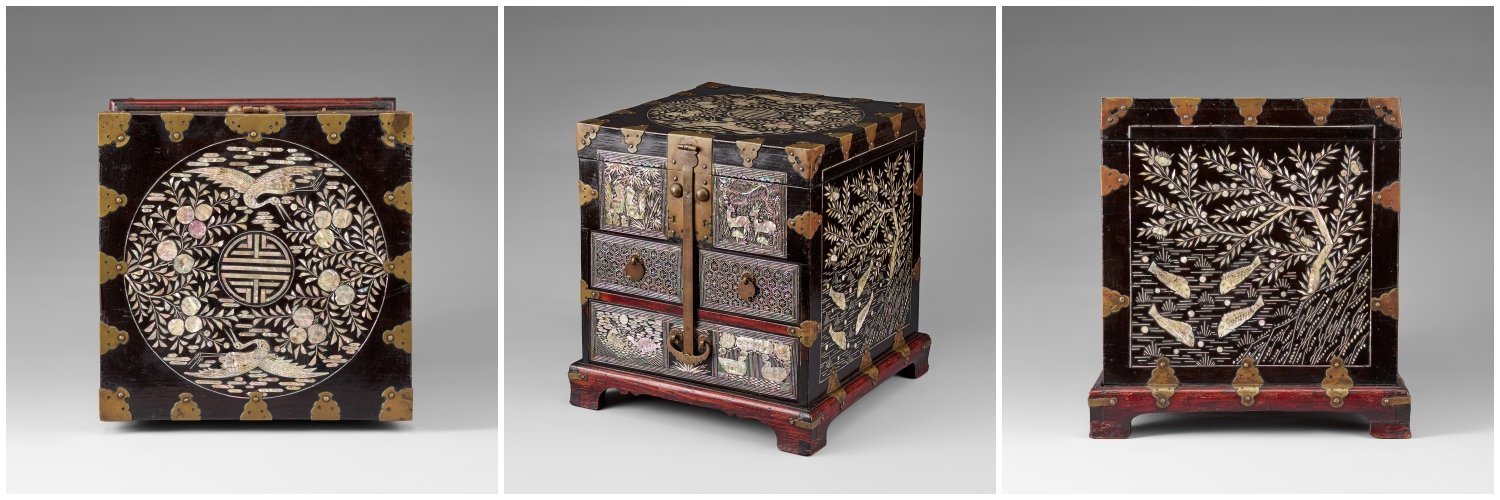Small original boxes are likely the most challenging pieces to come across in the Korean furniture market due to their historical association with the elite. These boxes are relatively rare, and they were used in both men’s and women’s quarters for various purposes. Among these boxes, the wedding box was the most common and could also be found among commoners. For more information on these boxes, you can refer to our special publication.: Korean wedding box
We have classified these different boxes according to their use and their place in the Korean home. The men’s & women’s quarters.
PRE JOSEON DYNASTY PIECES.
Some extremely ancient boxes have been excavated from burial sites, providing evidence of the existence of such objects in ancient times, notably during the Goryeo Dynasty (12th century). These artifacts are still held in various museums in the United States and Korea.

Goryo dynasty. H. 22,6cm, W. 41,9cm, D. 20cm. Collection National Museum of Korea. (Photos left & right)
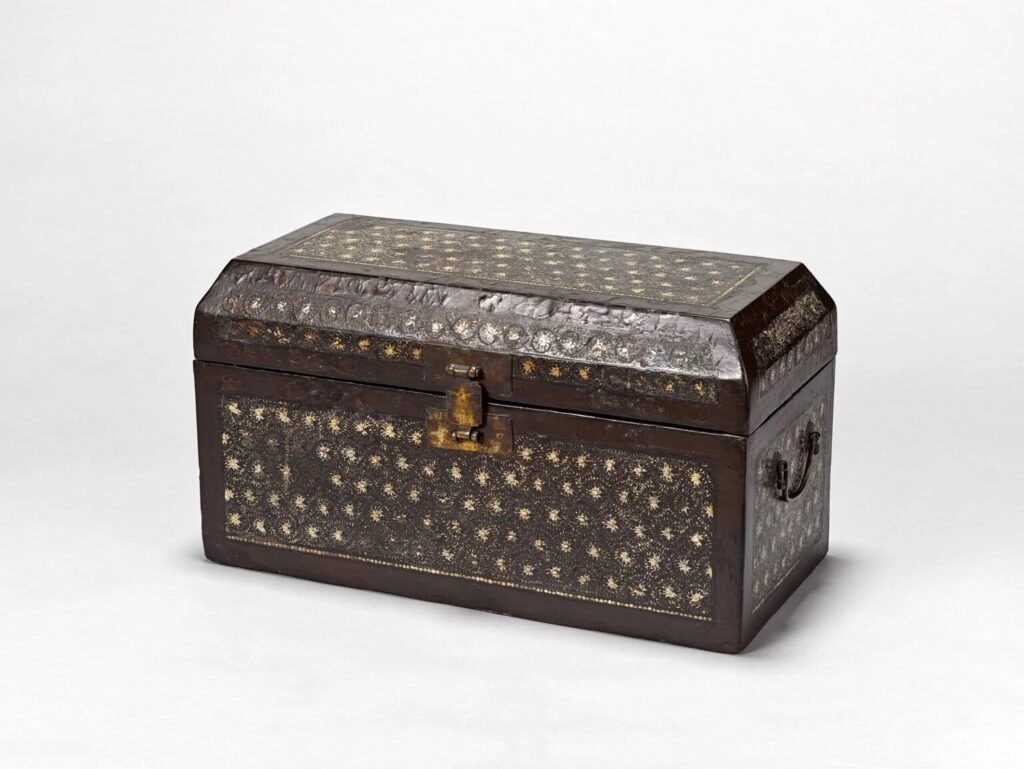
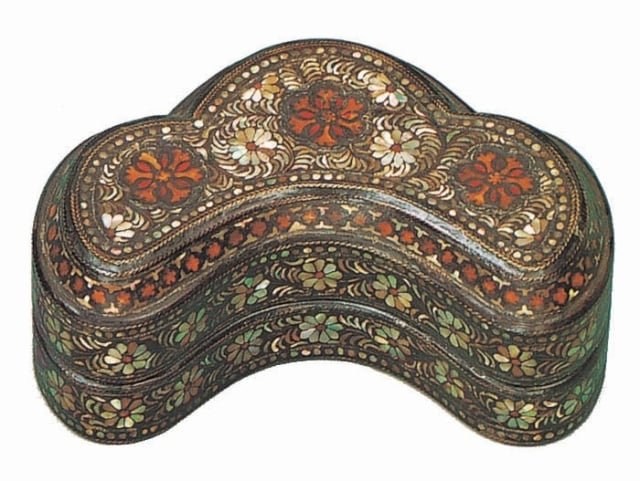
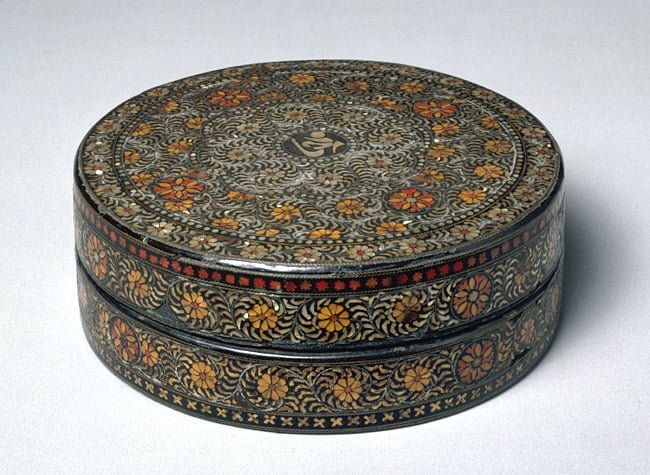
Goryeo dynasty – 12th century
H: 4,5cm, Diam.: 12,4cm.
Taima-dera Temple.

Collection National Museum of Korea.
BOXES FROM THE MEN’S QUARTER.
The boxes discovered in the men’s quarters primarily contained items used to store the scholar’s belongings, such as document boxes for holding inkstones, paintbrushes, and seals. These boxes often lacked excessive decoration, reflecting the simple and austere character of the Confucian tradition prevalent among Koreans during the Joseon period.
A special publication on scholar’s furniture is available on this site: The scholar’s chests.
DOCUMENT BOXES
Most of the time, these small boxes were employed for storing a variety of documents. The wood chosen for these boxes was often carefully selected, with options such as elm, zelkova, or burl, and they could also be covered with paper or ray skins.
Yellow brass, which was relatively expensive during that period, was commonly used for the fittings.
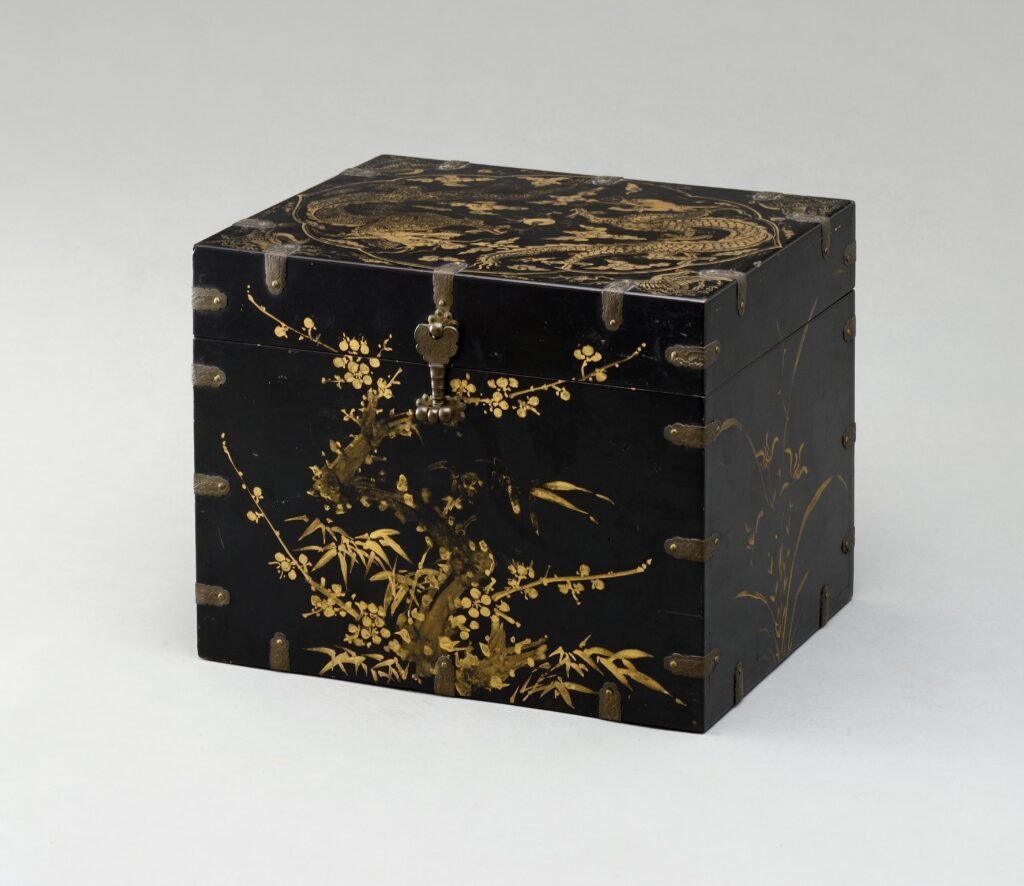


Collection: Yeoju Museum, Gyeonggi province.
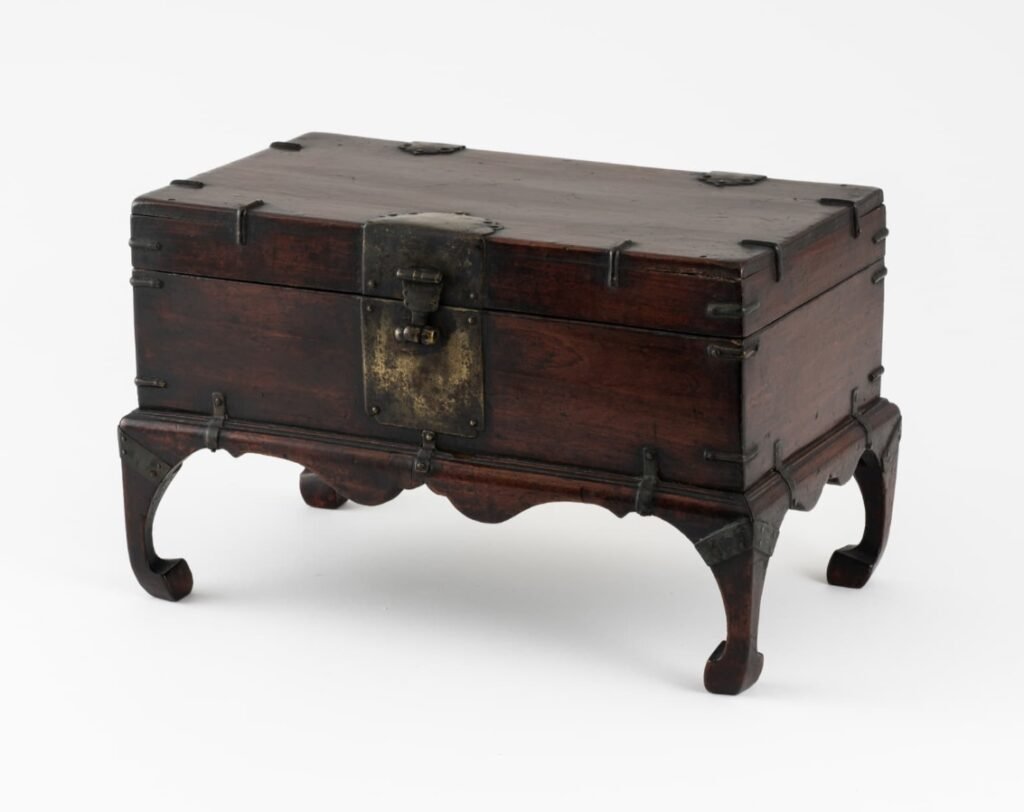
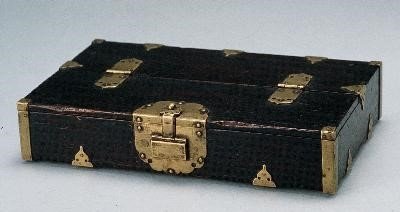
Collection National Museum of Korea.
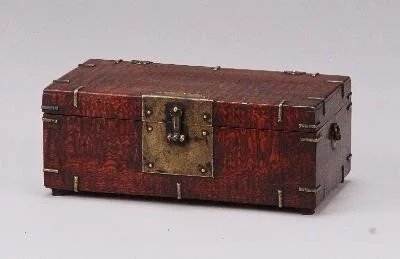
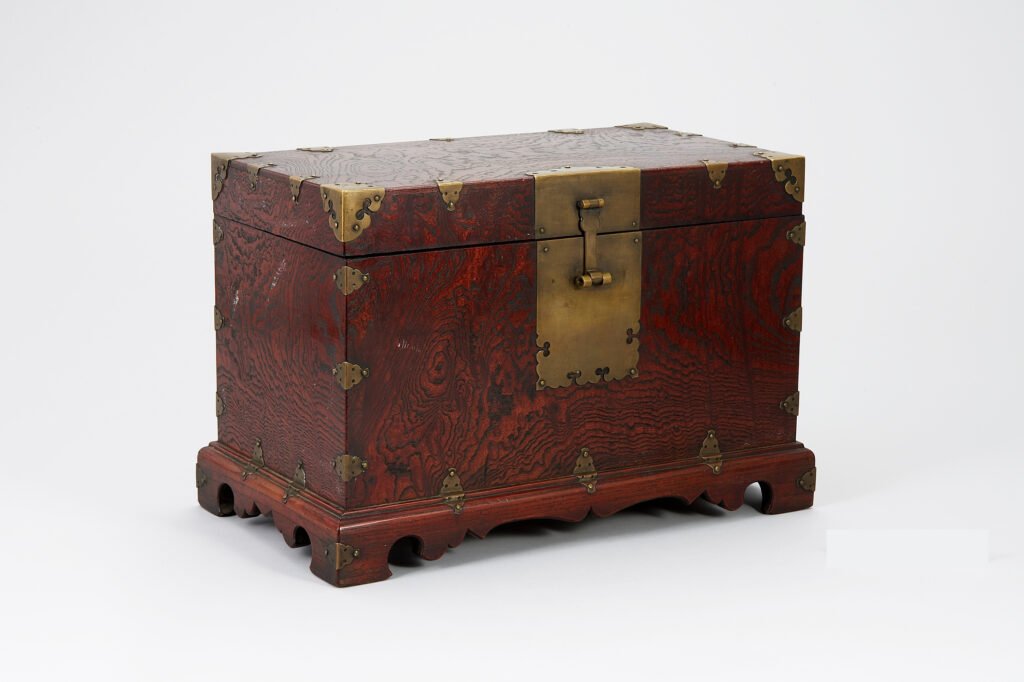
Late 19th century. H. 26,8cm, W. 40,3cm, D. 23cm.
Collection National Museum of Korea. Seoul.
(Photos left & right).



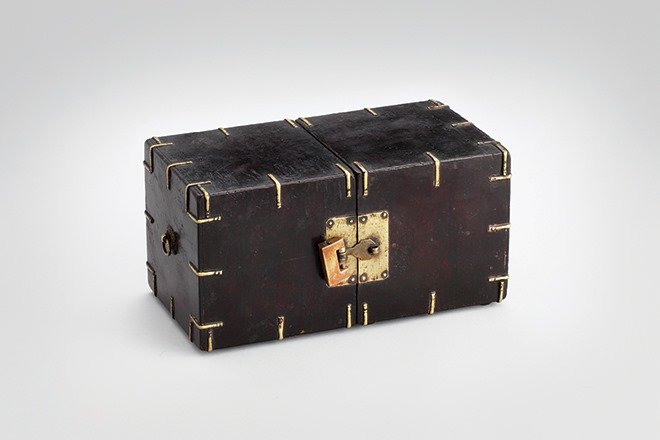
Collection of Leeum
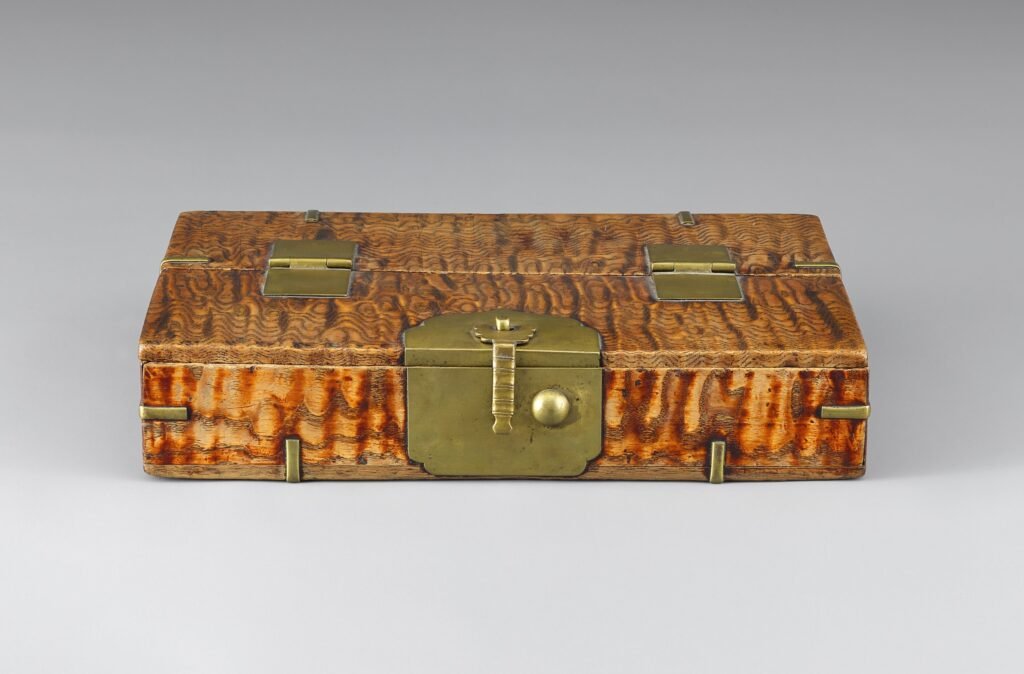
Collection National Museum of Korea.
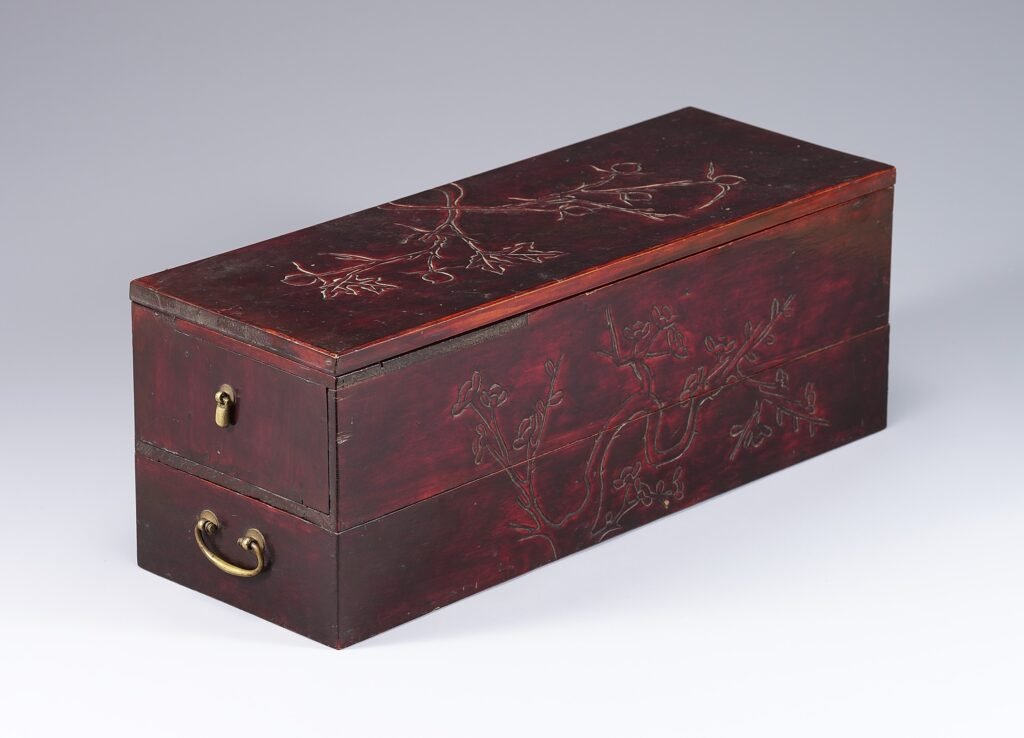
Joseon Dynasty. Collection National Museum of Korea.

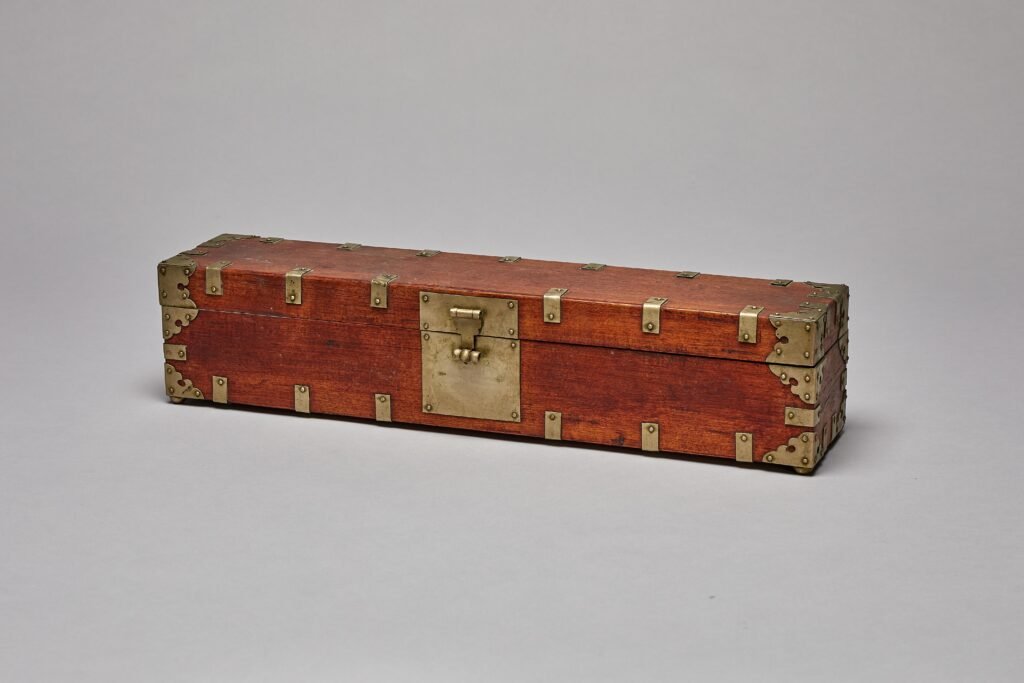
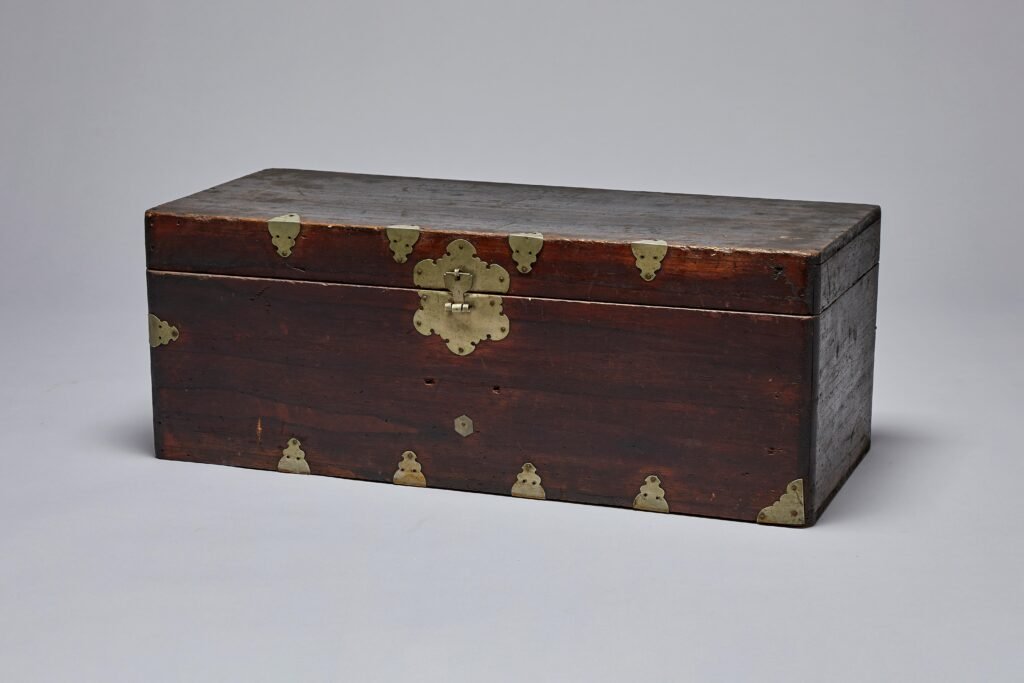
H. 25,3cm, W. 67,8cm, D. 24,9cm.
Collection: NAMGARAM MUSEUM. Jinju-si, Gyeongsangnam-do. Korea.

H. 30cm. W. 42cm, D. 43cm.
Collection: NAMGARAM MUSEUM. Jinju-si, Gyeongsangnam-do. Korea.
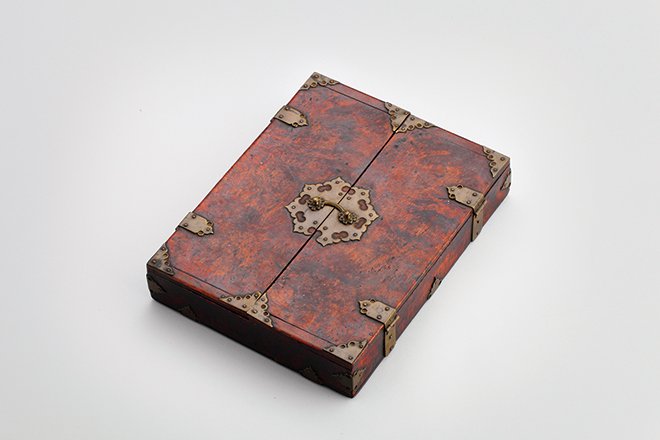
Collection of Leeum
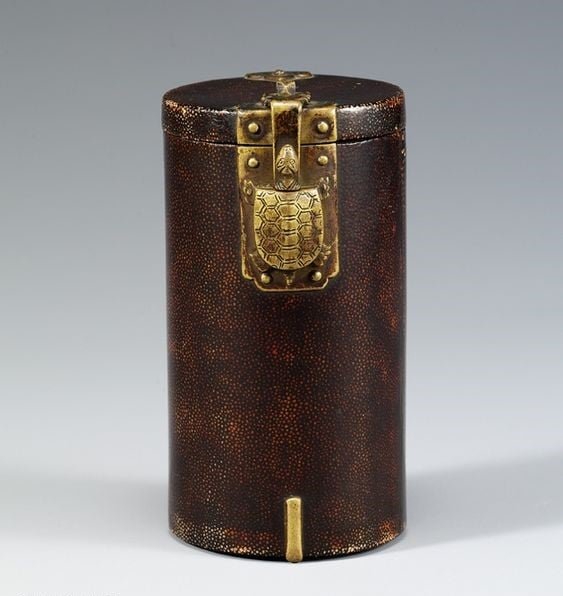
Small barrel for storage for rigid and shaped stuff such as hat, or rare and stationery items such as brush, letter and paper. This box is covered with stingray.

H. 21cm, W. 47 cm, D. 24cm
Late 19th Century.
Gyeonggi Province, Korea. Collection “ANTIKASIA”
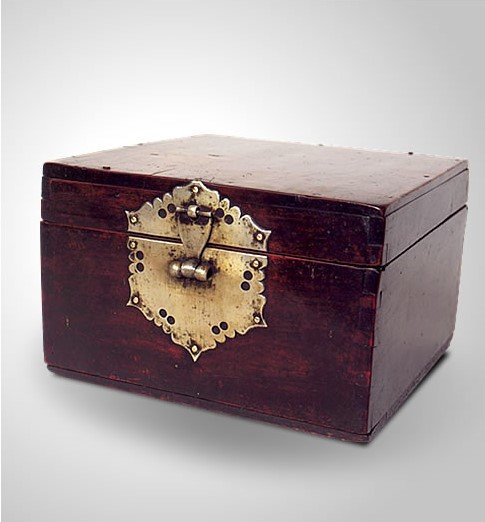
Gingko and Paulownia wood (bottom), white brass fittings.
H. 15 cm, W. 22 cm, D. 22 cm.. Mid 19th century.
Jeolla Province, Korea. Collection “ANTIKASIA”
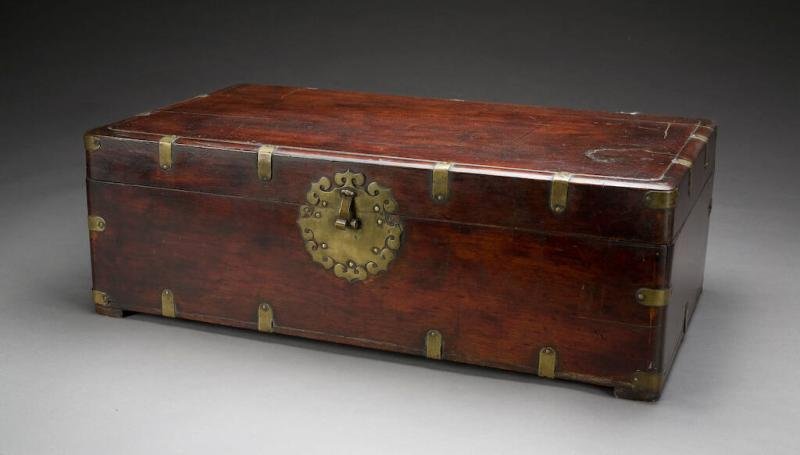

SEAL BOXES
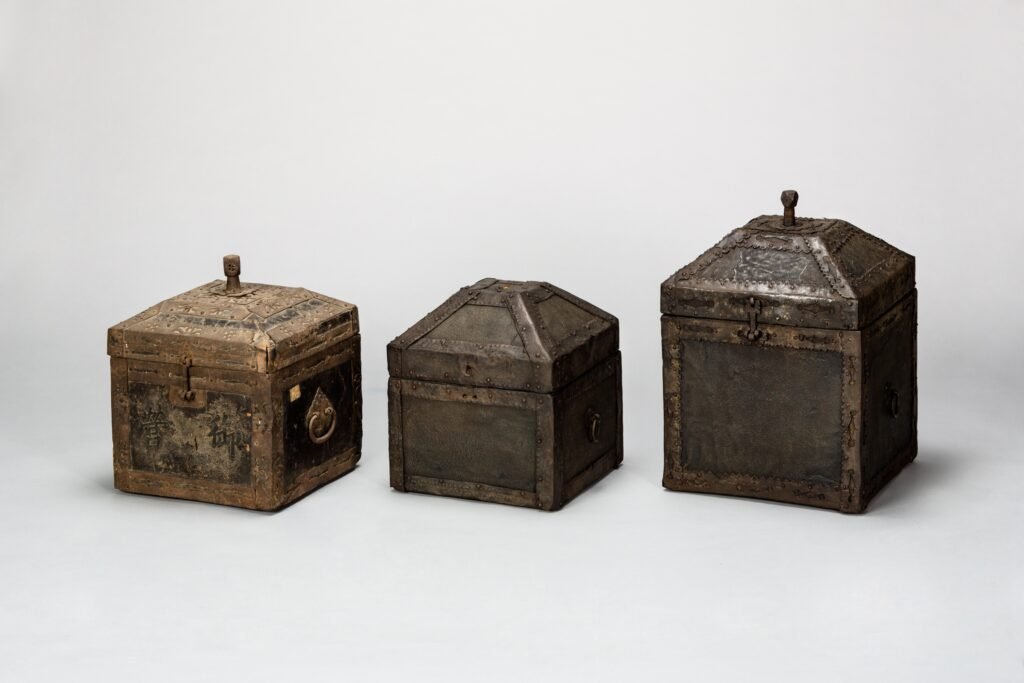
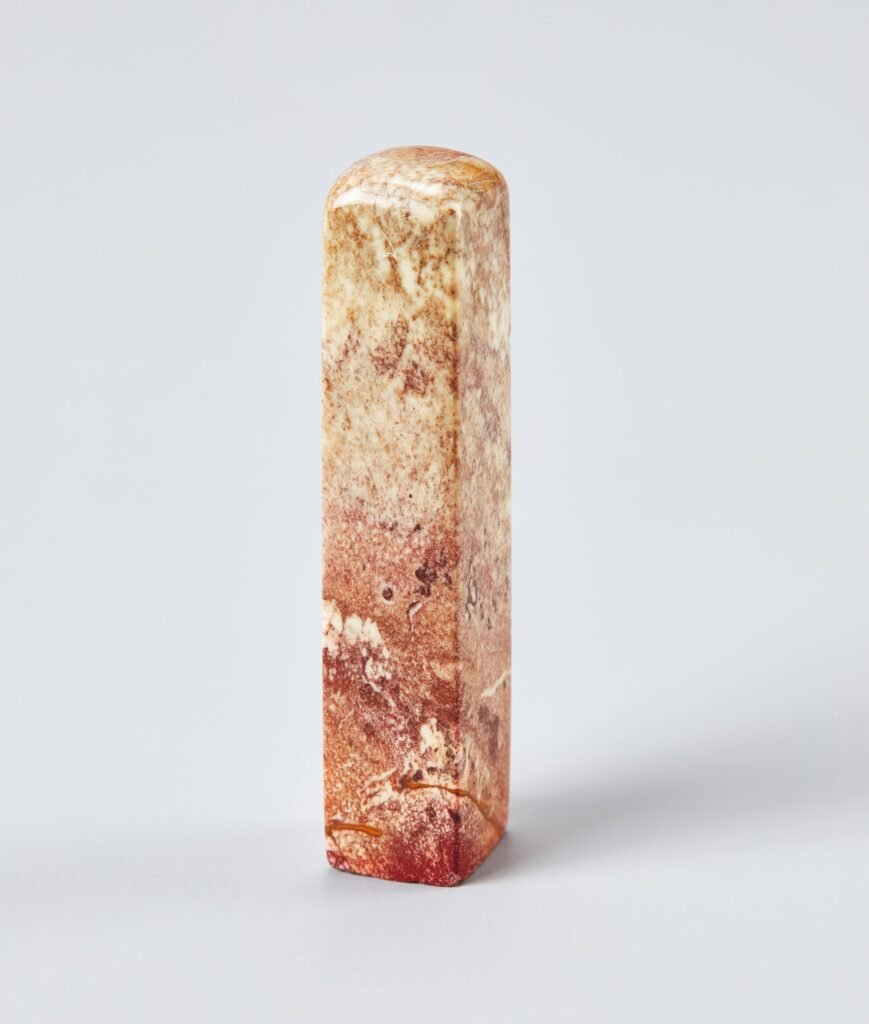
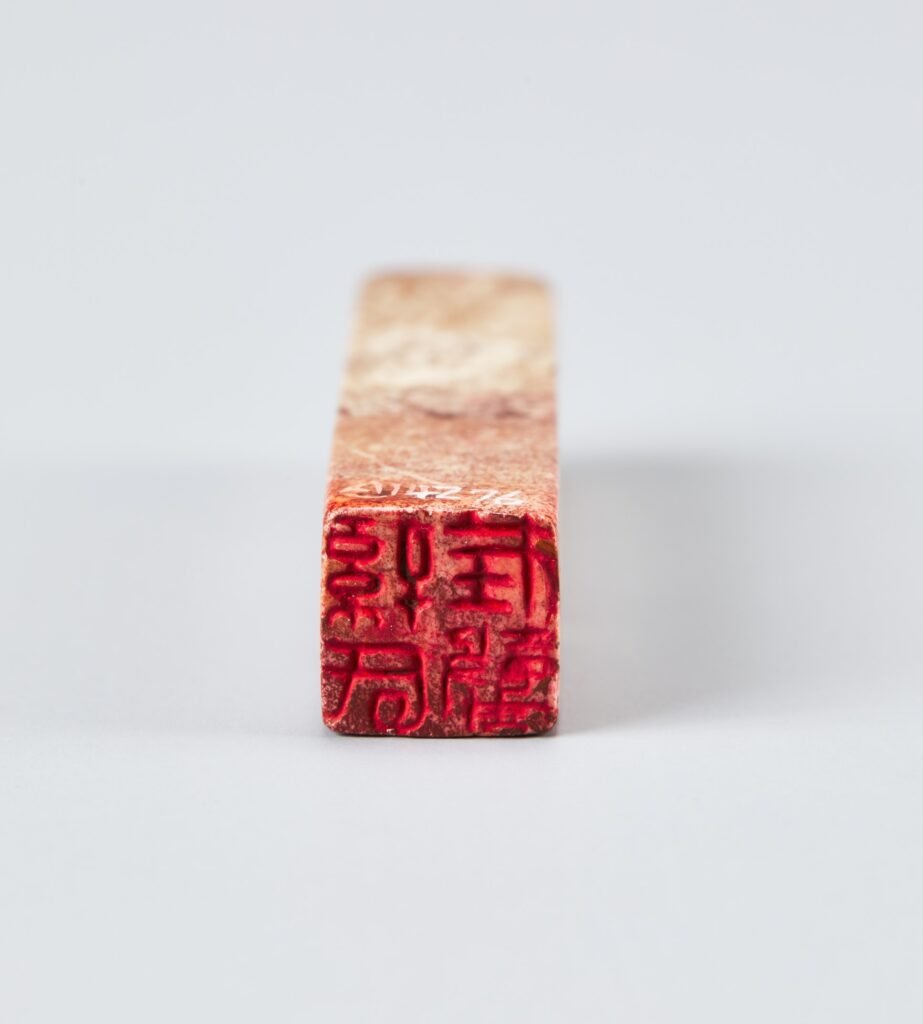
Collection National Museum of Korea.
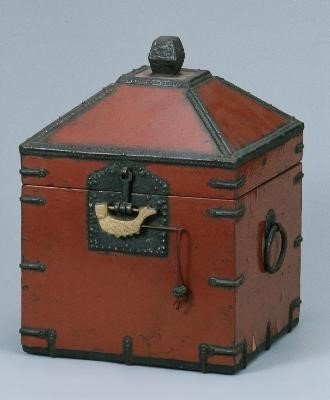
19th century.
H. 30cm, W. 31,3cm, D. 21,5cm.
Collection National Museum of Korea.

Late 19th to early 20th century. H. 27,8cm, W. 21,5cm, D. 21,5cm. Collection National Museum of Korea.

Private collection
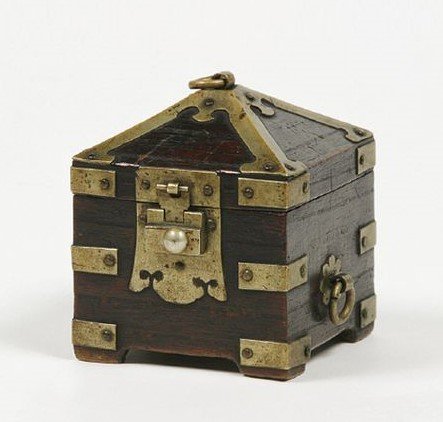

Collection: NAMGARAM MUSEUM. Jinju-si, Gyeongsangnam-do. Korea


Collection: Yeoju Museum. Gyeonggi province.

Collection: Busan provincial Museum. Korea.


SAFES OR MONEY BOXES – 갑게수리
Kap Kae Suri – 갑게수리 is a name that comes from the Japanese stationary furniture Kakesu- zuri (かけすずり), and was called by various names such as Jeongwe, Cheonanju, and Gakbi-shuri. During the Japanese colonial period, it was renamed Kap Kae Suri.
Adjacent to the coin it was referred to as a “Safe,” where nobles stored important documents or valuable items. These medium-sized safes measured approximately H. 50 to 60cm, W. 70cm, and D. 40cm and were constructed as cabinets with two front doors, providing access to a series of drawers within.
These safes typically featured a restrained design, with a structure reinforced by metal components, including corner plates, and a sizable lock plate in the center. They also included handles on the sides for ease of transportation.
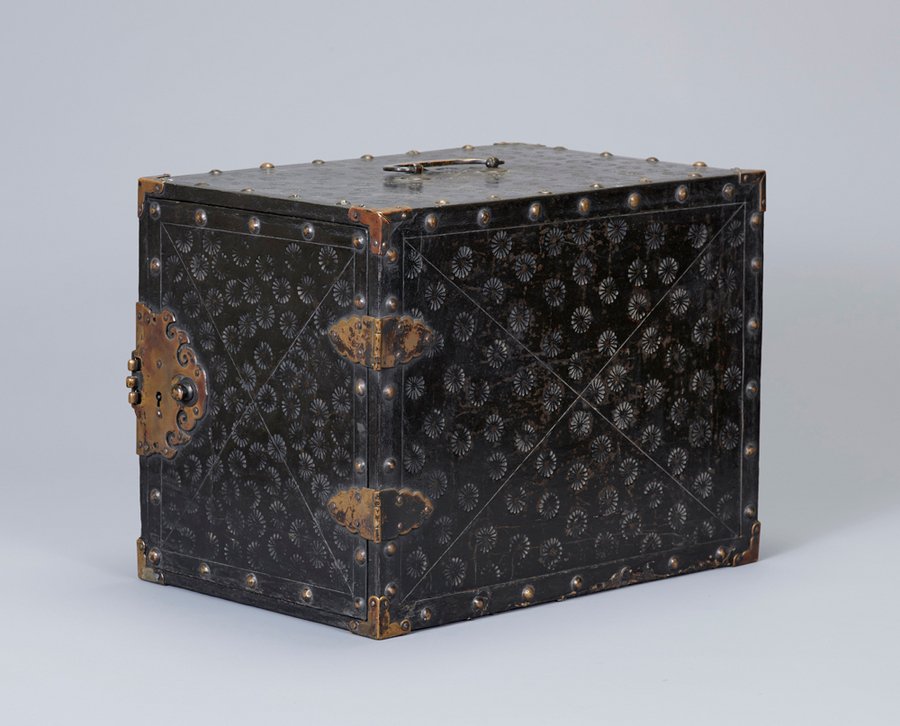
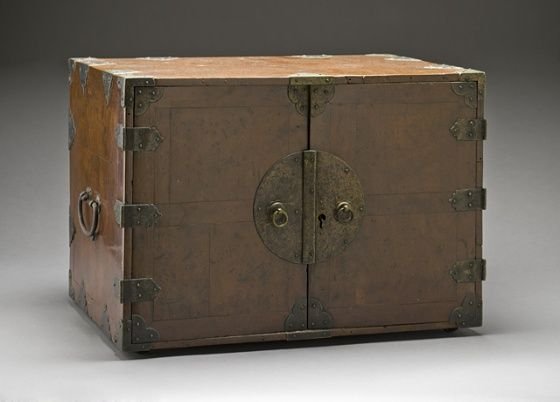
Joseon dynasty, 18th century.
Burlwood veneer on wood core with brass fittings and iron handles
17 3/4 x 24 x 16 1/4 in. (45.09 x 60.96 x 41.28 cm).
Collection: LACMA. Los Angeles County Museum of Art.
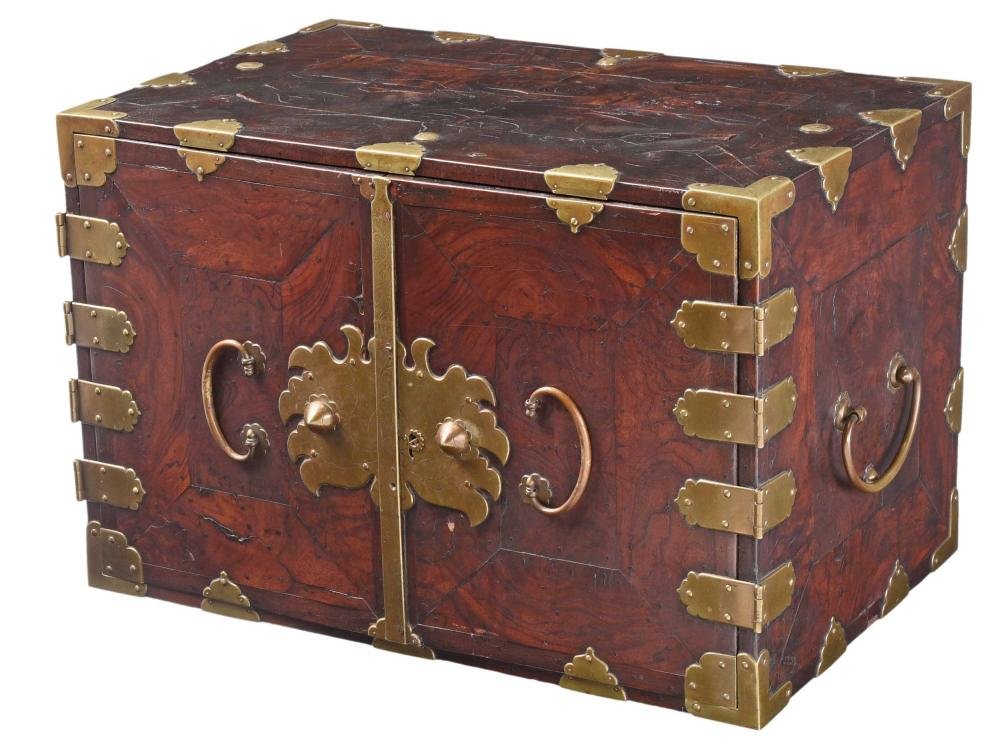
Joseon dynasty, yellow brass fittings, opening to nine interior drawers with felt lining,15 x 22-1/4 x 14-1/2 in. Sold at Auction.
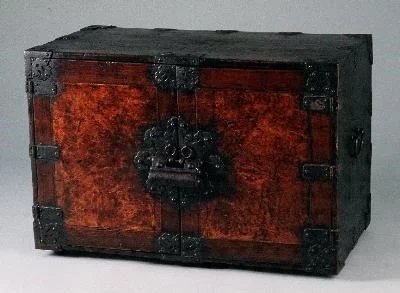
H. 49cm, W. 76cm, D. 42cm.
Collection National Museum of Korea.

H. 60,5cm, W. 67,5cm, D. 39cm.
Collection National Museum of Korea.
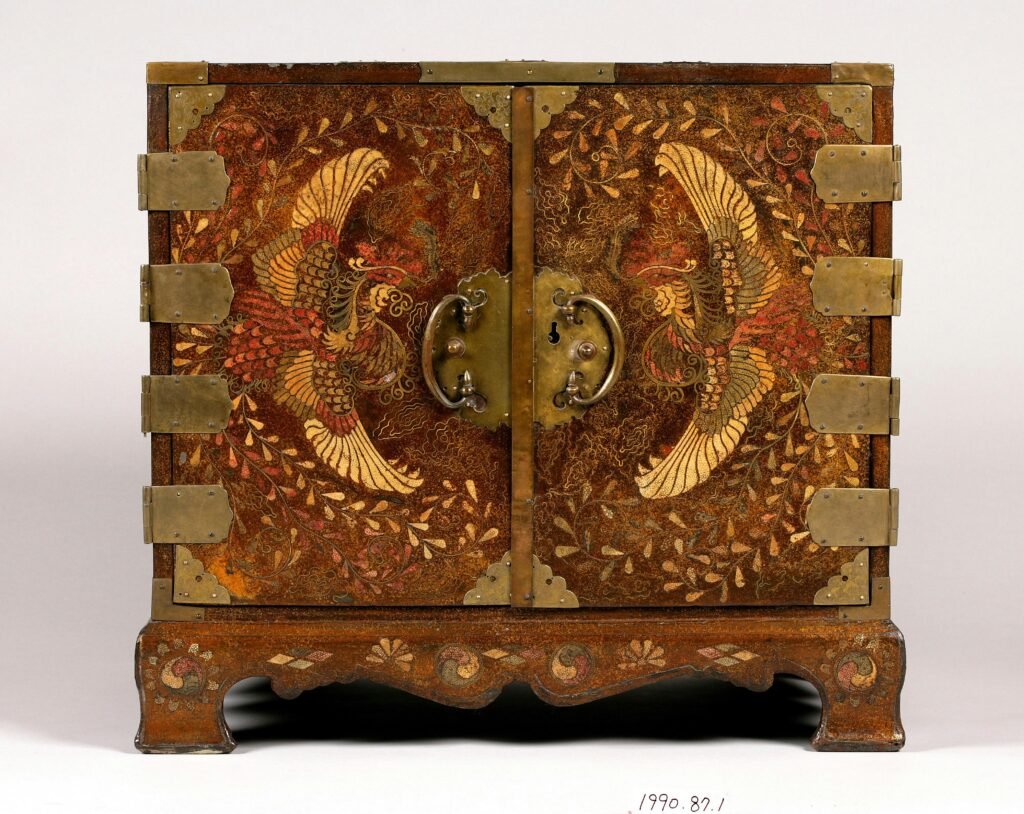
19th century. Lacquered wood with brass wire and dyed ray skin inlay; gilded metal fittings
H. 61cm, W. 66cm, D. 43,2 cm. Collection: Philadelphia Museum of Art. USA.
A kap-kae-suri is one of two types of Korean safes or treasure cabinets. Probably used in the women’s quarters (an’chae) of an upper class household, this elaborately decorated cabinet opens to reveal six drawers of differing sizes.

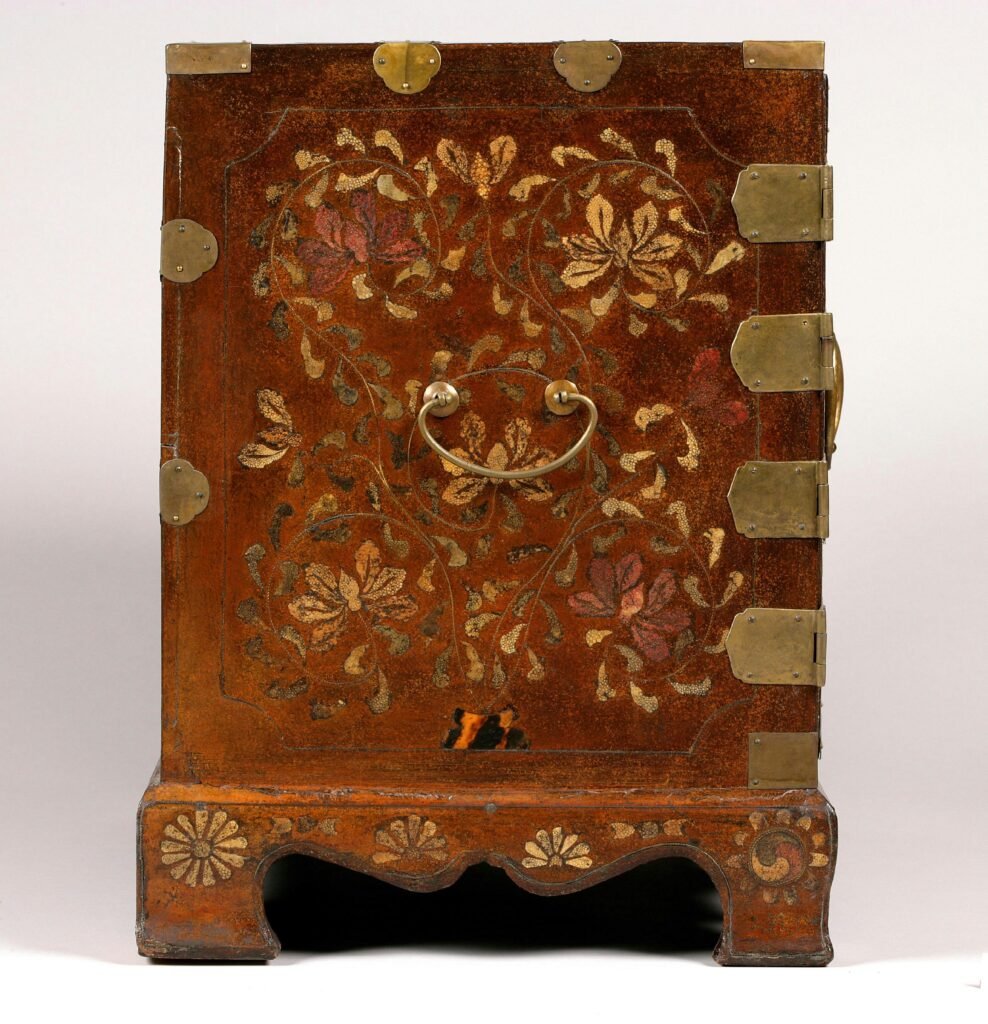
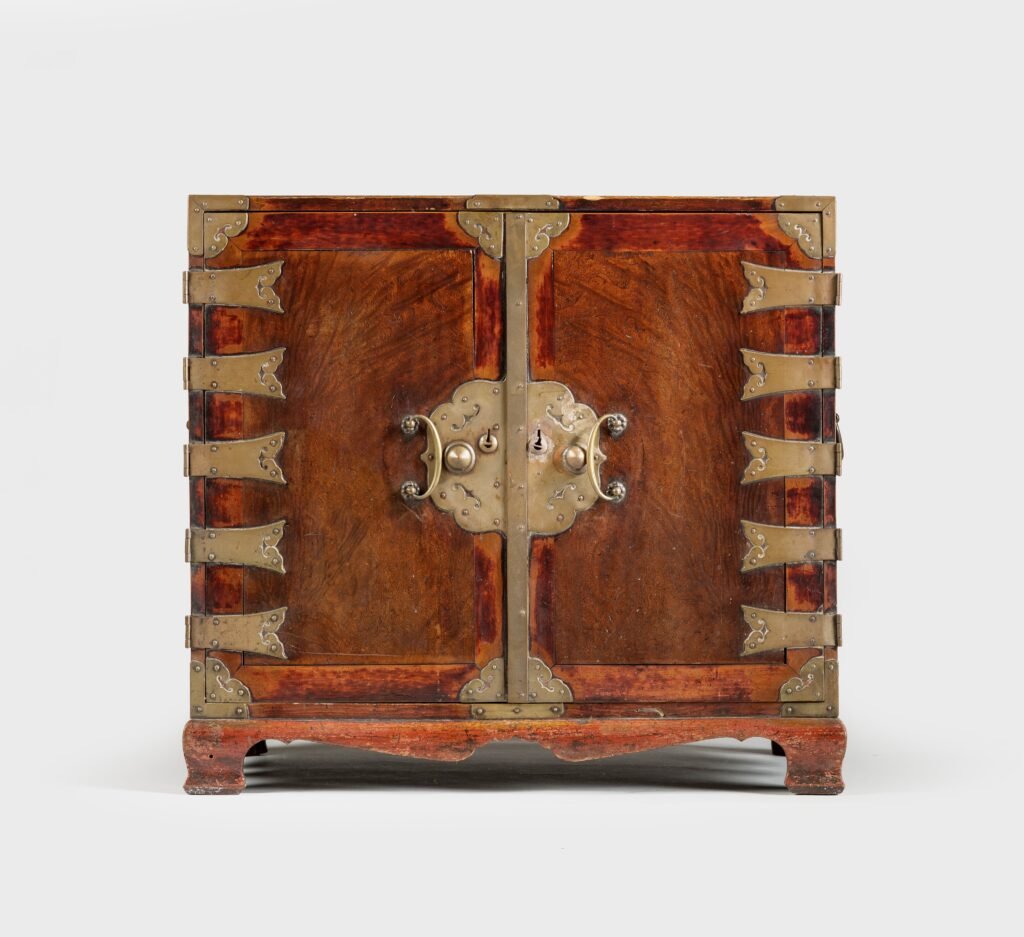
It was used as a kind of safe consisting of several drawers in a hinged door.
When you open the casement door, there are six drawers inside.
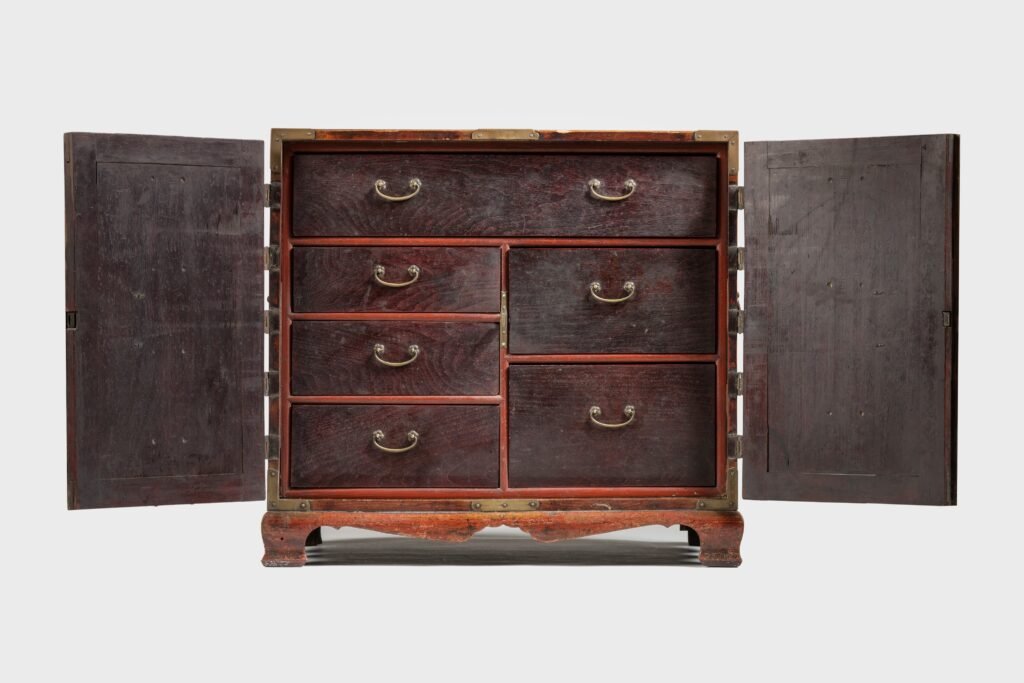
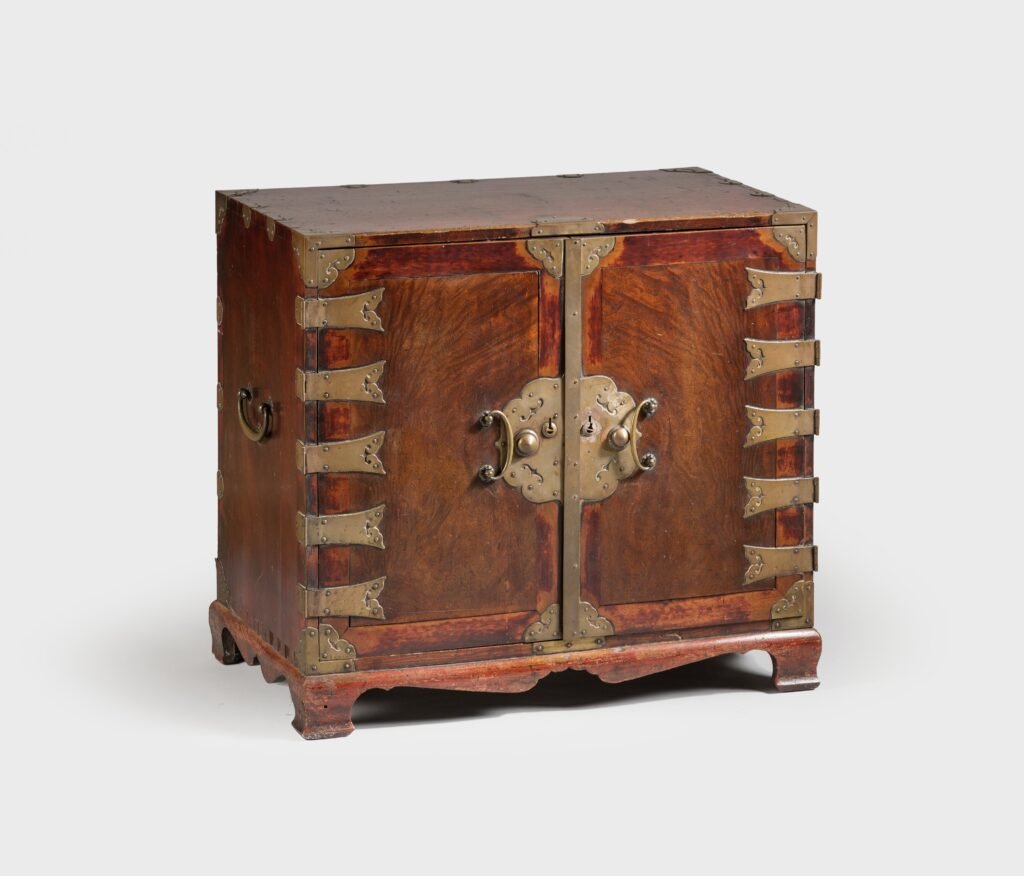

Collection: National Folk Museum, Seoul.
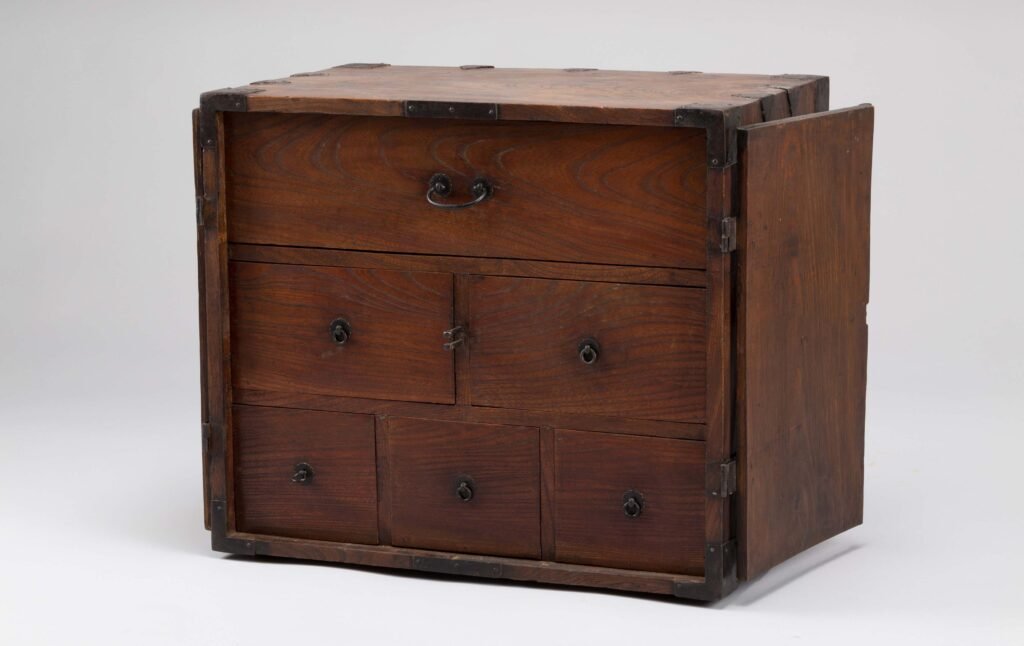

Collection: National Folk Museum, Seoul.

Seoul Museum of craft Art.



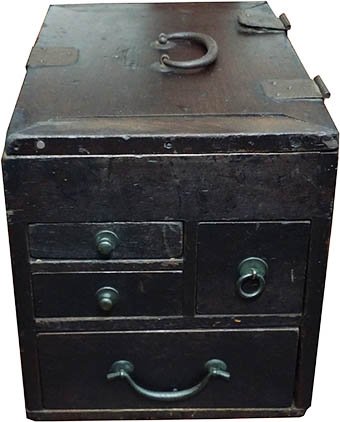
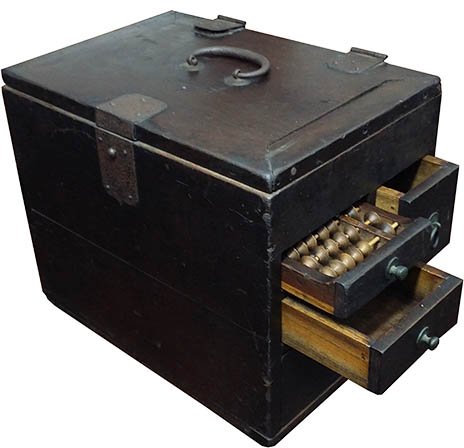
SMALL MEDICINE BOXES.

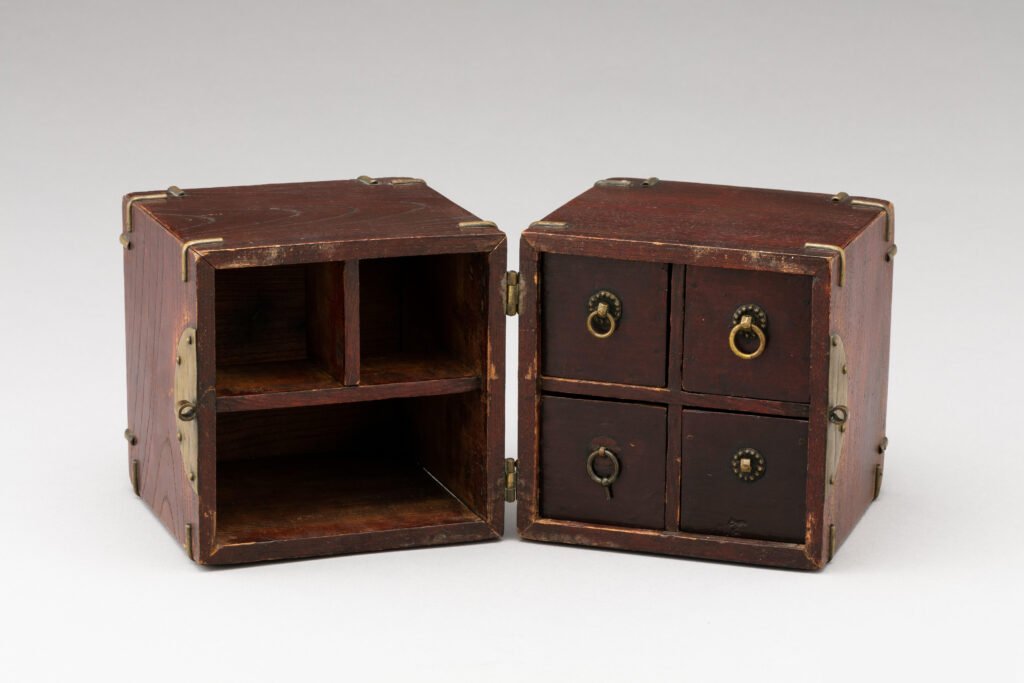
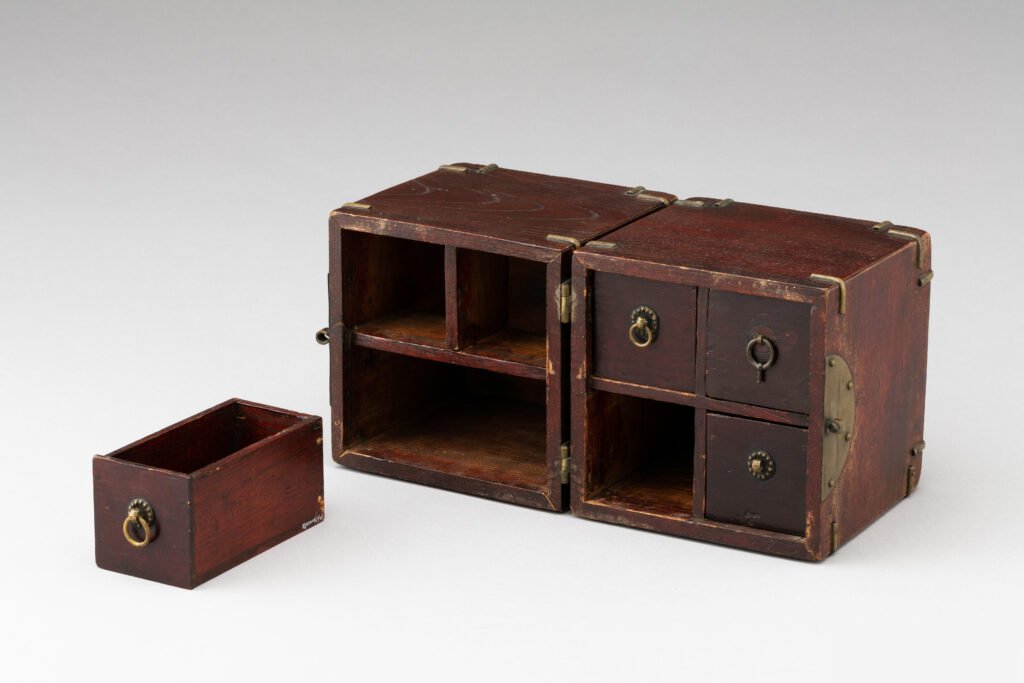

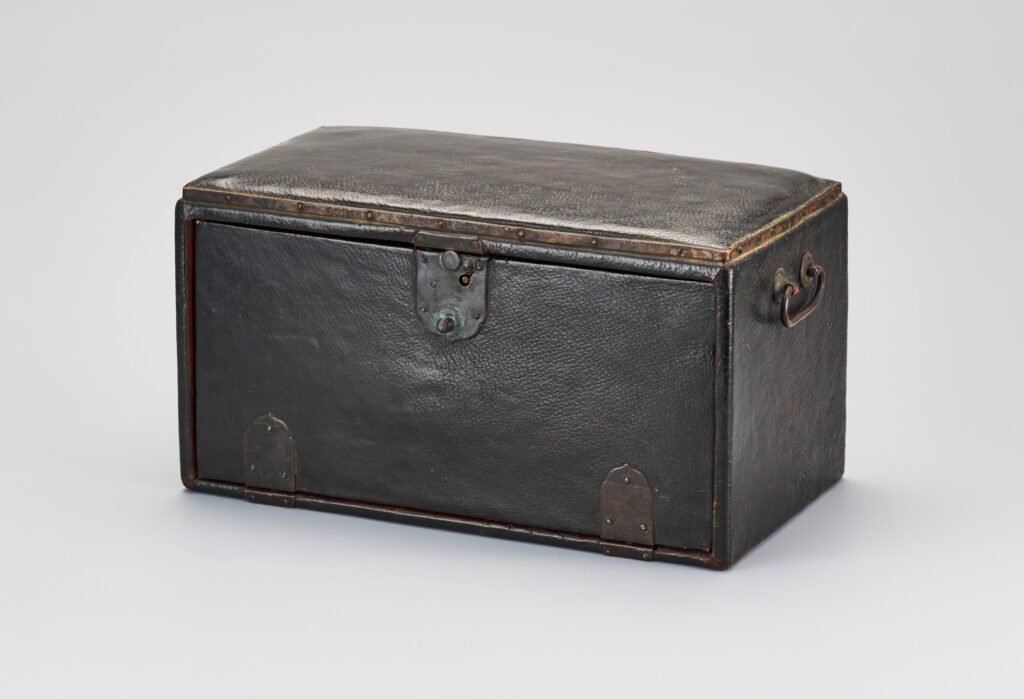

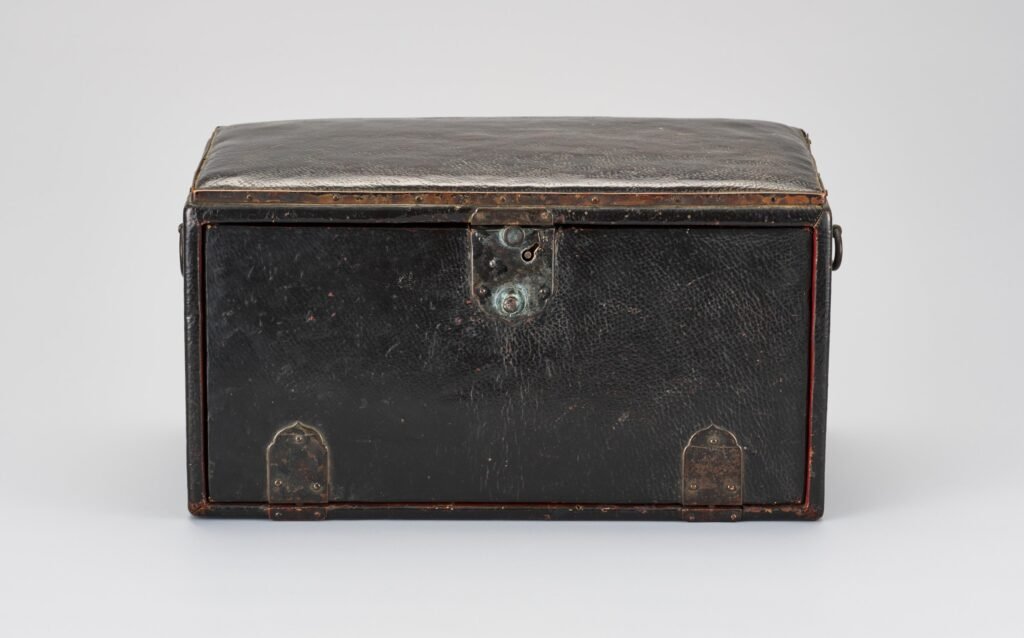
HAT BOXES 팔각함
A gat (Korean pronunciation: “Kat”) is a traditional Korean hat worn by men in conjunction with hanbok (Korean traditional clothing) during the Joseon period. It is typically crafted from horsehair and features a bamboo frame, making it partially transparent.
Most gat hats are cylindrical in shape with a wide brim supported by a bamboo frame. Until the late 19th century, only men of noble class were permitted to wear gat, as it symbolized their social status and served to protect their topknots.
Interesting Link : Gat
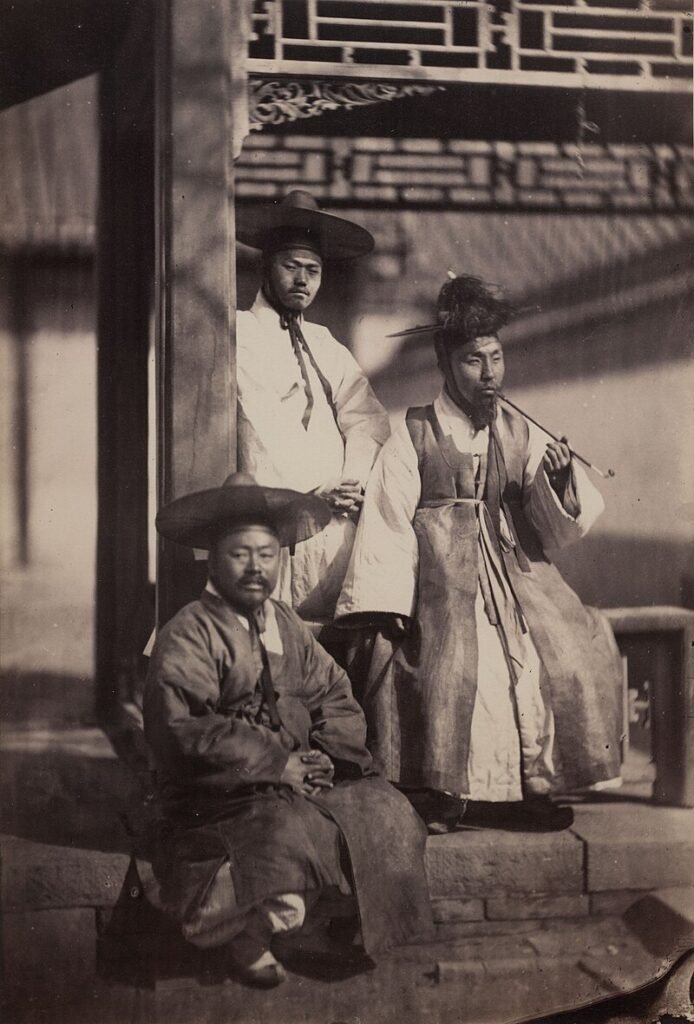
1861 – 1864.
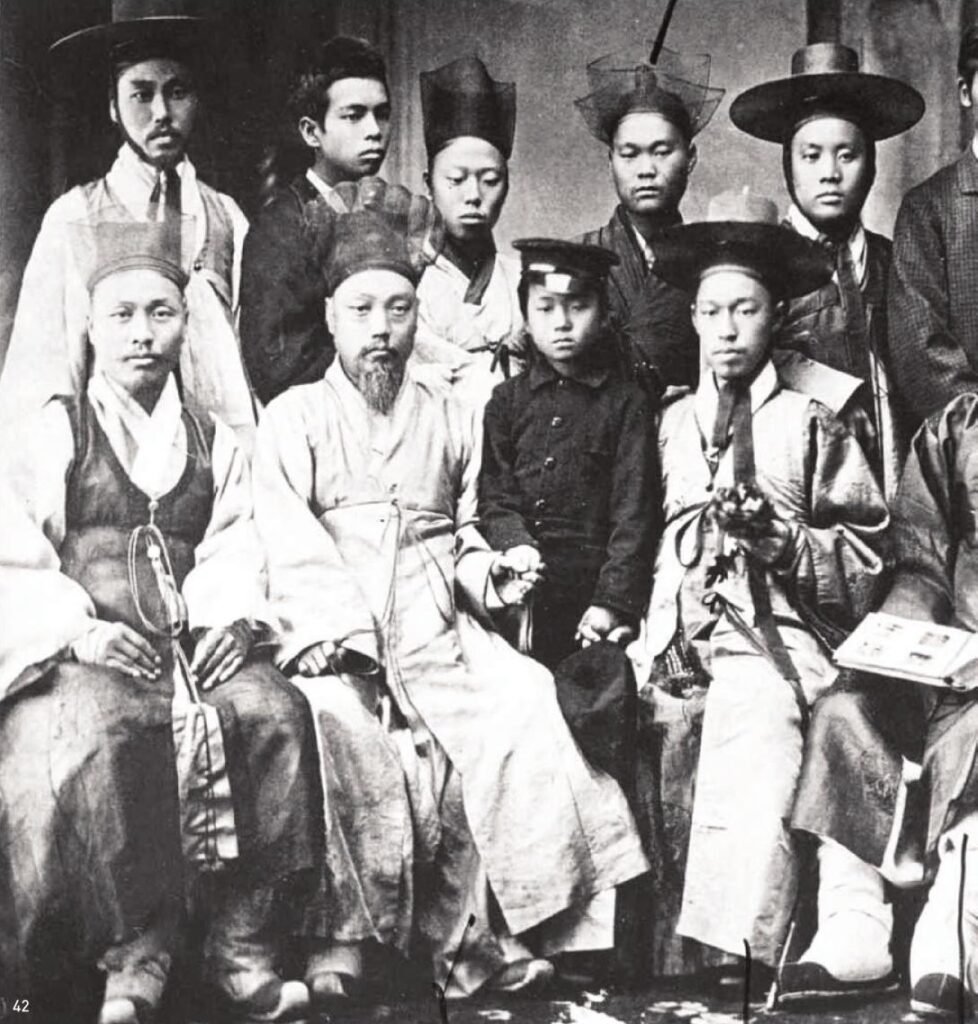
Hat boxes, also known as “Gatjip ham” in Korean, can be categorized into two main types. One type features an integrated base (the part where the hat is placed) and cover, typically constructed by forming a skeletal structure with a cylindrical shape at the lower part and a conical shape at the upper part. Paper and oil are then applied to it. The bottom side is divided into halves to facilitate opening and closing for inserting the hat, and a string is attached to the top for hanging.
The other type is a box-like container with a separate lid, typically made from wood or multiple layers of paper. Resembling a cap, the cover consists of an outer aspect and a headpiece (hat) part, and the base can take various shapes such as circular, square, octagonal, or dodecagonal.
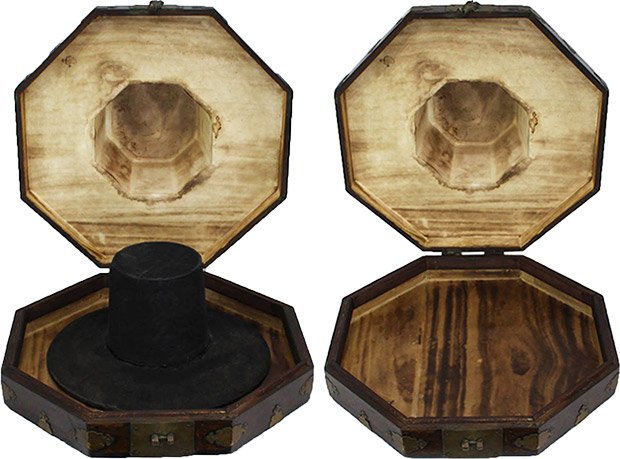
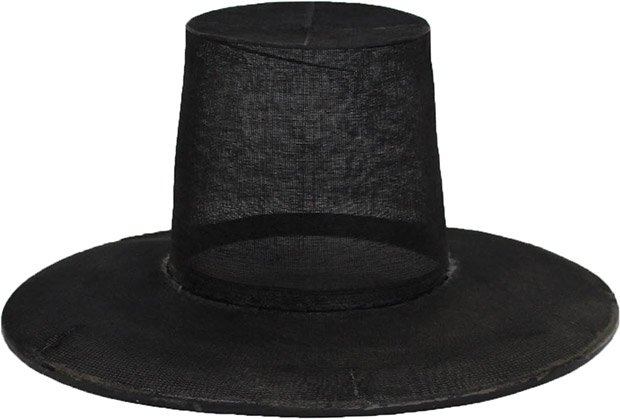
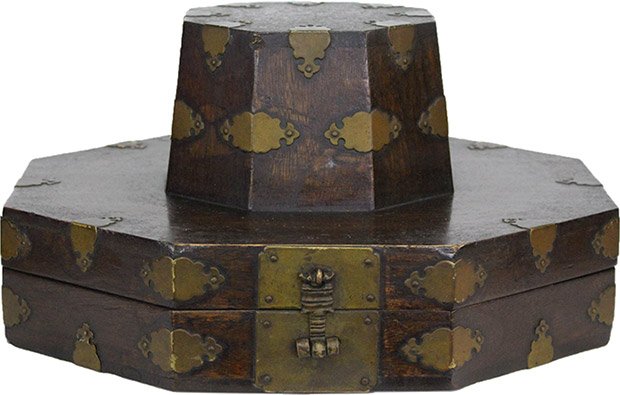
(4 photos)

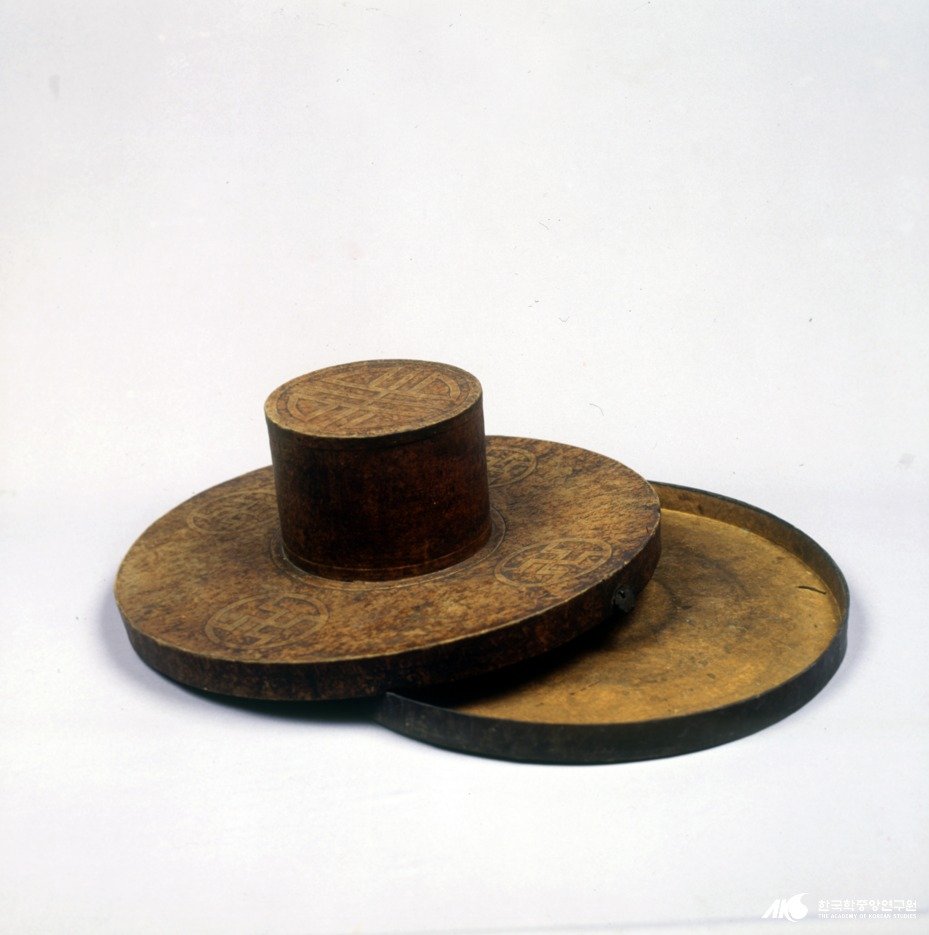
(Seok Ju-seon, Bo Jin-jae, 1978)

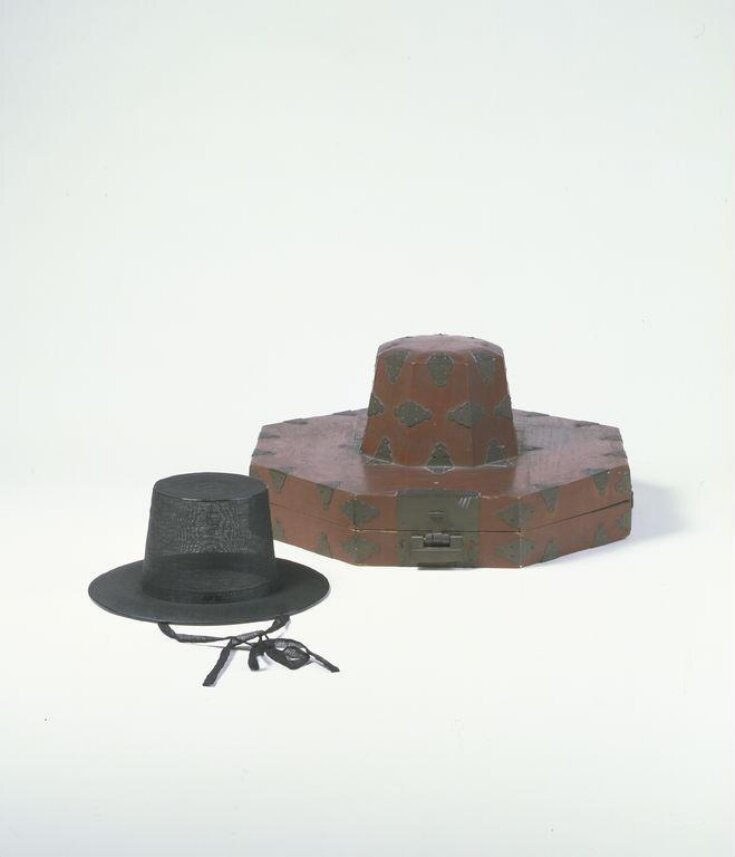
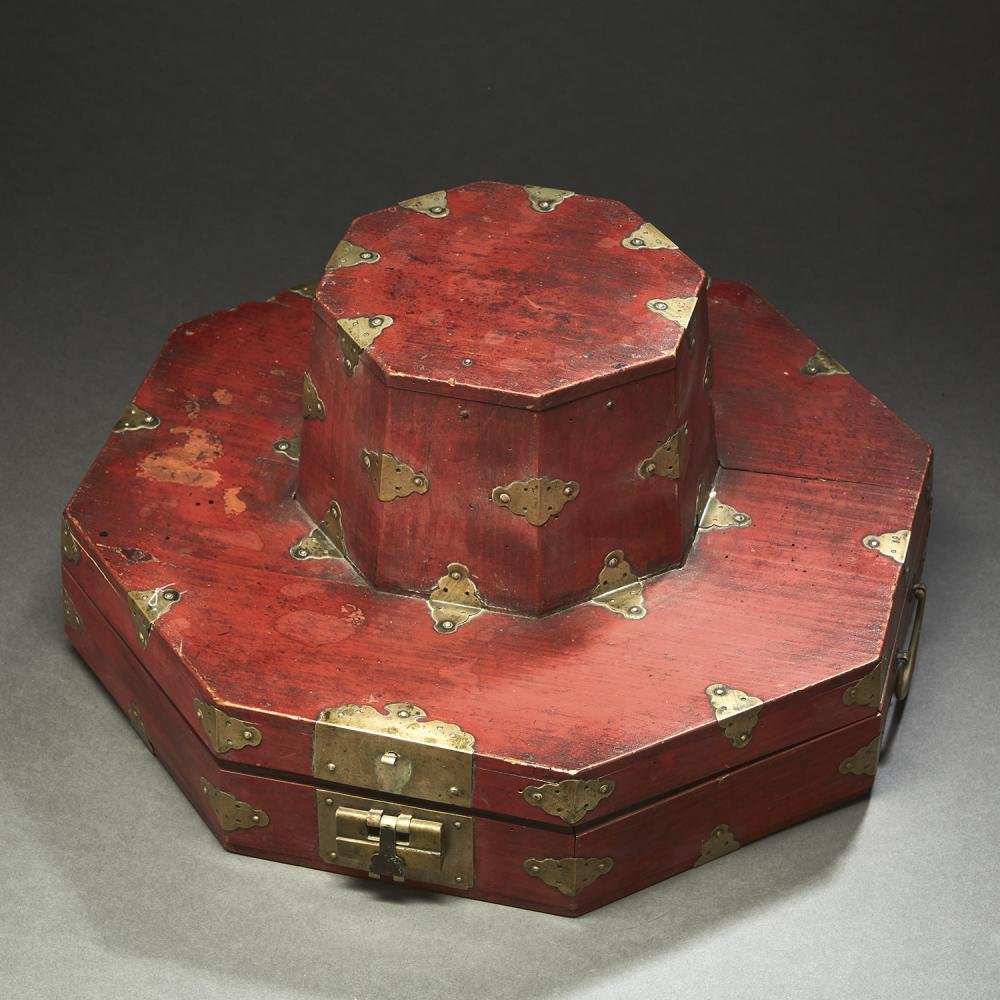
Paris France. September 30, 2022.

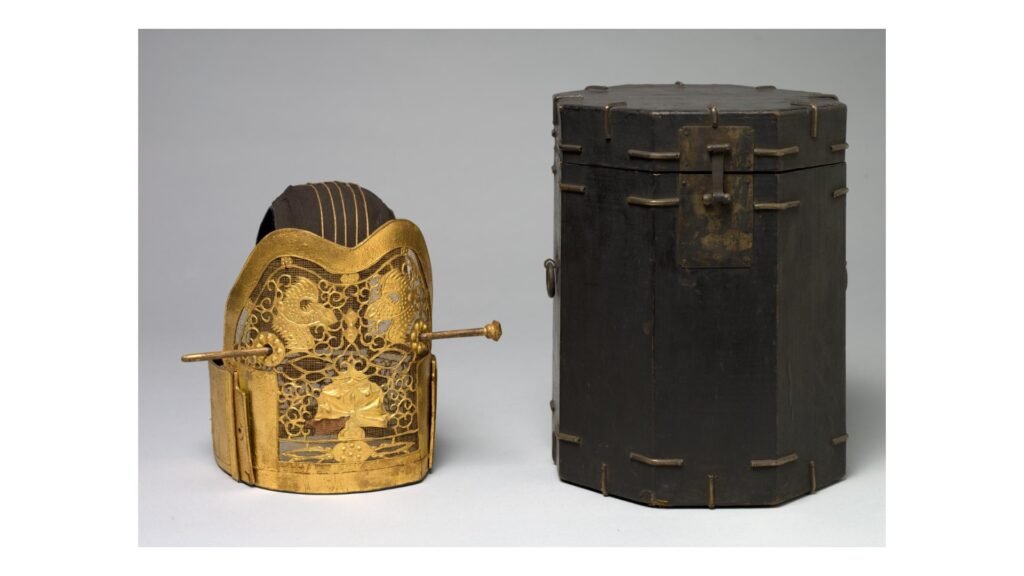
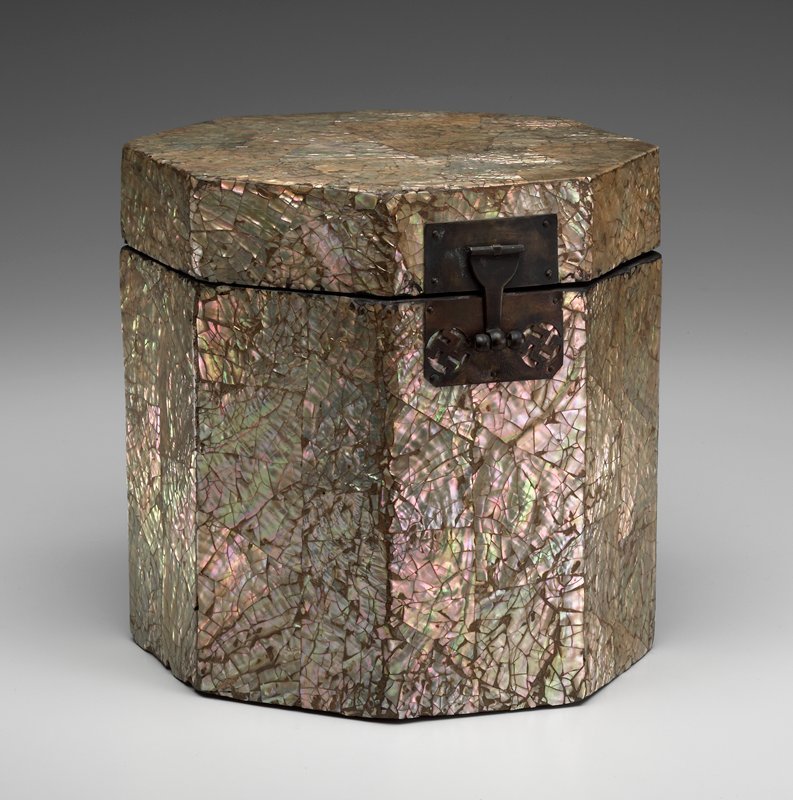
This hat box, entirely encrusted with pieces of abalone shell, was used to store a man’s inner hat, or “tanggeon“. Korean craftspeople used a special technique to create such objects. First a wooden box was coated with several layers of lacquer, onto which pieces of abalone shell were affixed. They then continued to coat the box with lacquer until the shell was completely covered. After the lacquer dried, they laboriously polished the surface with charcoal until the iridescent shell was revealed. Typical of Korean style, the mother-of-pearl is broken and reassembled in the manner seen here.
Collection: MIA. The Minneapolis Institute of Art. USA.
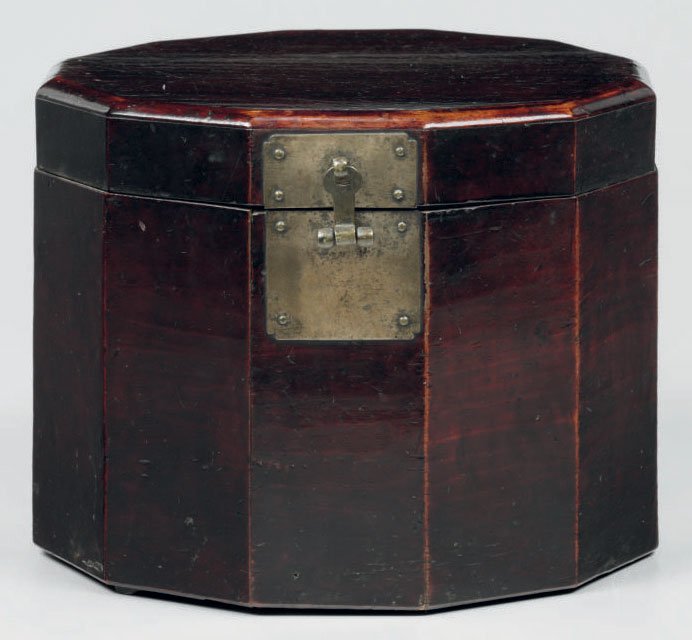
Joseon dynasty (late 19th century)
Made to contain a gentleman’s hat, fitted with a brass hinge-lock on rectangular lock plate and with back hinge and plate, the wood finished a deep, reddish-brown with gloss varnish; the interior wood unpolished. (20.5cm.) high: (26.2cm.) diameter.


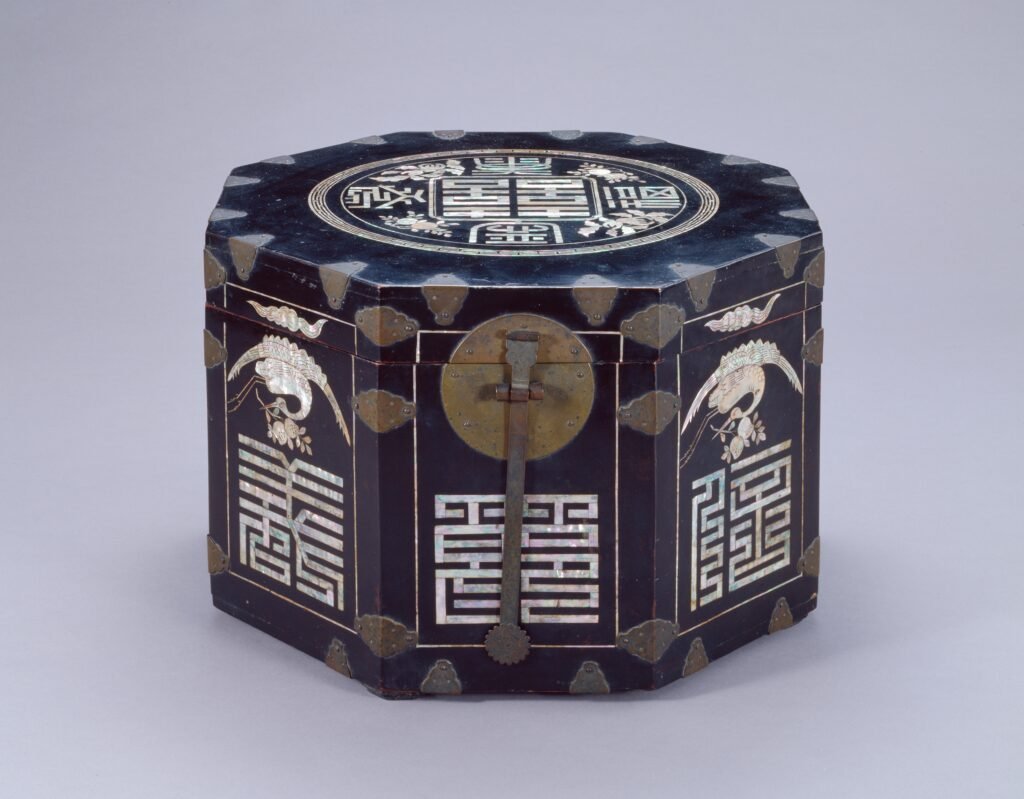
Collection National Museum of Korea.
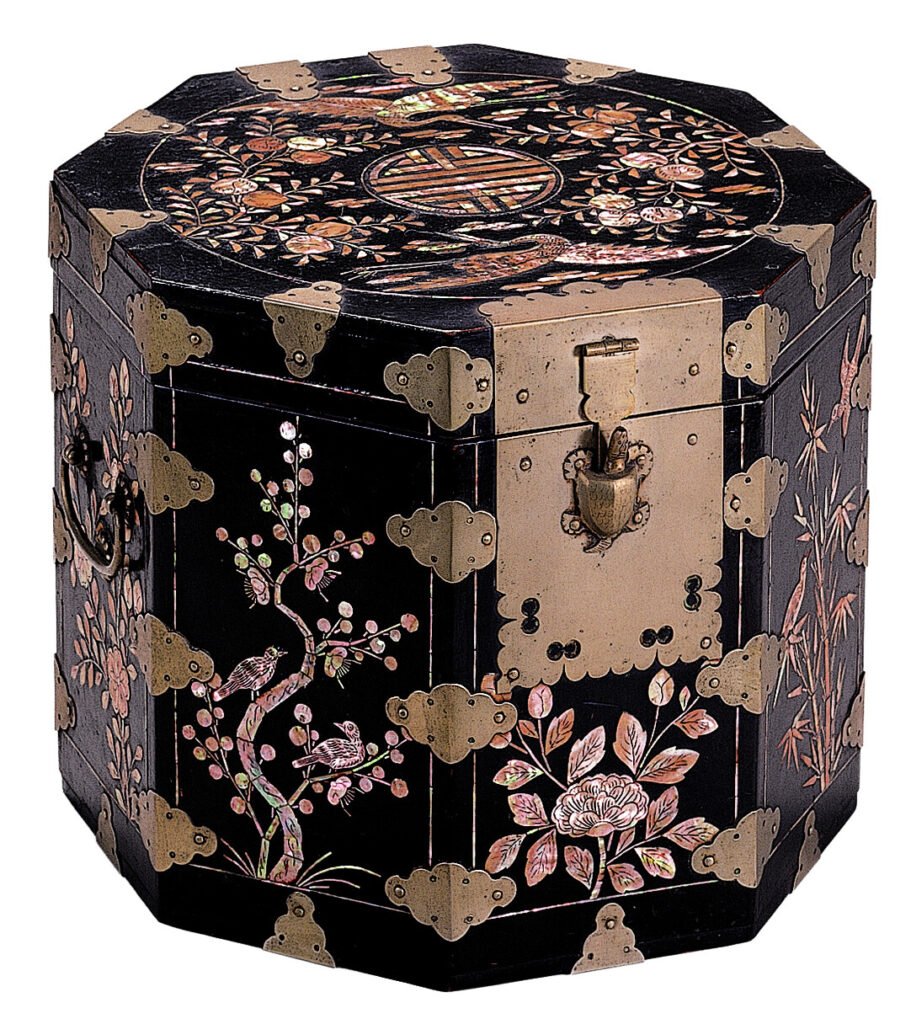
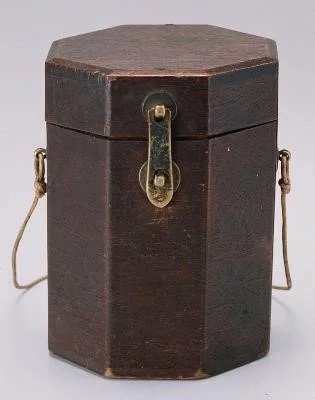
H. 12,5cm, bottom diameter 9cm.
Collection National Museum of Korea.
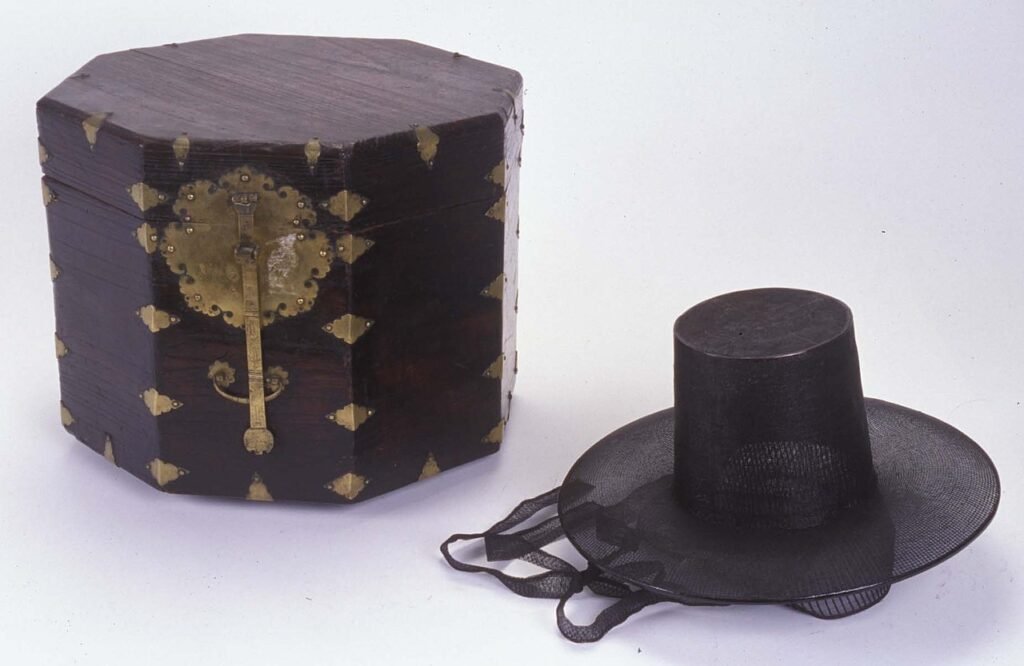

White brass fittings. H. 28cm, W. 32cm D. 33cm.
Collection: NAMGARAM MUSEUM. Jinju-si, Gyeongsangnam-do. Korea

Collection: NAMGARAM MUSEUM. Jinju-si, Gyeongsangnam-do. Korea
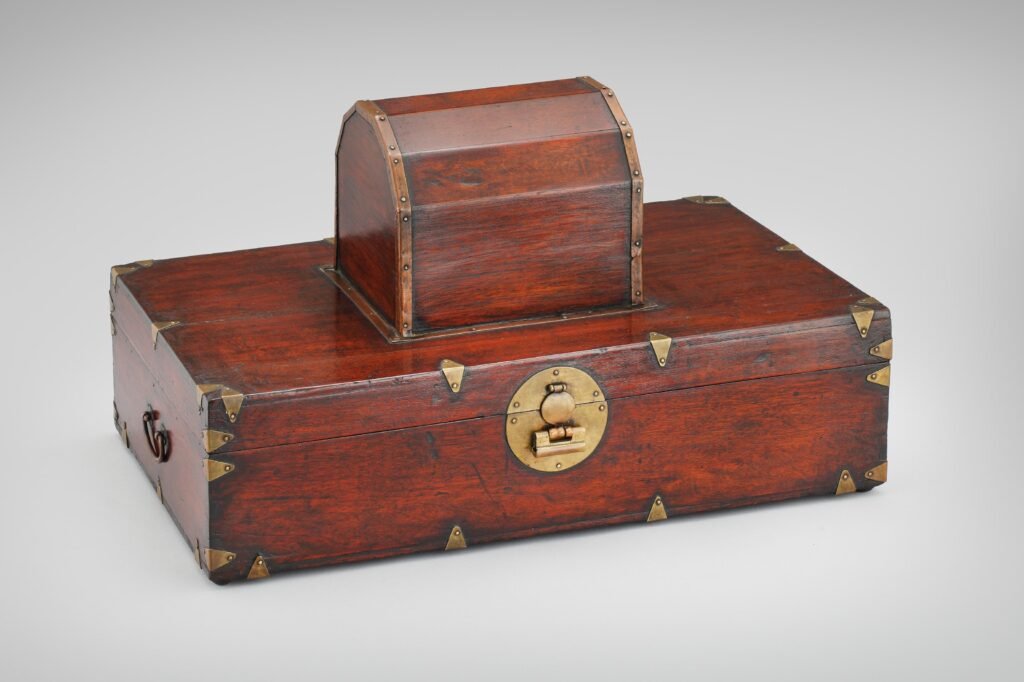

A box to store official caps, crowns, and official uniforms. Collection: National Folk Museum, Seoul.



TOBACCO BOXES
Smoking gained popularity during the late Joseon period, leading to the production of small boxes like these iron examples with silver inlay designed to hold tobacco leaves. Besides featuring bird-and-flower imagery, these boxes share many motifs with those found on lacquerware.
For more information on Korean metalwork, you may refer to the following source: Metal inlay, an old Korean craft

Iron inlaid with silver; brass fittings.
H. 2 1/2 in. (6.4 cm); W. 4 1/8 in. (10.5 cm); D. 2 7/8 in. (7.3 cm).
Collection: The MET. 1000 Fifth Avenue, New York, NY. USA
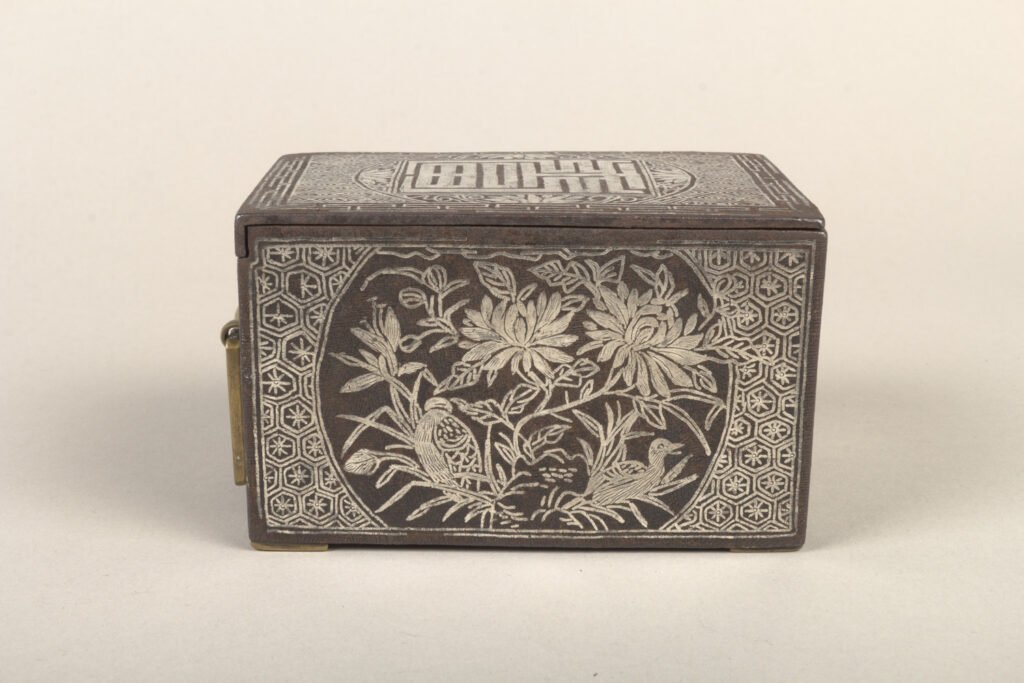
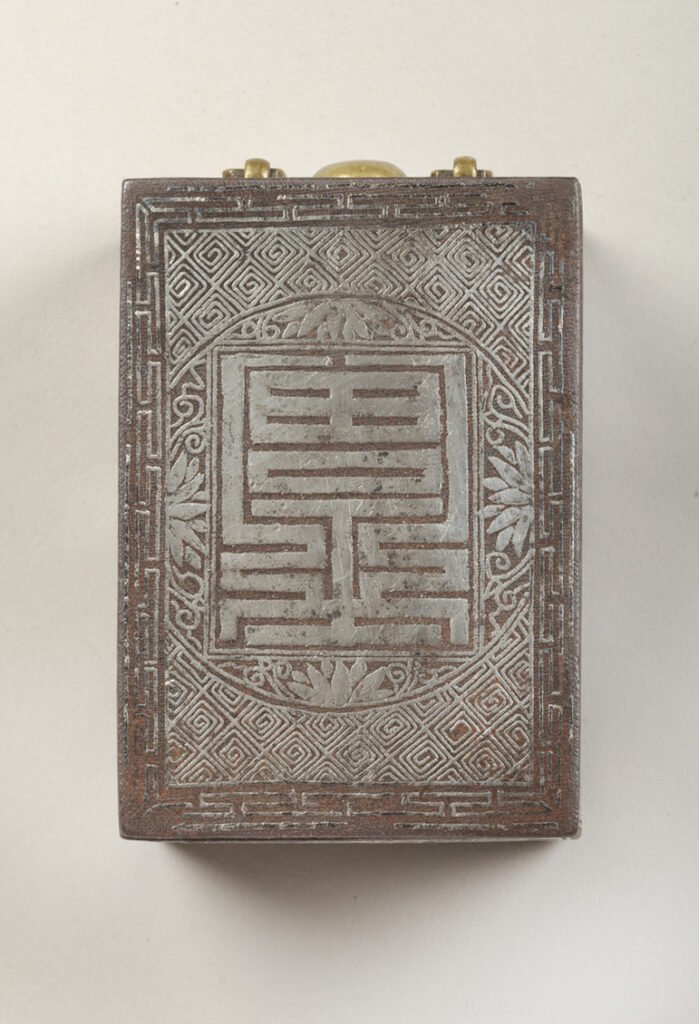

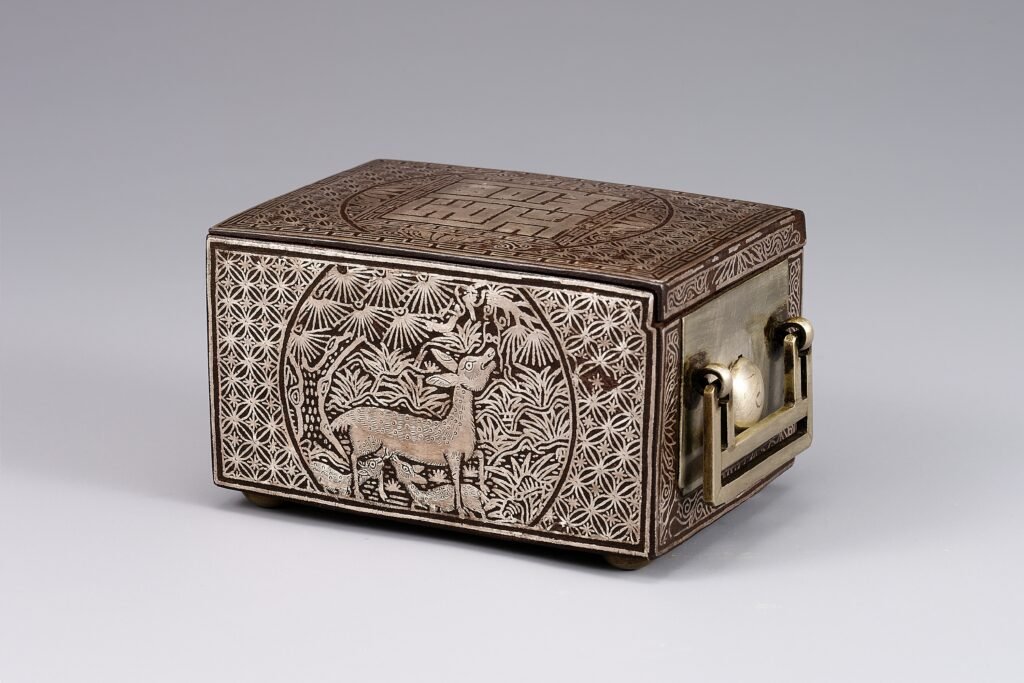
This box-shaped case was used to store tobacco leaves during the Joseon Period. It features the Ten Symbols of Longevity (i.e., deer, crane, and more) inlaid in silver. The Chinese character “壽,” which stands for longevity, and “福,” representing blessings, are inscribed in the middle of the lid.
Collection of the National Museum of Korea.

H. 5cm, Diameter: 10cm.
Collection: National Folk Museum, Seoul.


Collection: National Museum of Korea.

Collection: National Museum of Korea.
FOOD BOX 饌盒
These food boxes could be used by both sexes, primarily among wealthy households or government officials.
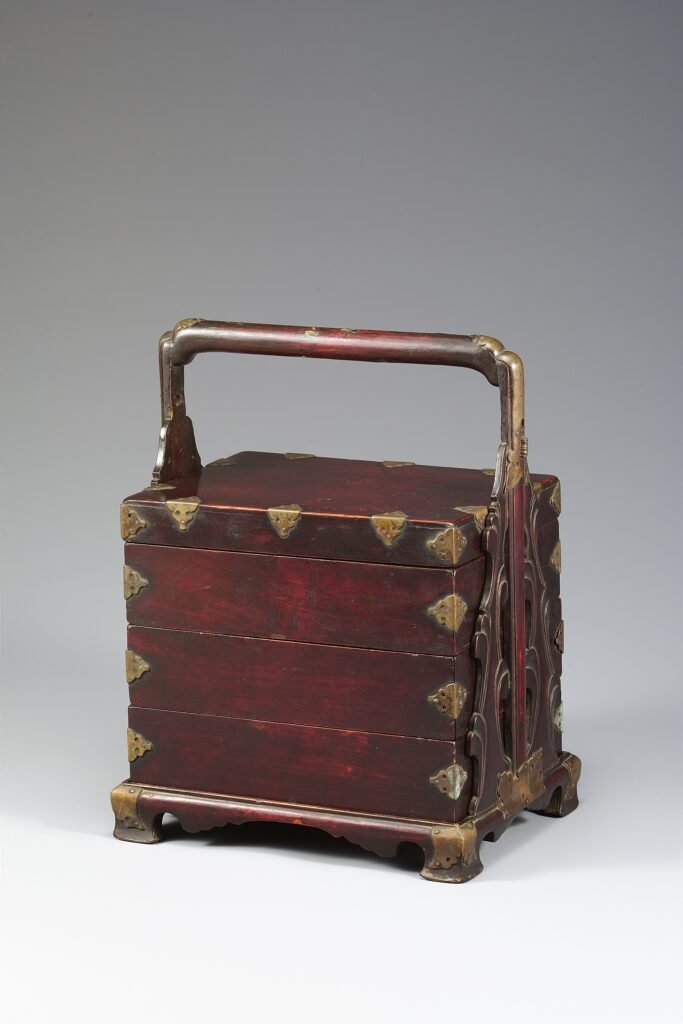
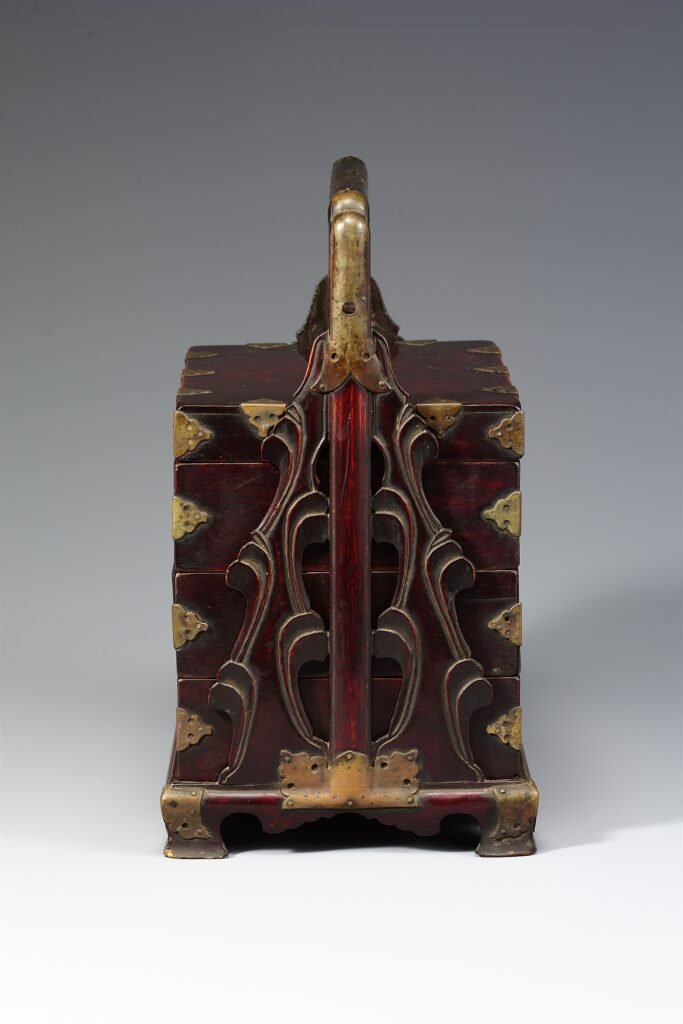

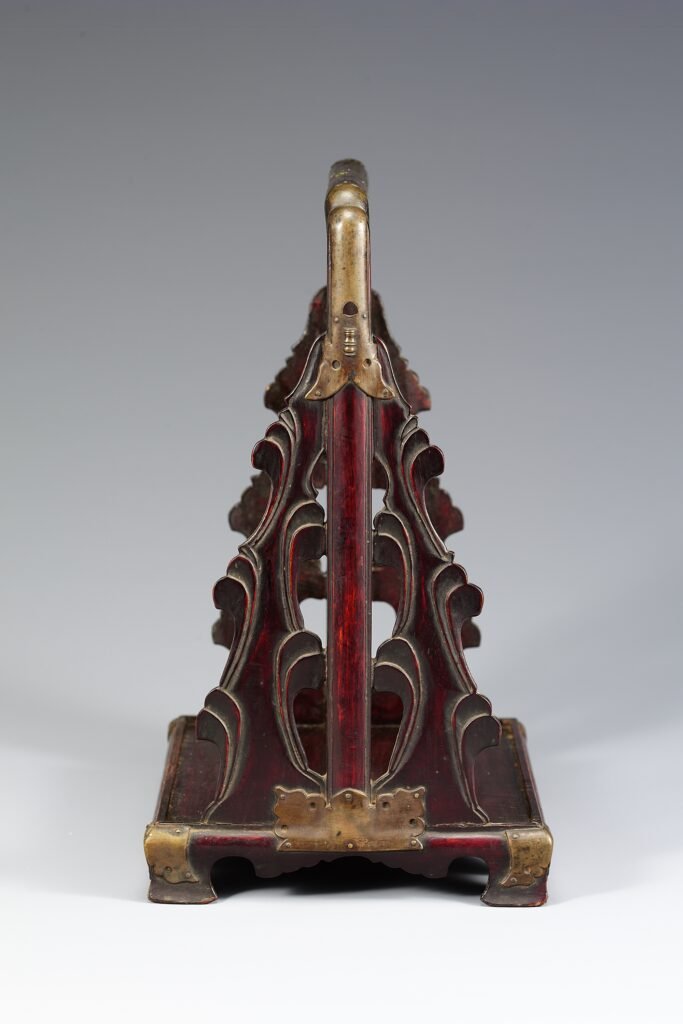

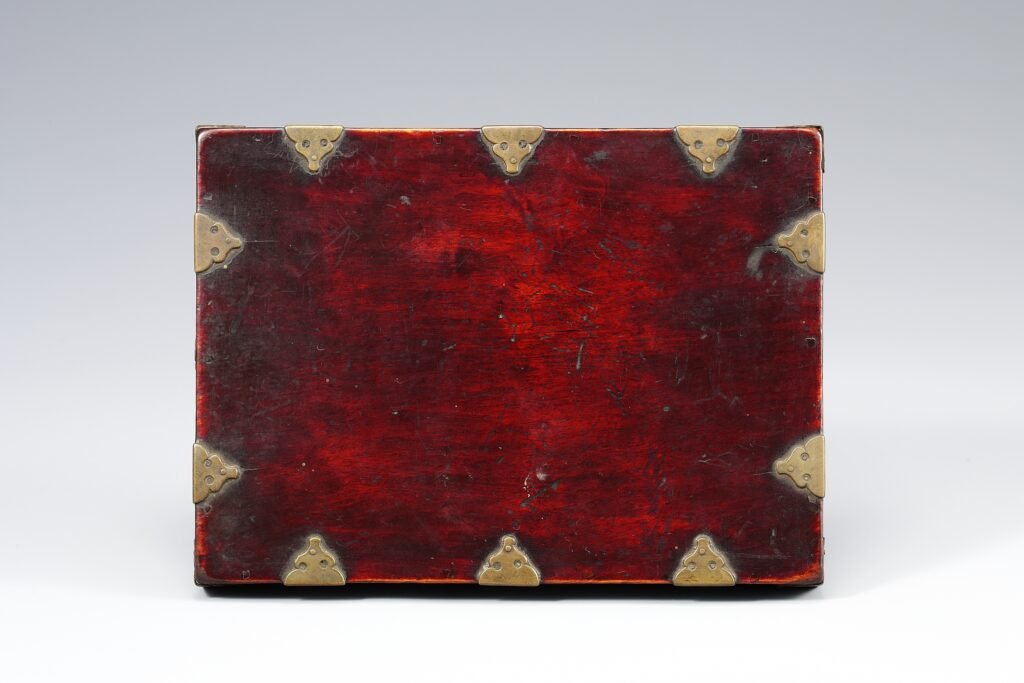


Since “Won”, an accommodation run by government offices during the Joseon Dynasty, only cooked rice, travelers had to carry their own food and side dishes in boxes. This box made of stained wooden boards was used to hold side dishes. Handles were attached to a pedestal. A sheet of tin is used to firmly hold each corner, contrasting with the dark brown color of the body to enhance the decorative effect.
H. 28,3cm, W. 19,8cm, D. 15cm. Collection National Museum of Korea.
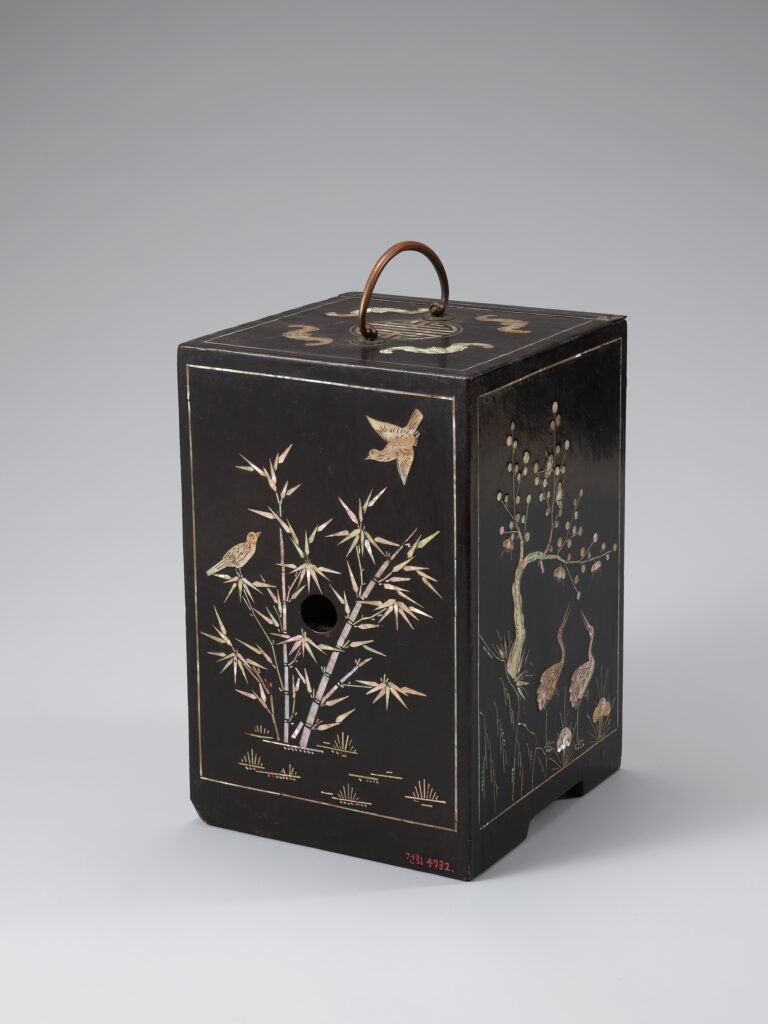
Collection National Museum of Korea.

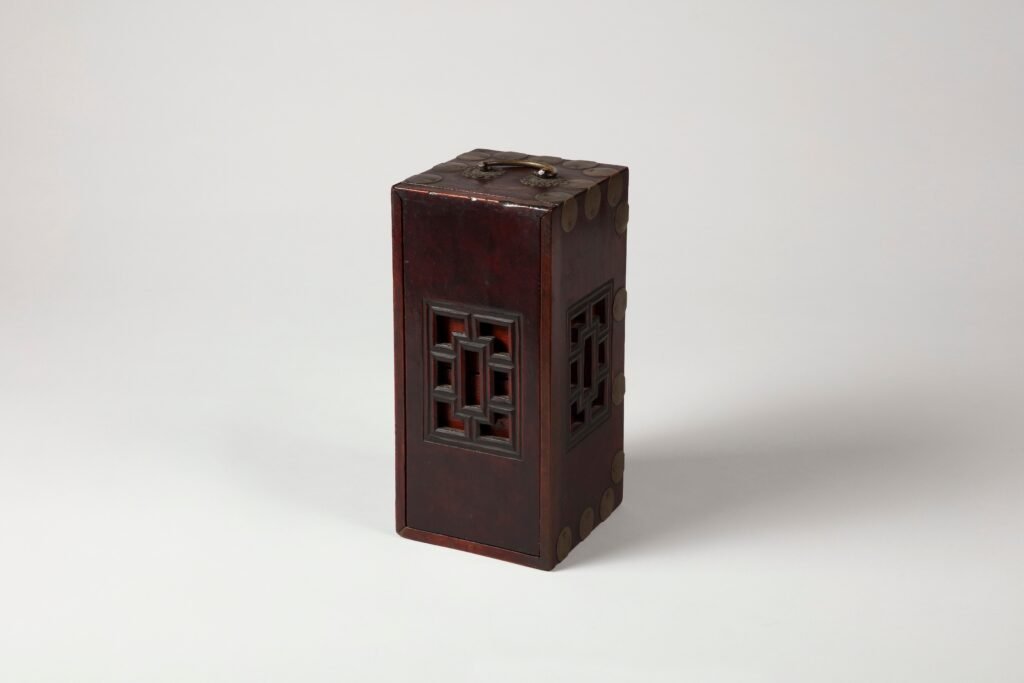
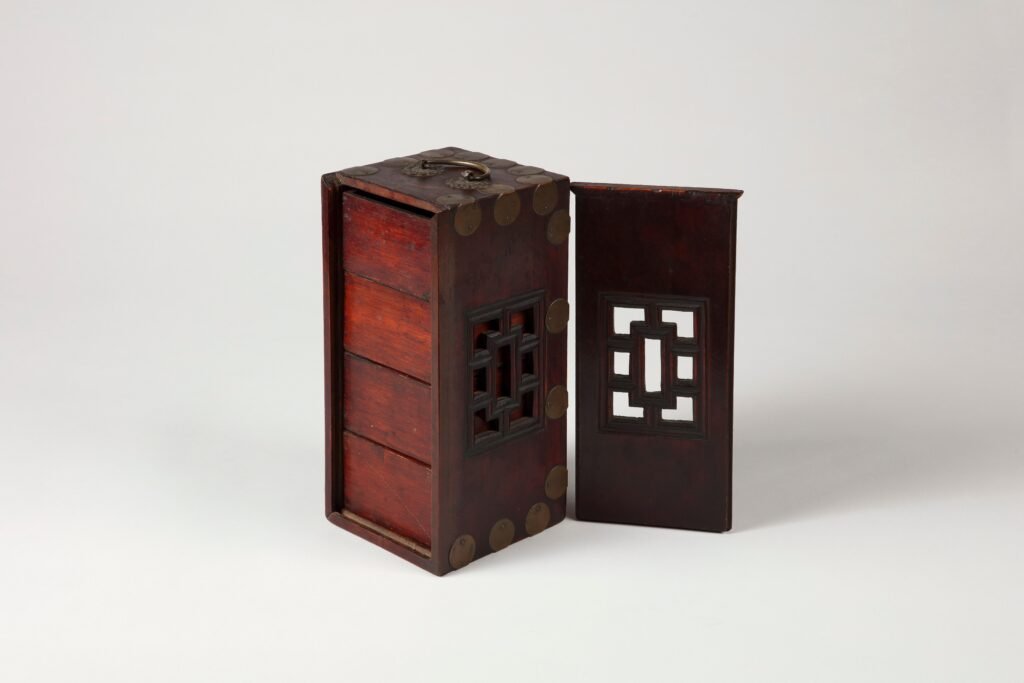
H. 29,5cm, W. 14cm, D. 13,7cm.
Collection: Busan Metropolitan City Museum, Korea.


Collection: Korean National Museum.

BOXES FROM THE WOMEN’S QUARTER.
Women of the Joseon dynasty, especially those from the aristocracy and members of the extended royal family, possessed various boxes for storing valuables and essentials such as jewelry, cosmetics, combs, hairpins, and sewing materials…
WEDDING BOXES. 함
Wedding boxes were typically comprised of two similar boxes used during the wedding ceremony by the bride to store clothing and various implements. These boxes have been featured in a special post that can be checked at: Korean wedding boxes.
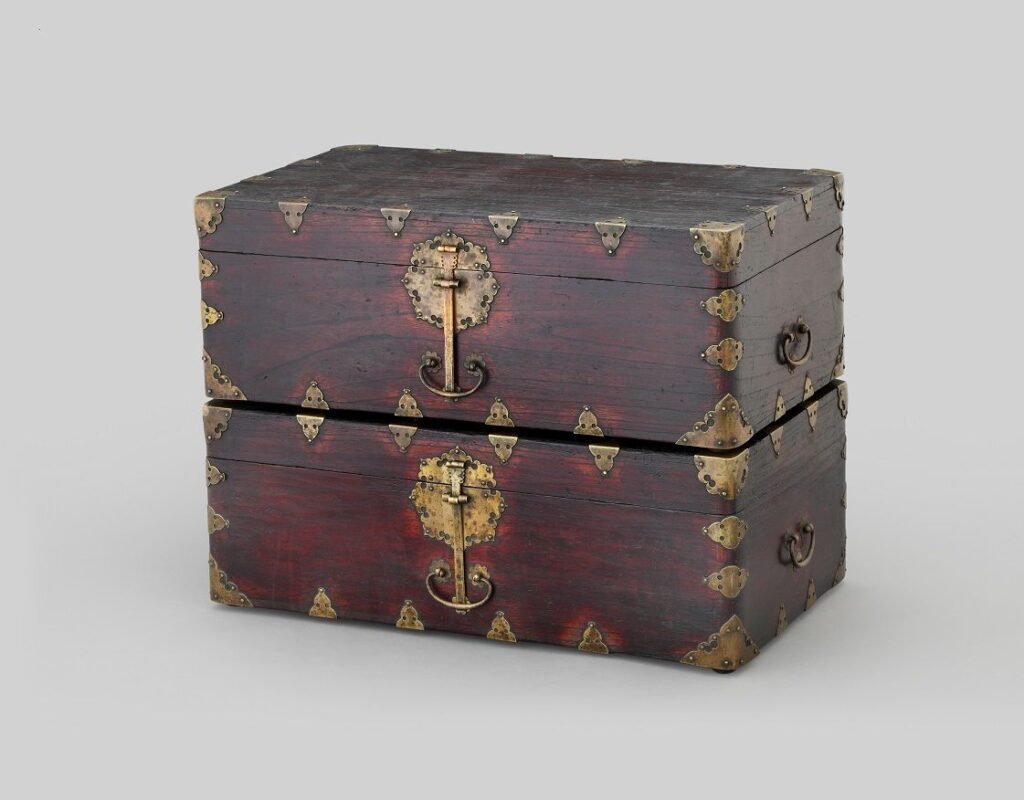
Paulownia wood, yellow brass fittings.
probably used as wedding boxes.


H. 10,9cm, W. 31,7cm, D. 16,7cm.
Collection: National Museum of Korea.
MIRROR & COMB BOXES. 경대
The distinctive feature of the mirror box was its two-piece tray on top, which allowed for the placement of a mirror that could be opened. The lower part typically contained one or two small drawers. These boxes were primarily used by women and often featured ornate designs, with hinges adorned with auspicious motifs or finished with lacquer and mother-of-pearl inlay.
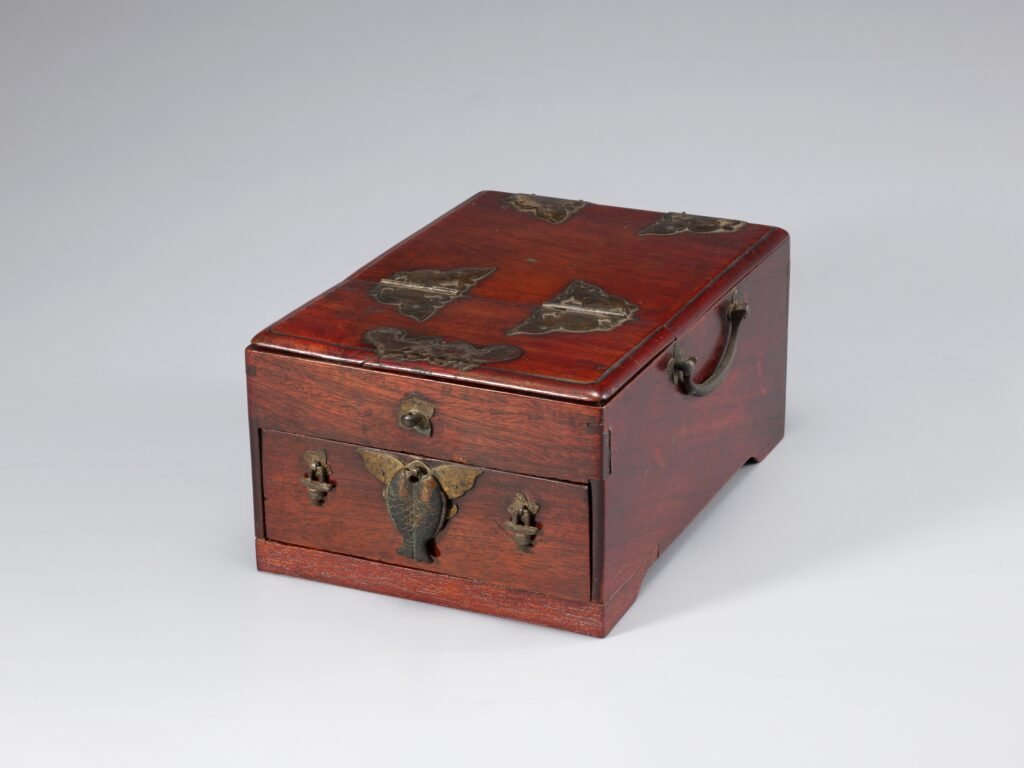
H. 9,8cm, W. 14,5cm, D. 20,4cm. (photos left & right).
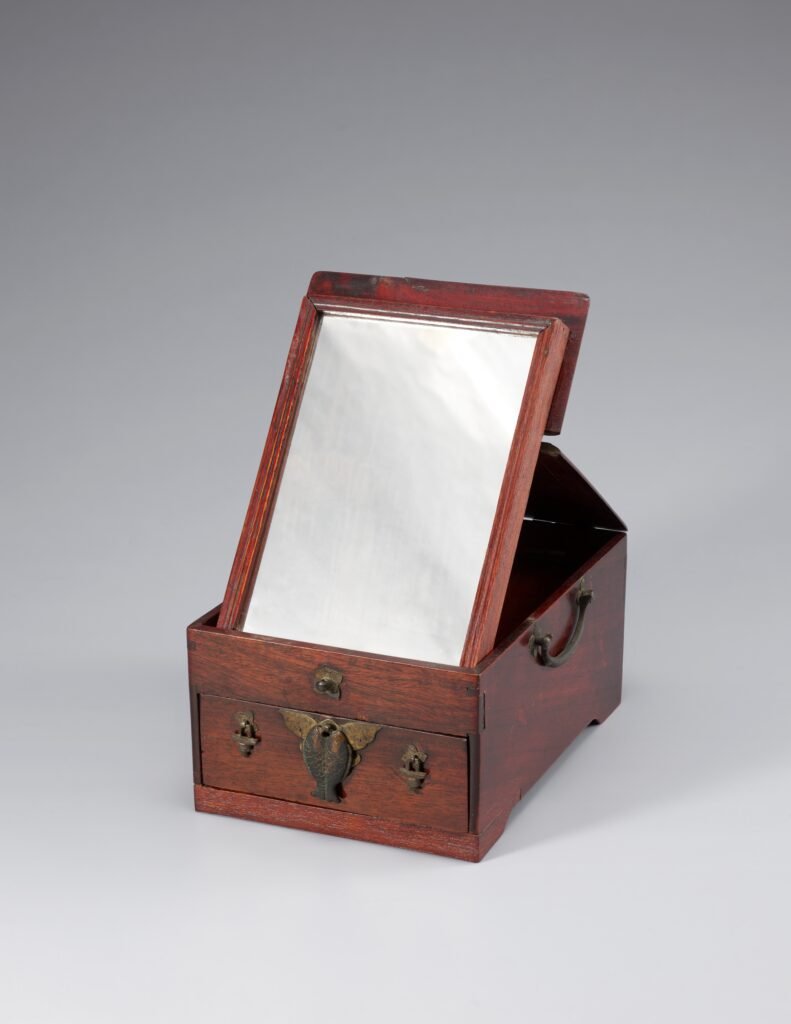
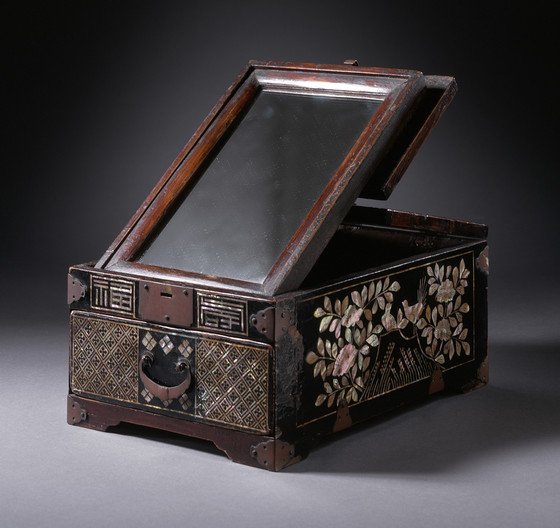
Brown lacquer on wood core with mother-of-pearl inlay, brass fittings, and silvered glass
12.07 x 26.35 x 18.1 cm.
Collection LACMA. Los Angeles Museum of Art. USA

Collection national Museum of Korea.

JOSEON DYNASTY (CIRCA 1900)
Rectangular, set on four bracket feet and fitted with two drawers and integral folding mirror and stand at the top, the faces of the drawers incised with a shaped panel of orchids and the sides with a bird and flowers and the back with a stag and pines; metal mirror latch and drawer pulls in the shape of a radiant sun and butterfly, interiors of the drawers unlined. 11¼ x 8¼ x 7¾in. (28.3 x 21 x 19.7cm.)

LINK: Marvelous Mirrors.
THE KOREAN RED LACQUER COMB BOX.
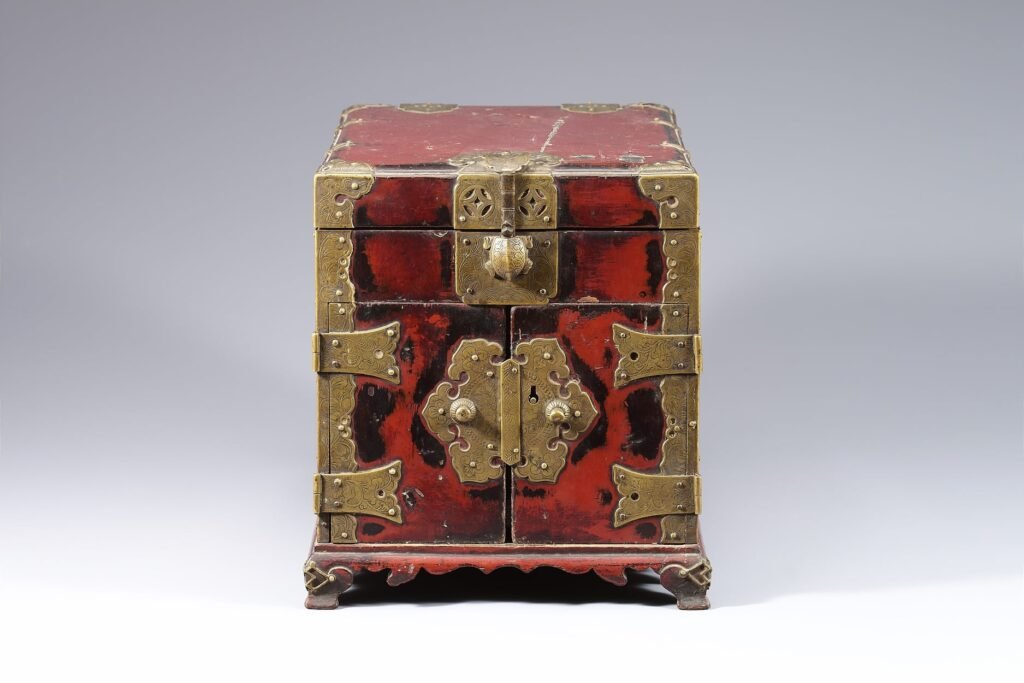
RED LACQUERED COMB BOX.
19th century. Collection of the National Museum of Korea.
According to Edward Reynolds Wright and Man Sill Pai in their excellent publication “Korean Furniture, Elegance and Tradition” red lacquer called “Chu-Ch’il ” in korean is refined lacquer mixed with either iron oxide or cinnabar pigments or a mixture of both. Colored lacquer was applied over an undercoating (often persimmon tannin). Items covered with such lacquer were intended for the court and nobles.
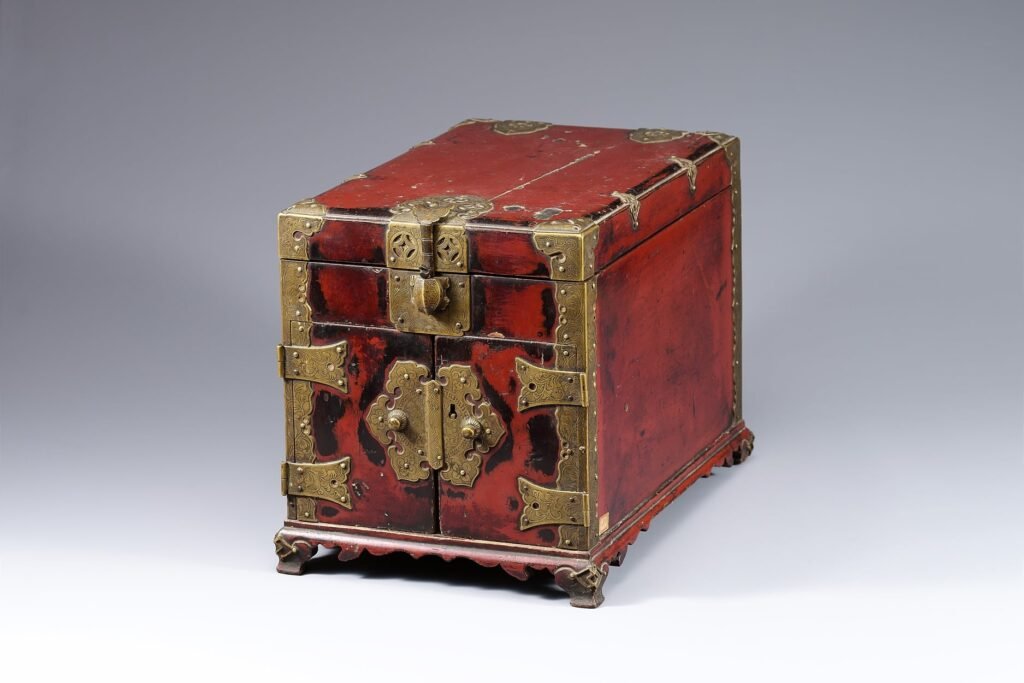







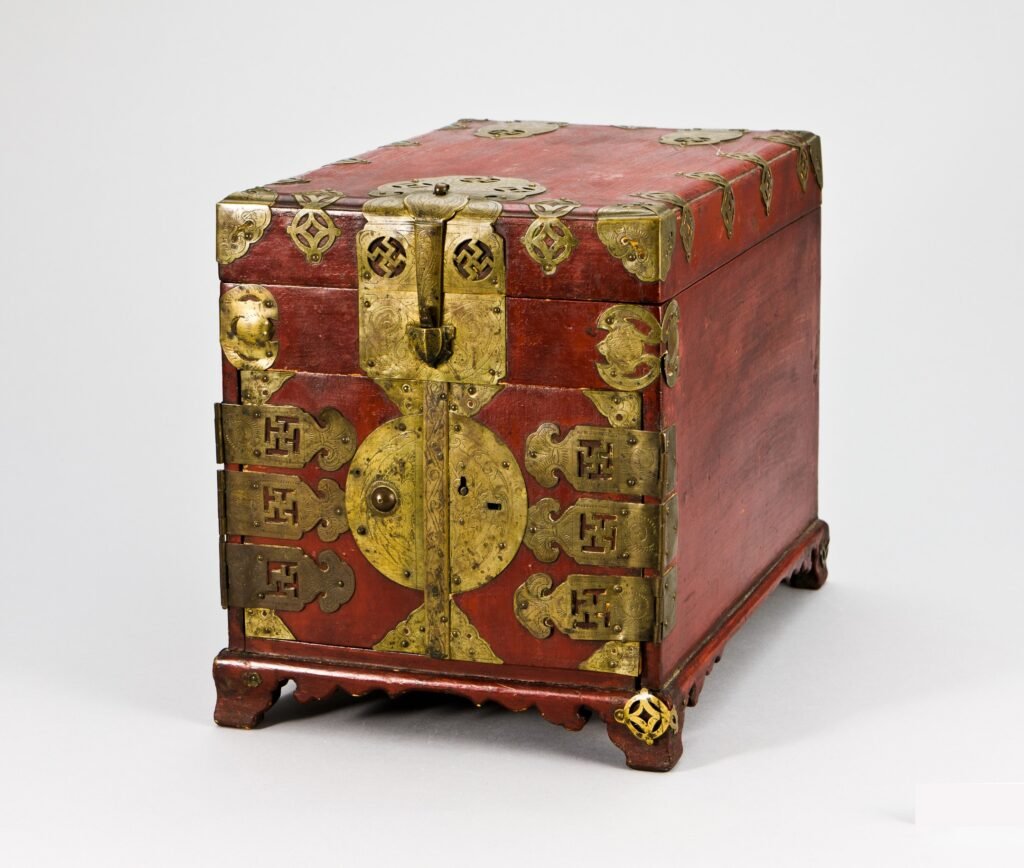
Collection: National Museum of Korea.

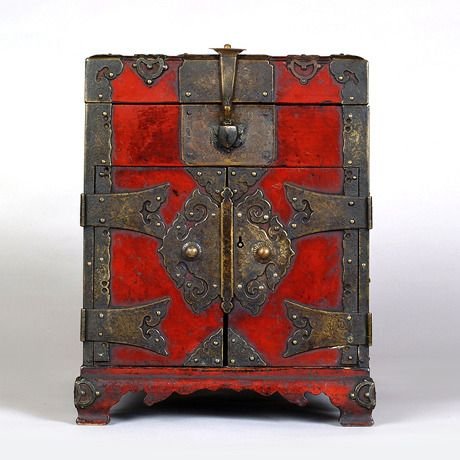
H. 30cm,. W. 23,4cdm, D. 36,2cm.
Private collection.
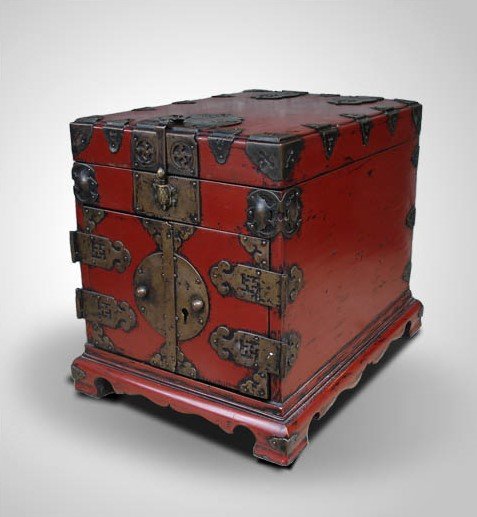
Early 20th century.
Lacquered comb box. Red lacquer on ginkgo wood. Yellow brass fittings. Gyeongsan province. Korea.
This comb box fairly recent has been rebuilt with old wood. Old yellow brass fittings have been used to decorate it.
It featured in its upper part a cookie patterned lock plate and an L shaped lock rod that fit into a turtle shaped lock.
The lower section featured a round patterned lock plate. Purely decorative pieces includes swallow shaped hinges, pattern of happiness as well as swastika and bats. Collection “ANTIKASIA”.
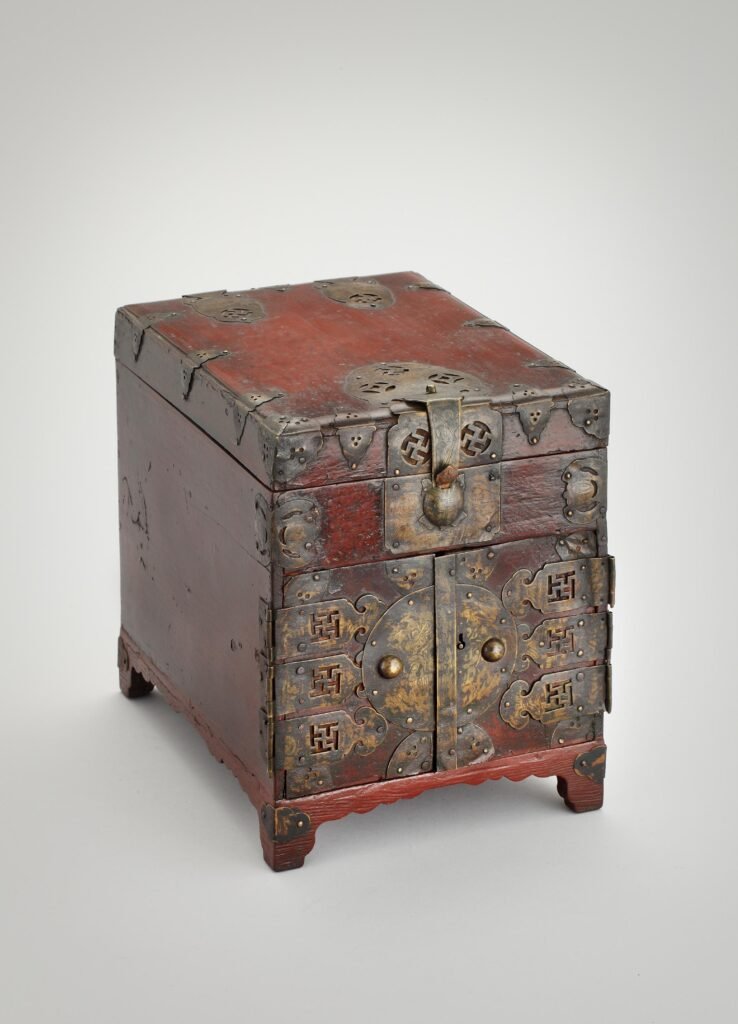
Collection: Andong City Folk Museum, Korea.

Collection: Andong City Folk Museum, Korea.
COSMETIC BOXES. 빗접
These cube-shaped boxes were compact, featuring a row of drawers at the front for storing accessories like combs and hairpins. They were frequently adorned with decorative veneers made of mother-of-pearl or painted horn. The wood was also coated in either black or red lacquer, which depended on the owner’s social status.


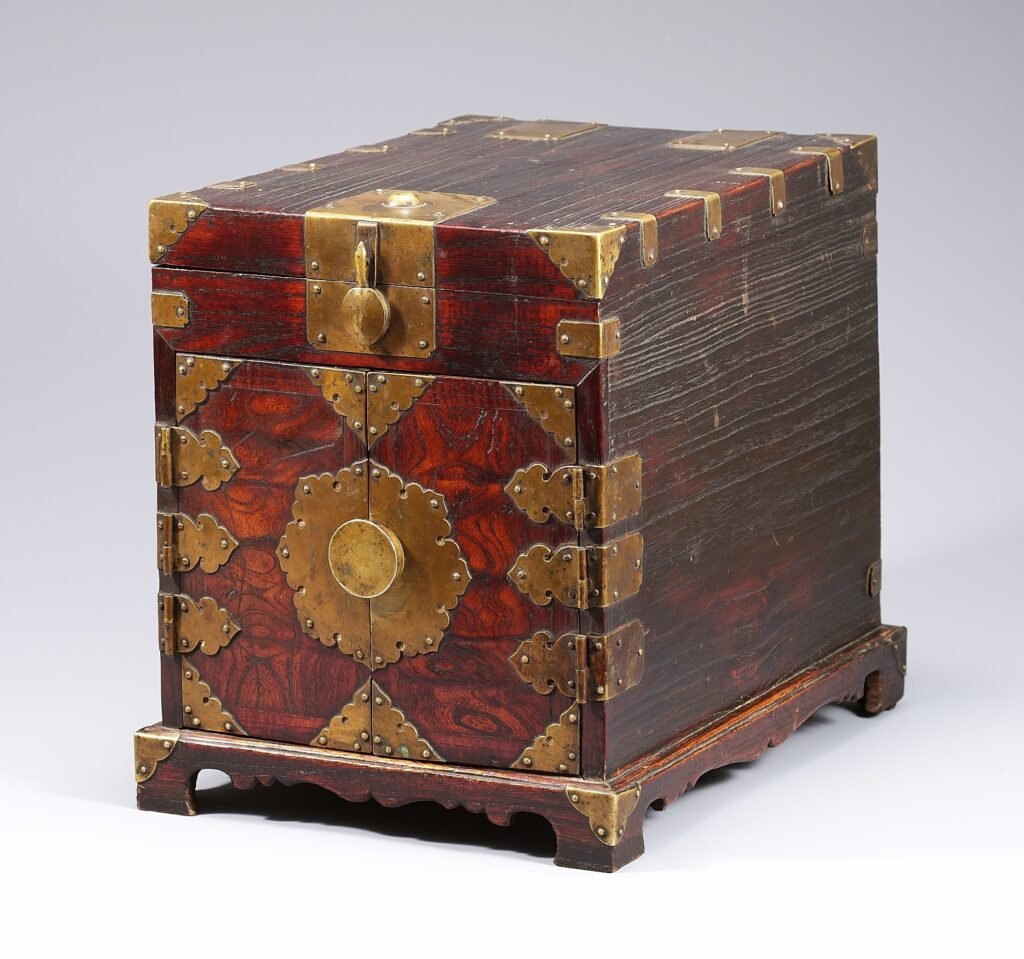
H. 29,7cm, W. 23,4cm, D. 32.5cm.
This beautiful box called “Pit-Chop” in Korean was used in the woman’s quarter to store small accessories such as combs, brushes, and cosmetic powder.
Beautiful woods have been used such as fine-grained zelkova on the front part enhanced by quality yellow brass fittings. Paulownia wood sides and top. This box stands on elegant legs. Origin: Probably Gyeonggi Do Province. Korea.
Collection National Museum of Korea.
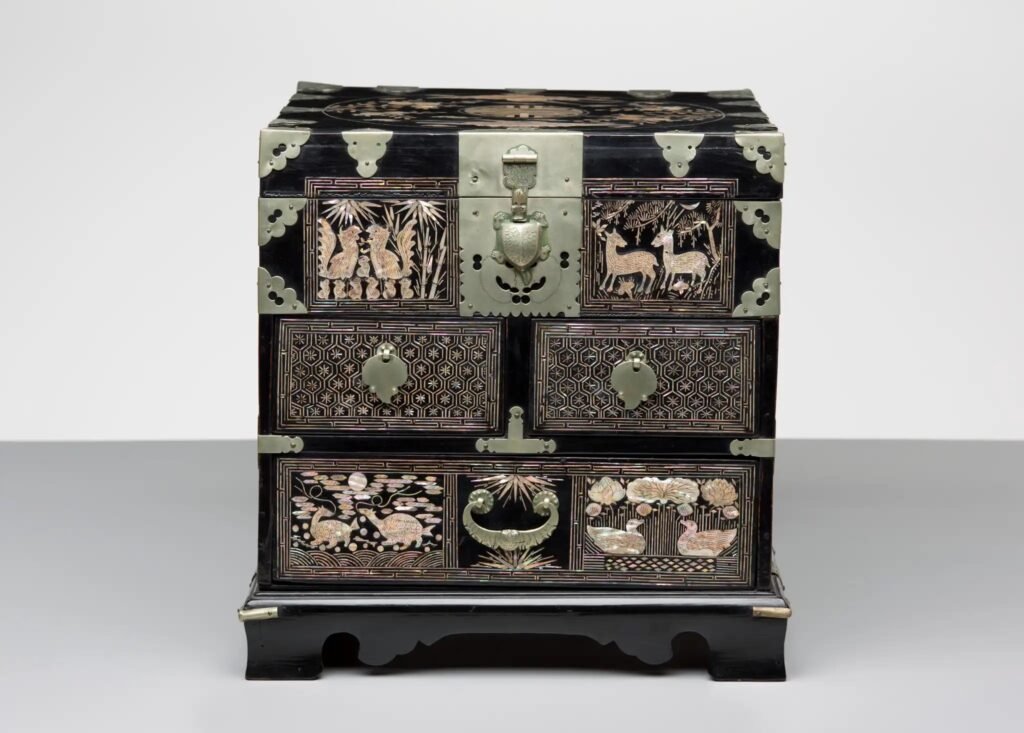
31,8 × 29,8 × 29.2 cm
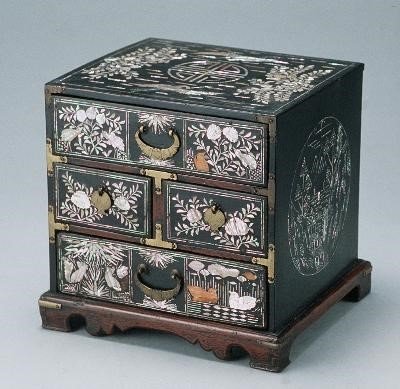
H. 28,7cm, W. 27,9cm, D. 24,6cm.
Collection National Museum of Korea.
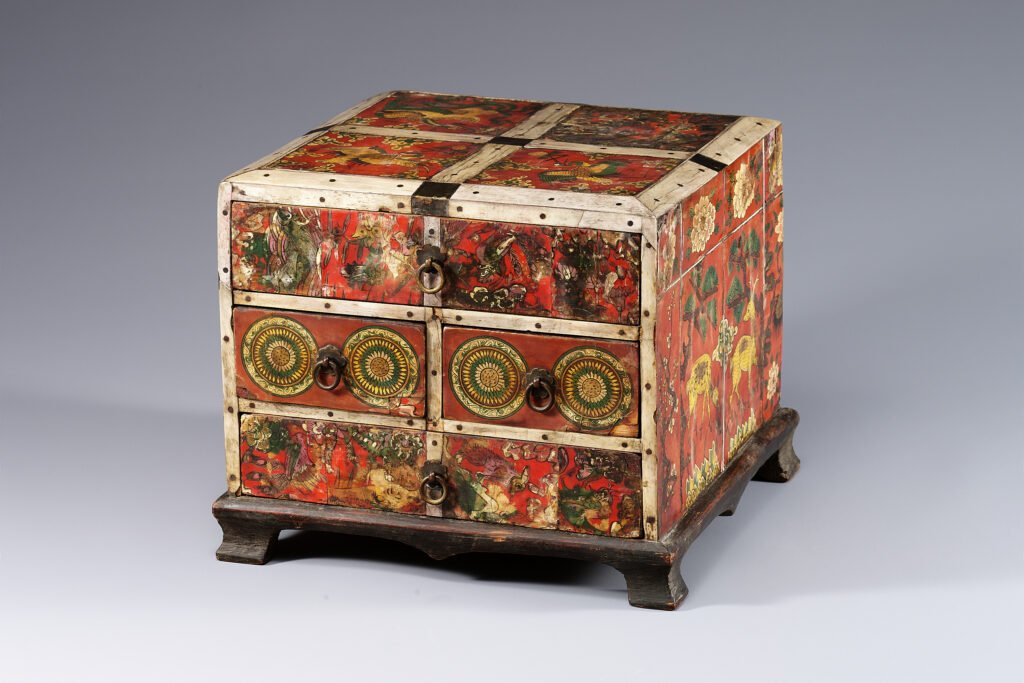

Paulownia wood, white brass fittings, oil finish.
H. 29 cm, W. 34 cm, D. 34 cm.. Mid 19th Century.
Gyeonggi Province, Korea. Collection “ANTIKASIA”.

Black lacquer on pine wood,, mother of pearl inlay, yellow brass fittings. Gyeongsang Province, Korea.
H. 27 cm, W. 26 cm, D. 24 cm.
Early 19th Century. Collection “ANTIKASIA”

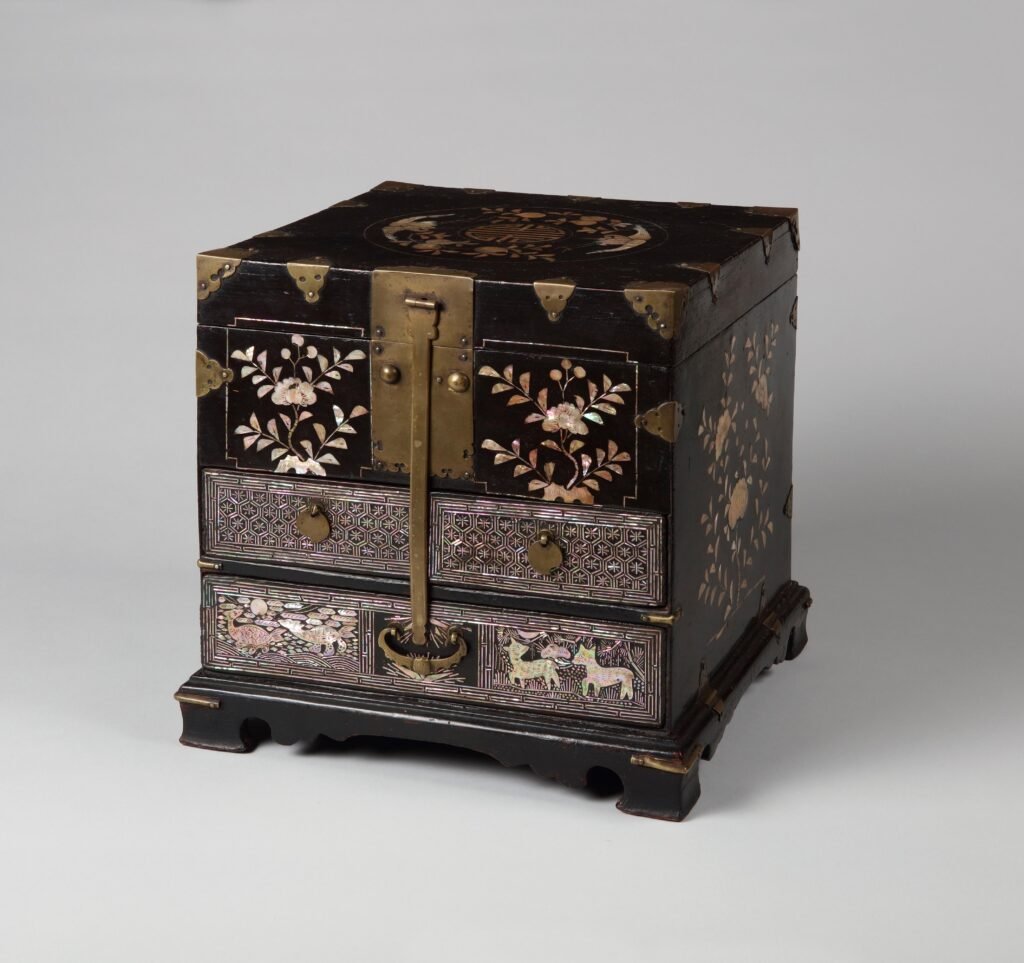
Collection: Busan Metropolitan City Museum, Korea.
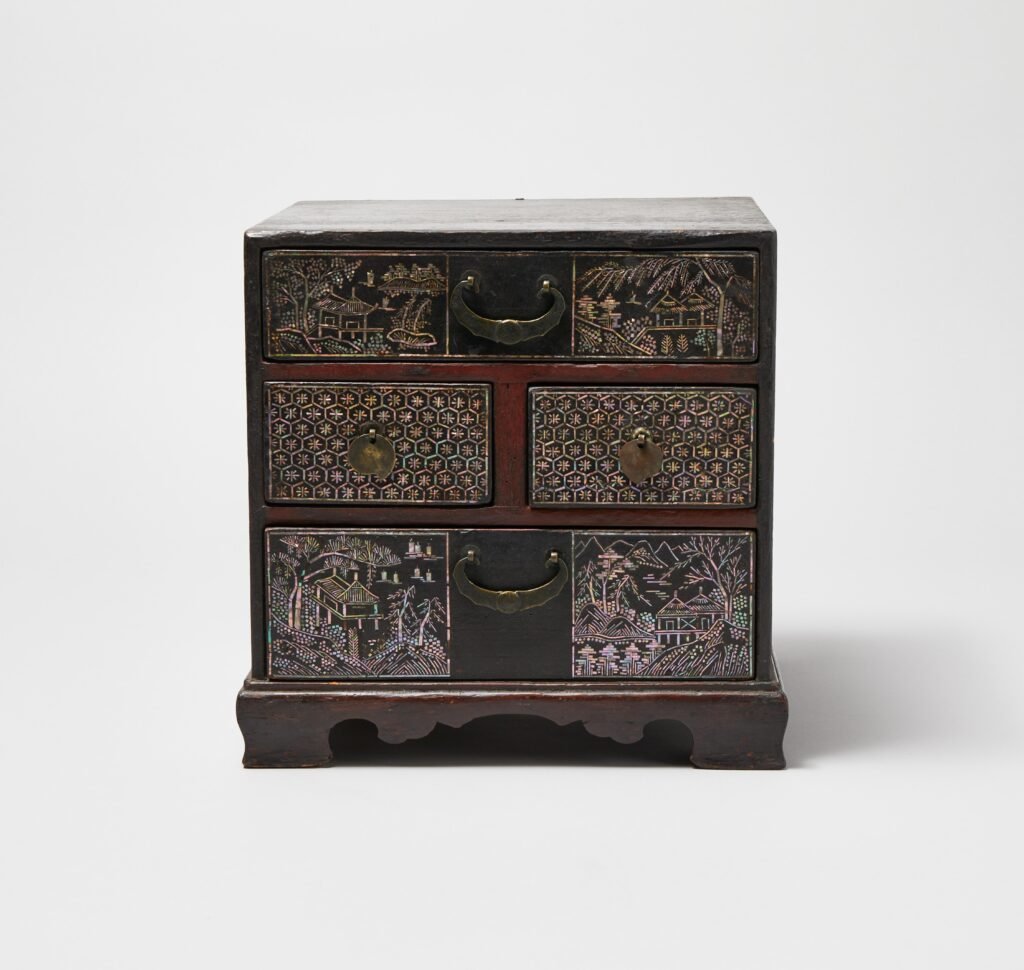
Collection: Yeongcheon History Museum, Korea.
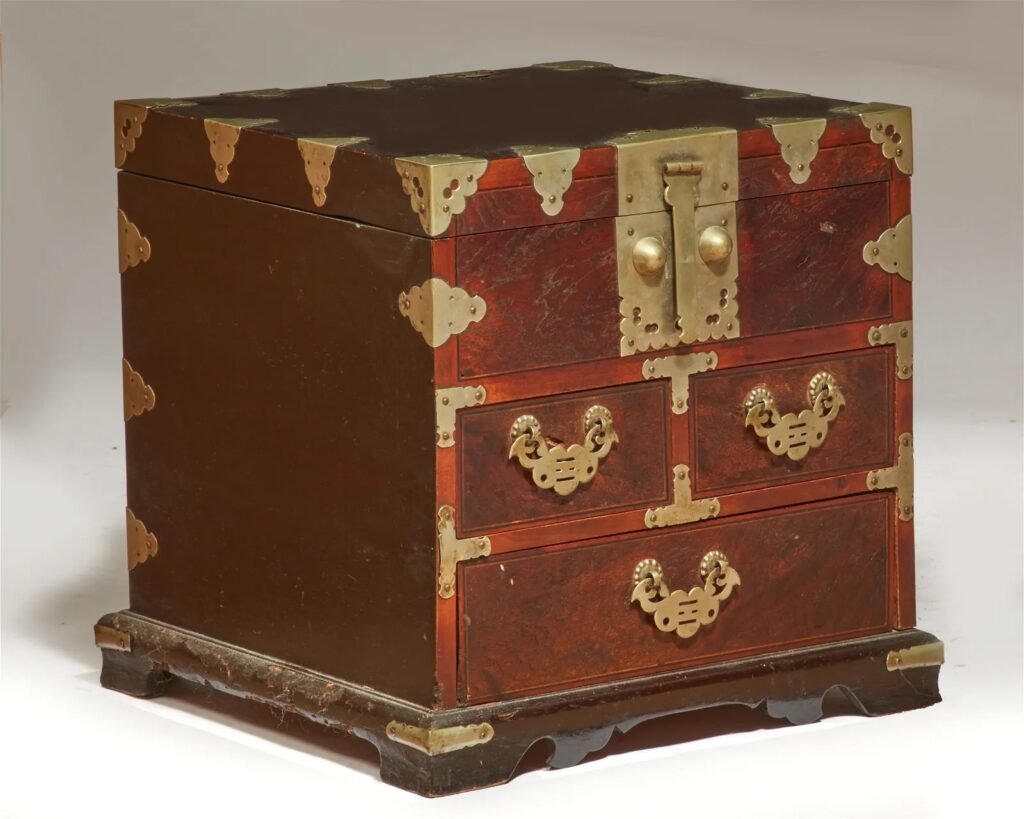
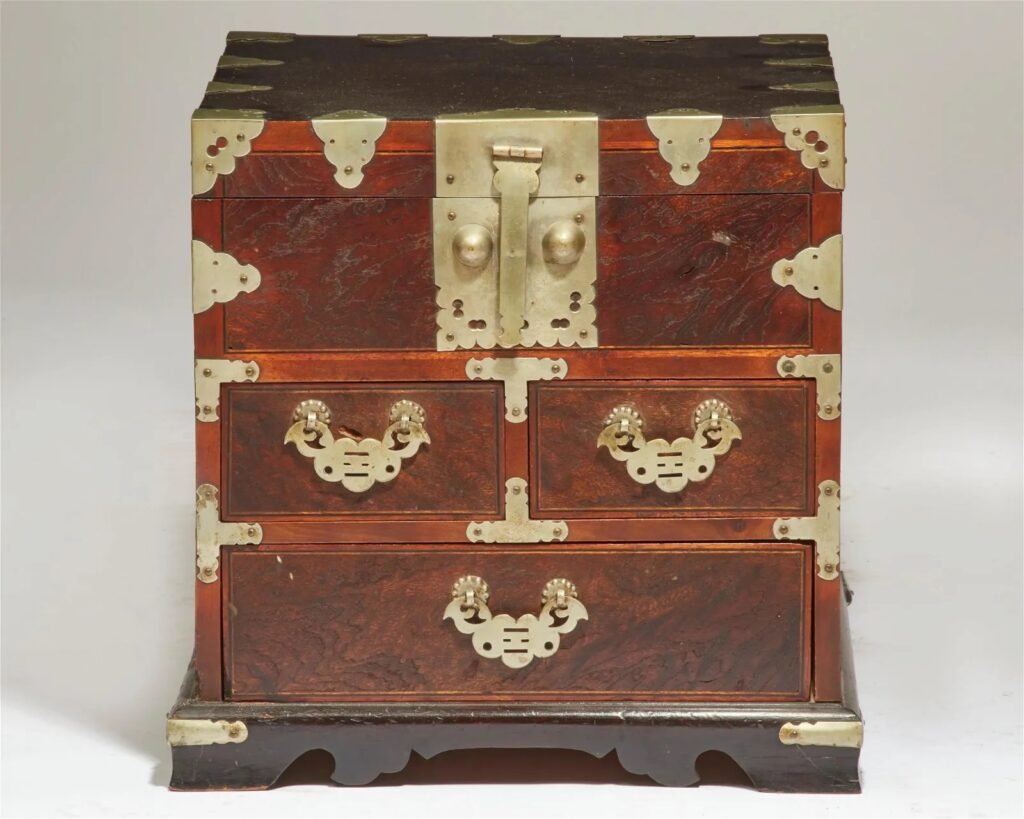
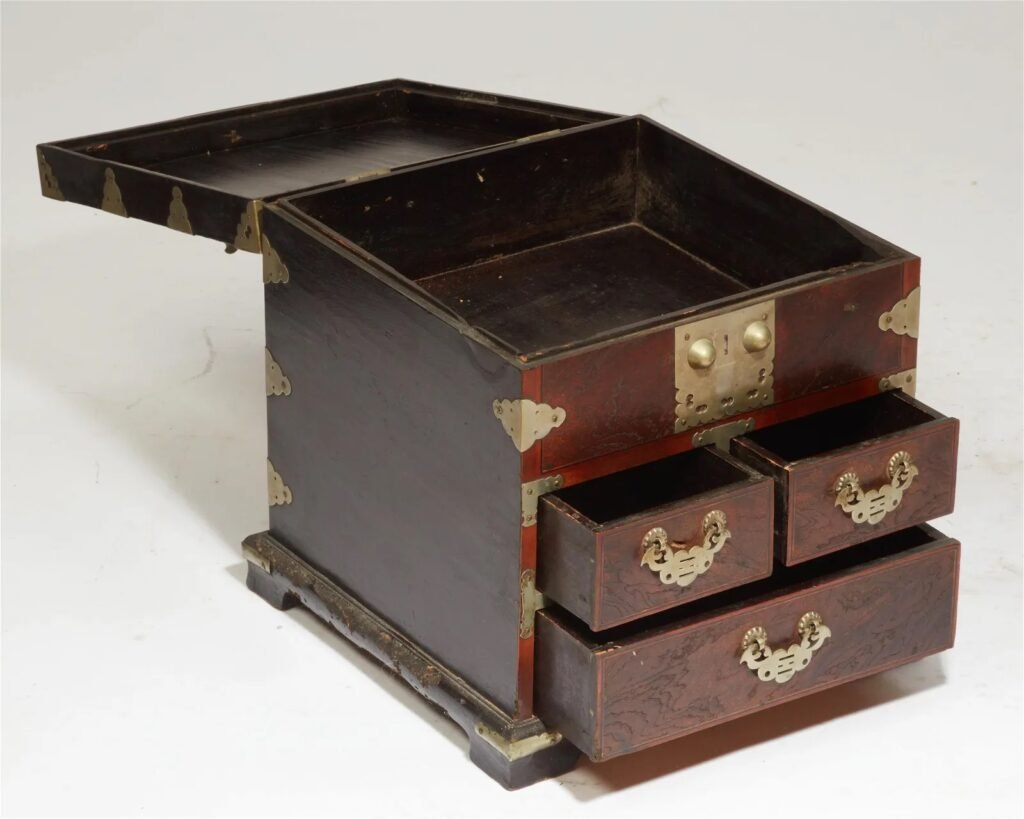

Collection National Museum of Korea. (Photos left & right).
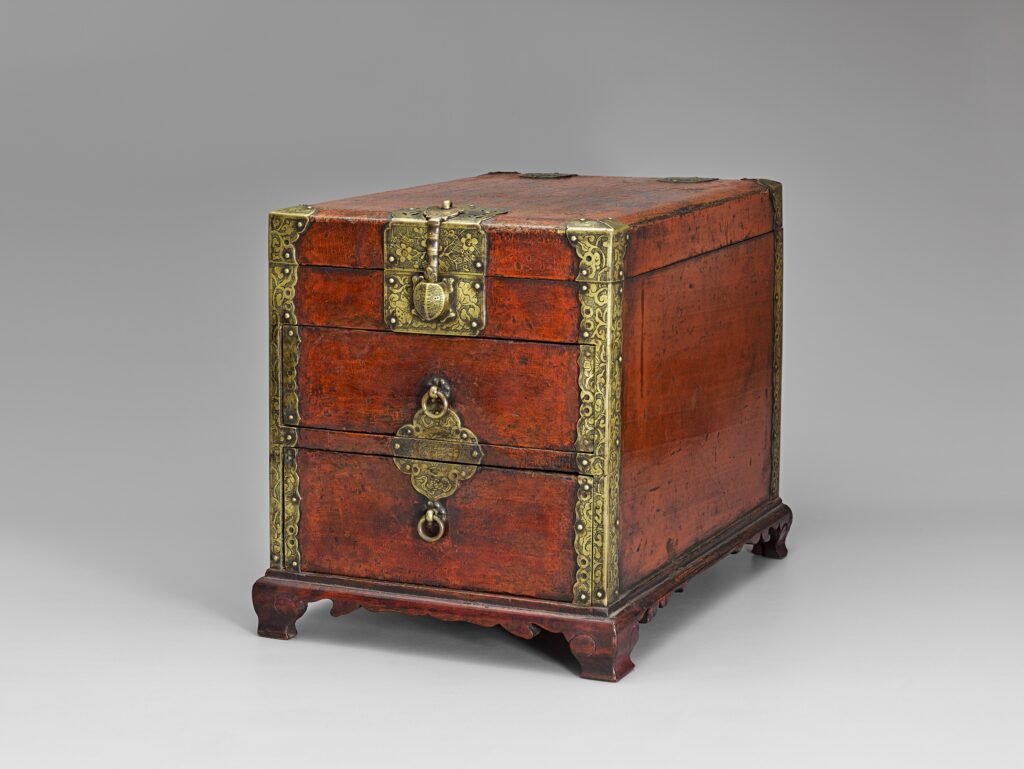
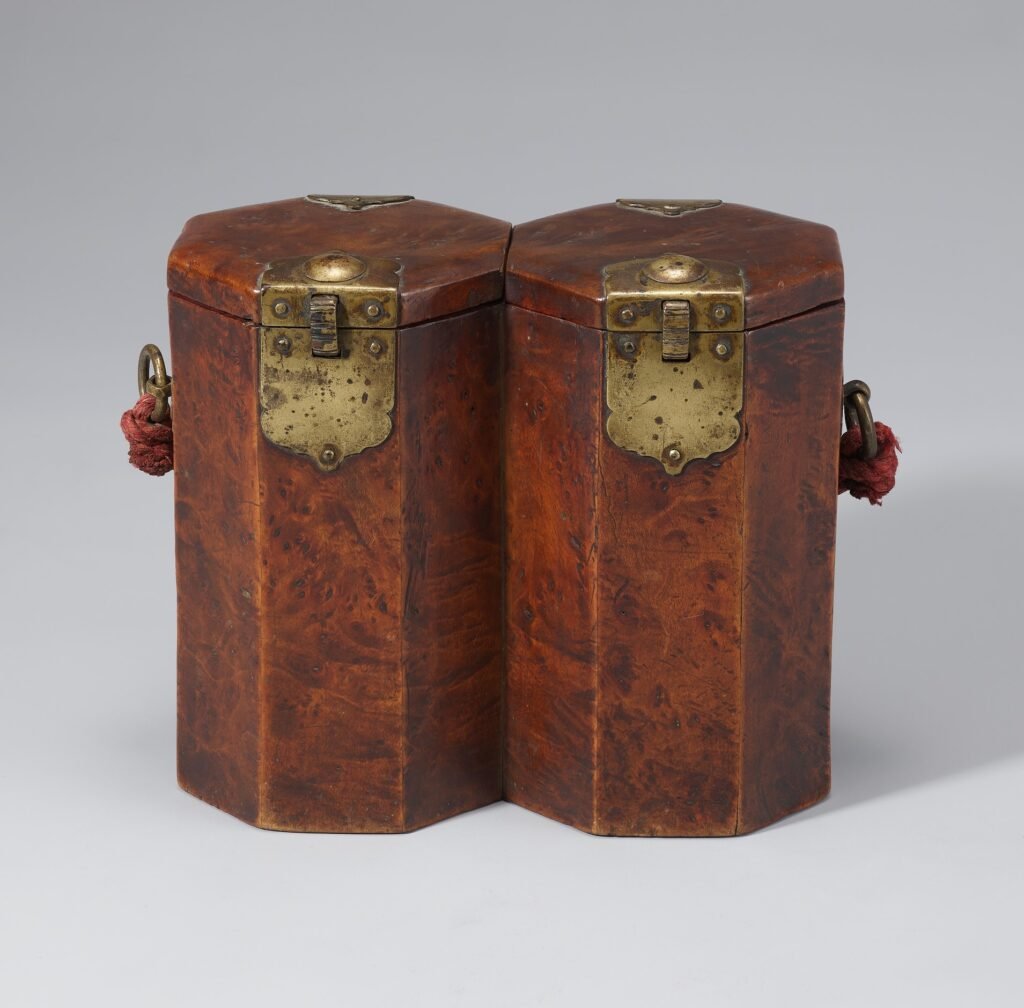
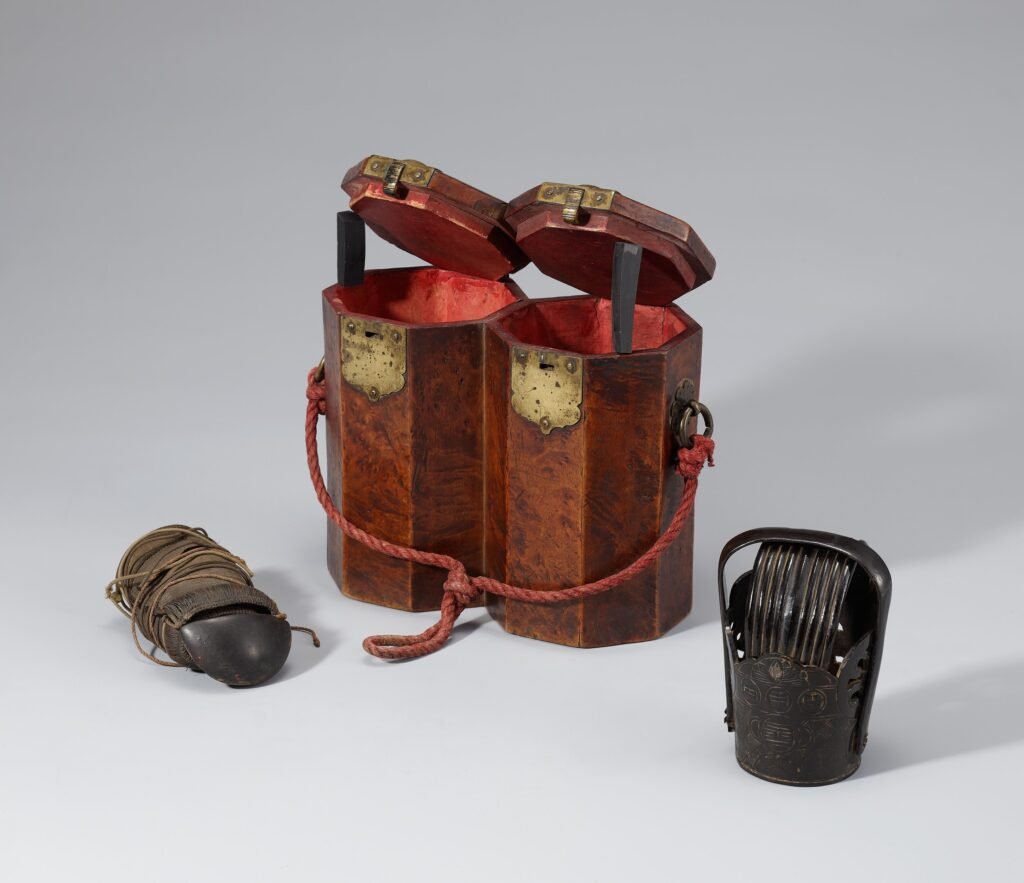
Collection National Museum of Korea.

Mother-of-pearl on wood, yellow brass fittings.
Late 19th century. H. 30,5cm, W. 33cm, D. 27cm.
Collection National Museum of Korea.
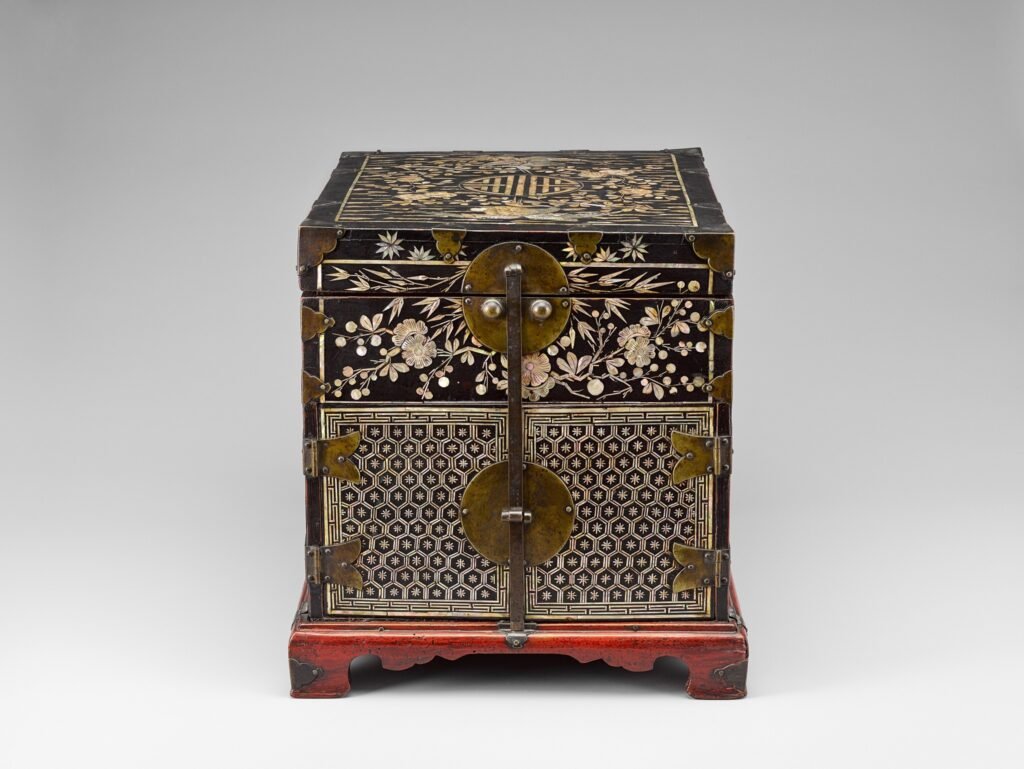

H. 26,8cm, W. 21,8cm, D. 21,7cm.
Collection: National Museum of Korea.
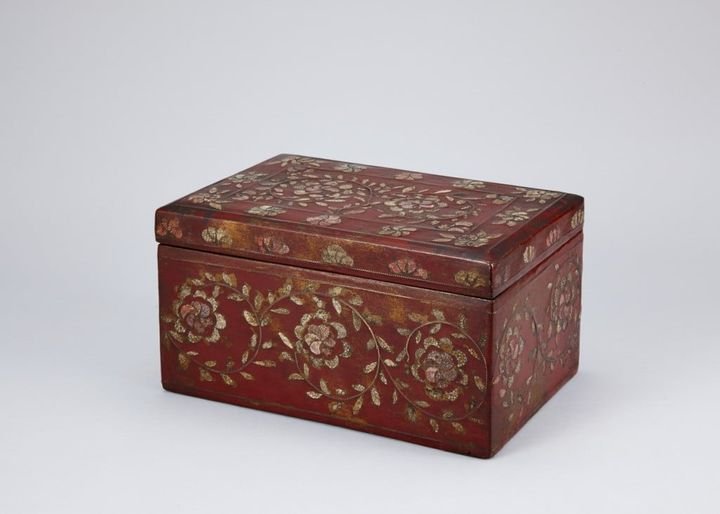
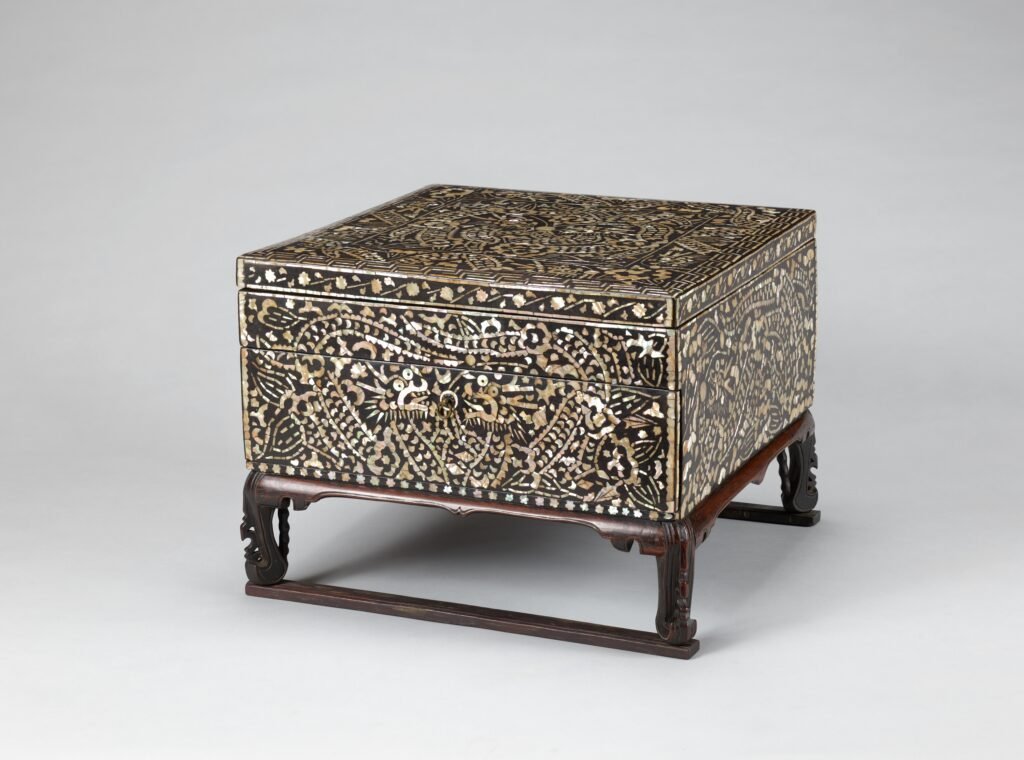
Joseon Dynasty, wood and mother-of-pearl inlay. 19th century.
H. 32.7cm, L. 42.4cm, W. 42.0cm.
Collection National Museum of Korea.

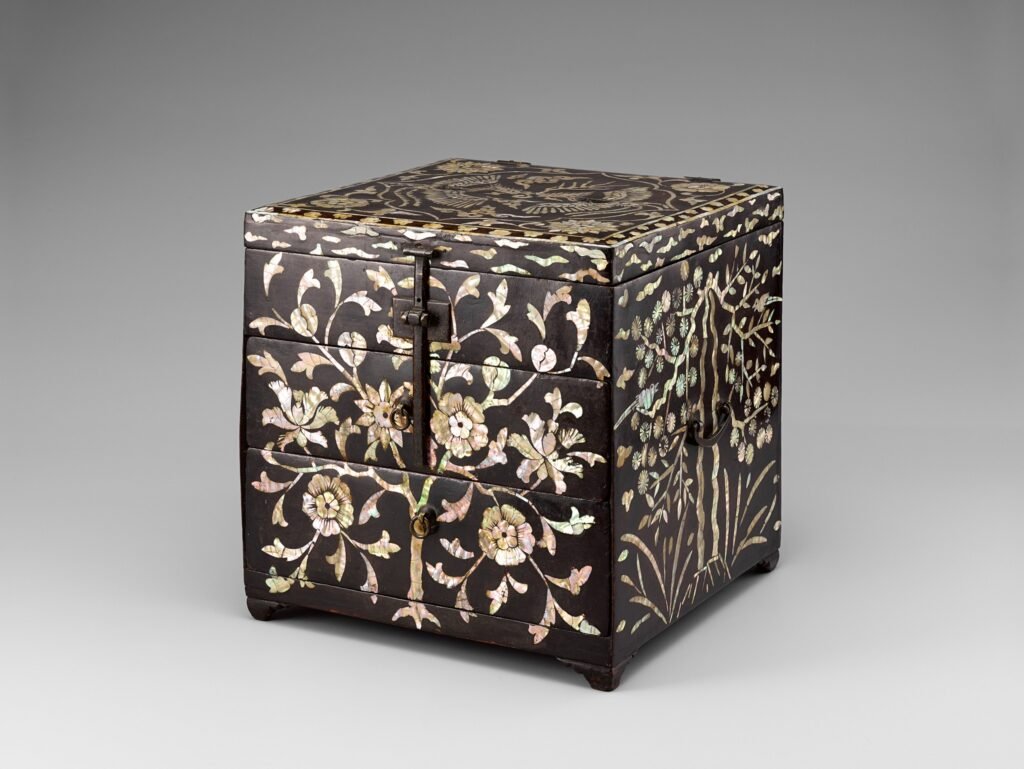
Lacquered Comb Box Inlaid with Mother-of-Pearl, Joseon Dynasty. Collection: National Museum of Korea.
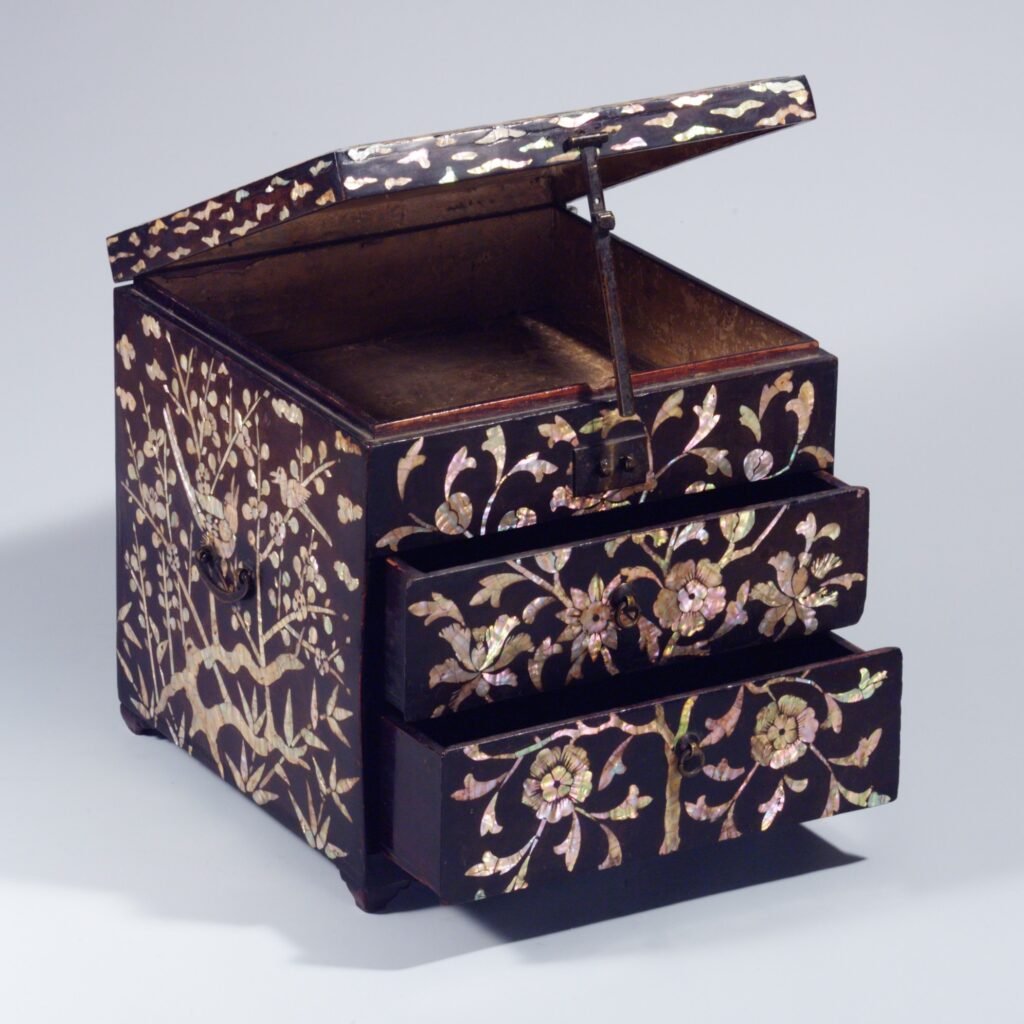
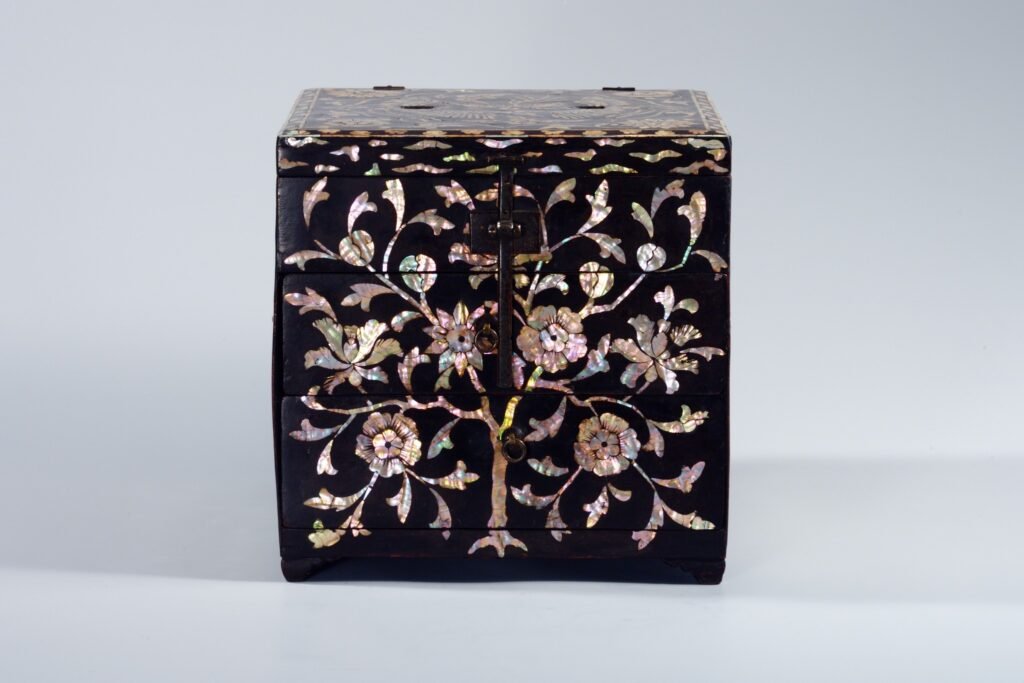
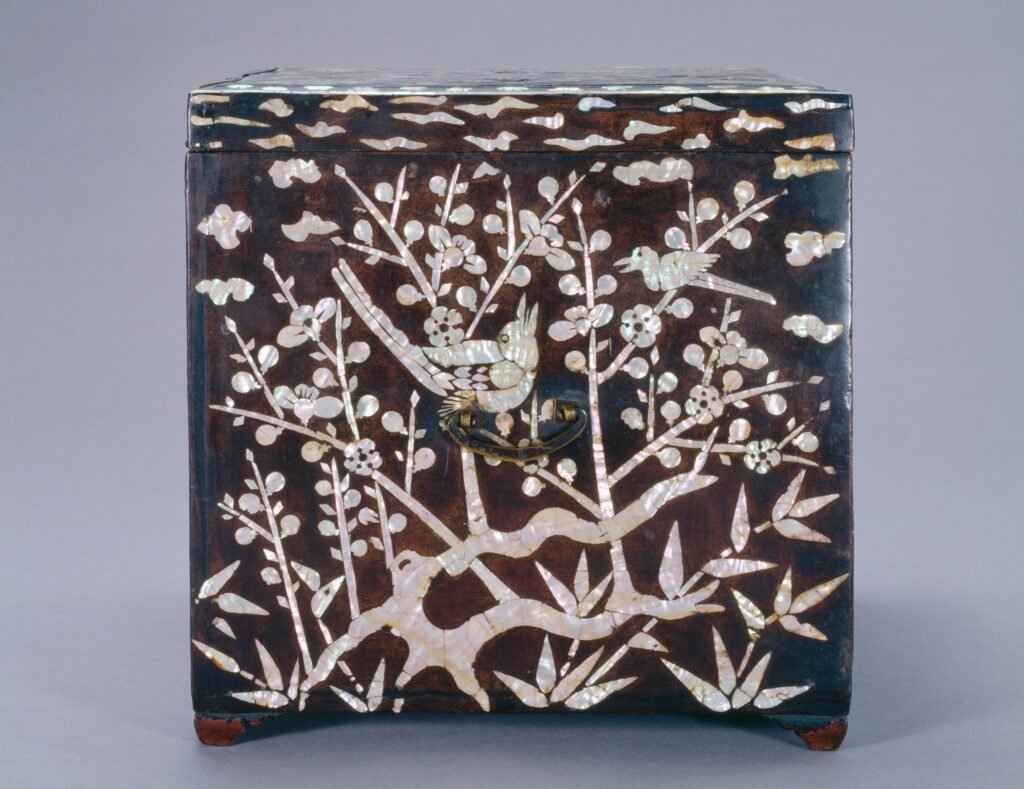
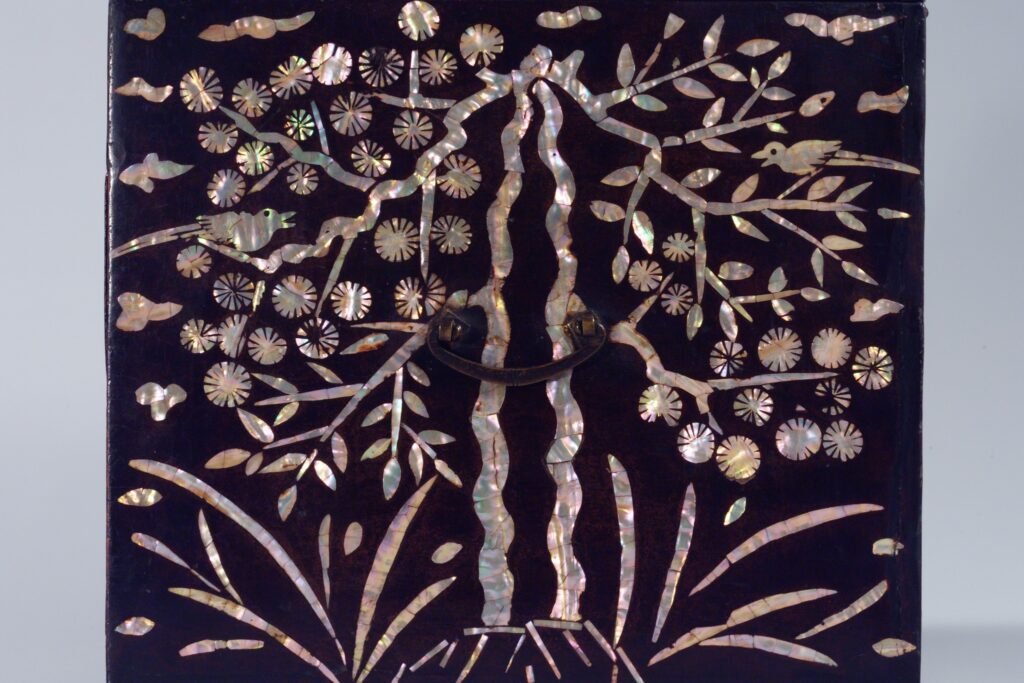
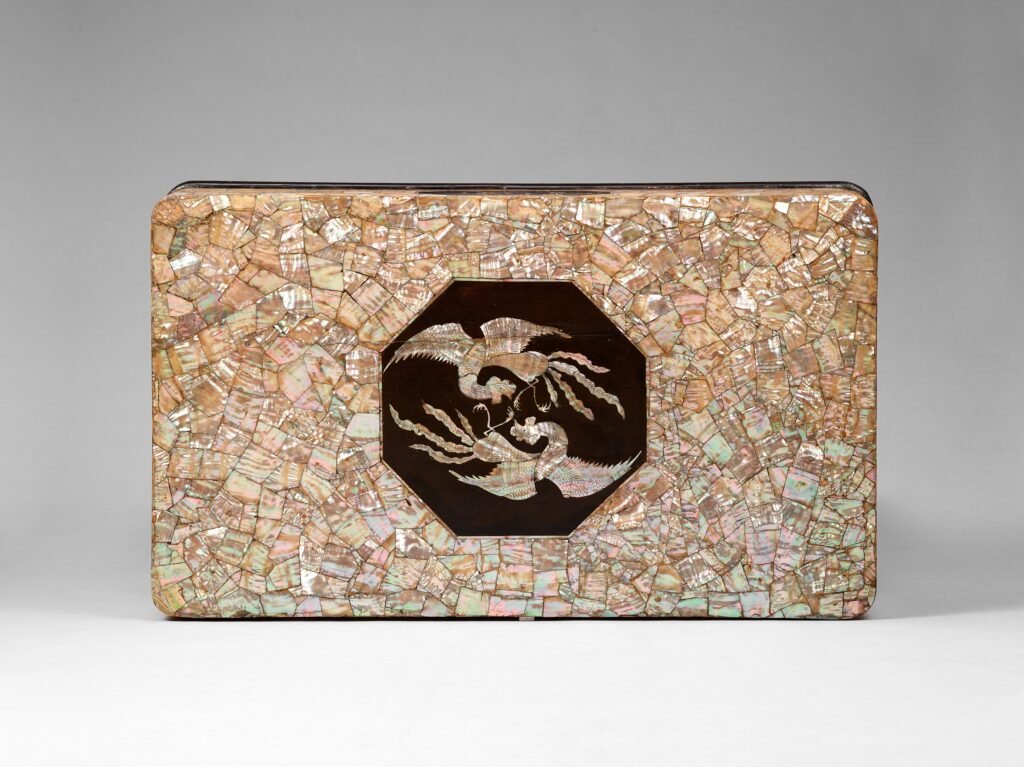
Rectangular in shape with a lid on top, these boxes were primarily used to store clothing.
Originally, it was used to store official clothes, but gradually it was used to store various clothes.
This clothes box is decorated with a phoenix pattern in an octagonal window on the top of the lid and a plum blossom pattern on the side, and the other parts are decorated with mother-of-pearl cut in large sizes and pasted on the surface without any specific pattern. Collection: Korean National Museum. (3 photos)

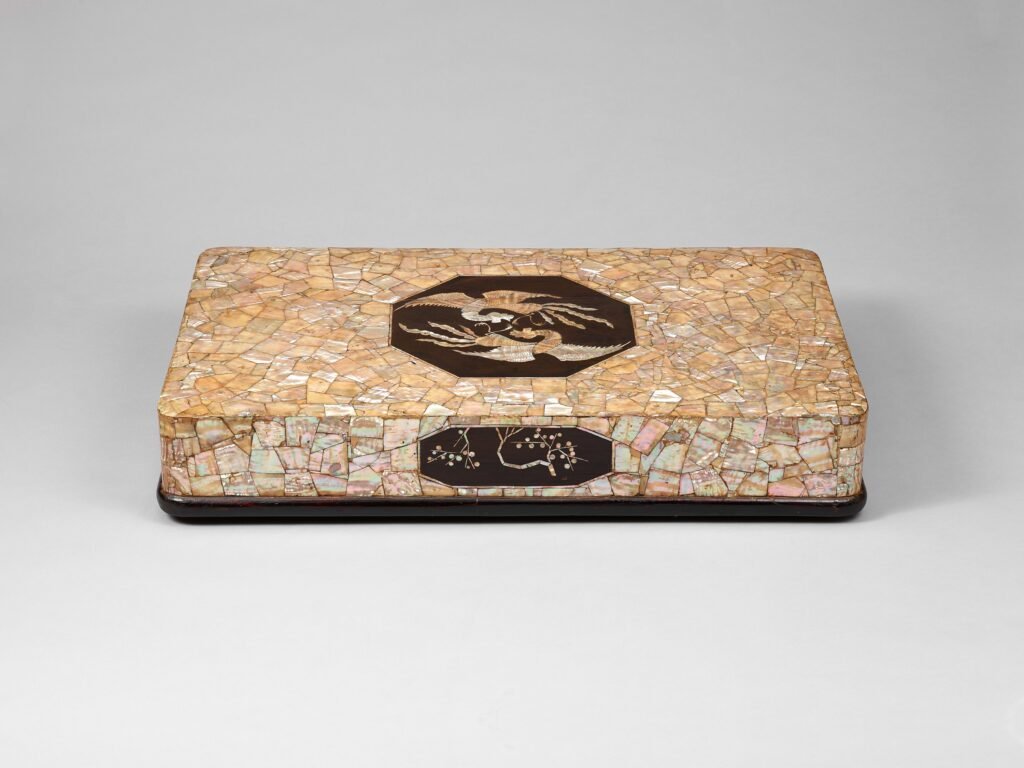

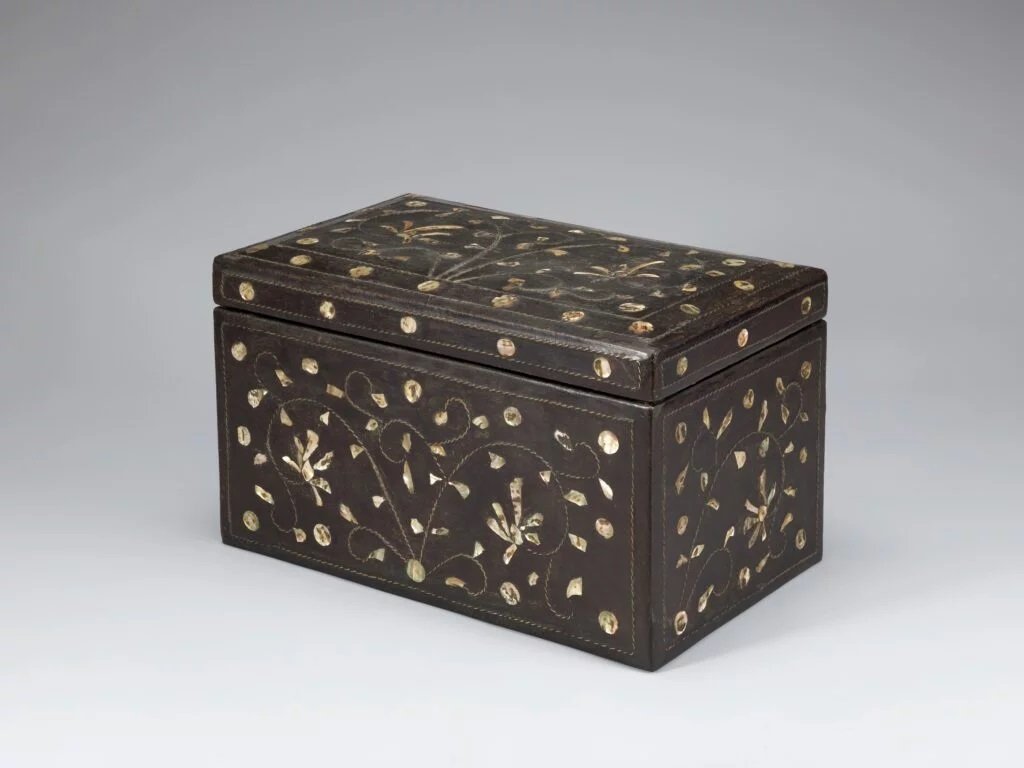
Collection National Museum of Korea.
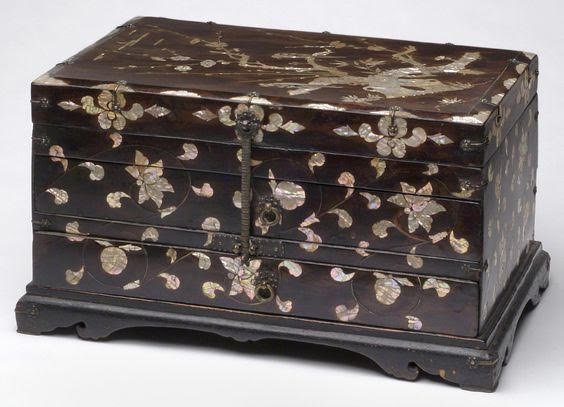
brass fittings
H. 24,1cm, W. 43,2cm, D. 29,8 cm .
Collection The Philadelphia Museum.


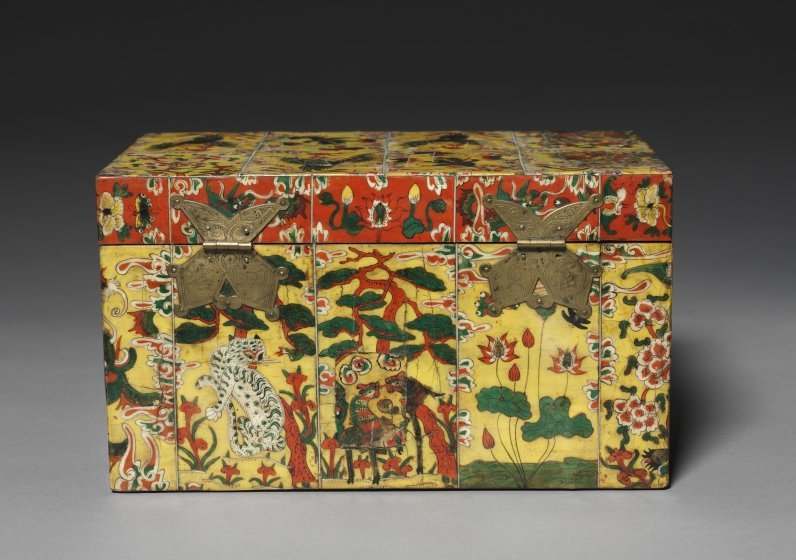
Cleveland Museum of art Korean collection
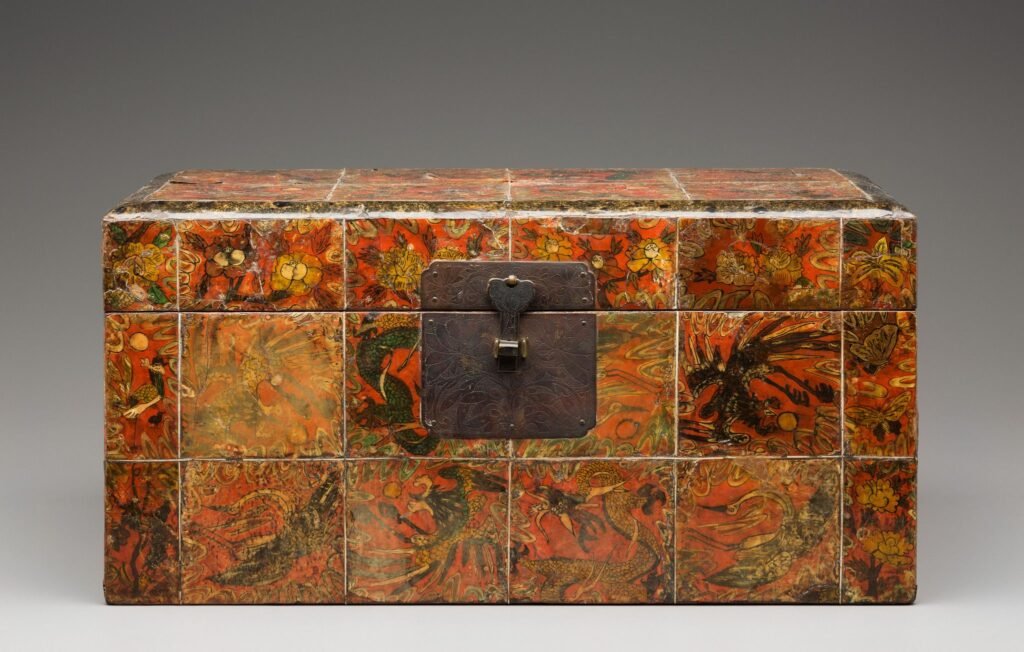
Ink and paint on ox horn panels on wood, ray skin, and metal.
DETROIT INSTITUTE OF ART MUSEUM, USA

This is a lidded case for storing documents in the form of a scroll. The top surface of the lid is decorated with a pair of cranes and heavenly peaches. The façade of the body is inlaid with pine, crane, bamboo, and phoenix designs, and the back is inlaid with plum blossoms and birds. The designs on this case were often found in the lacquerware of the Joseon period that is decorated with ten longevity symbols with mother-of-pearl inlay.
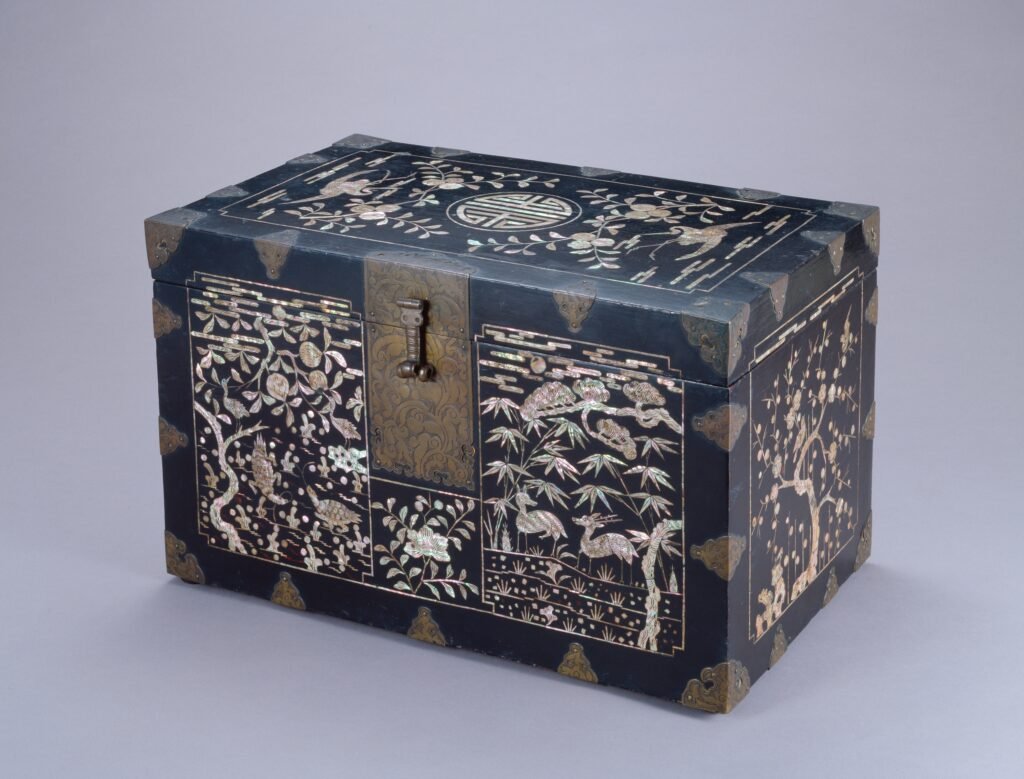
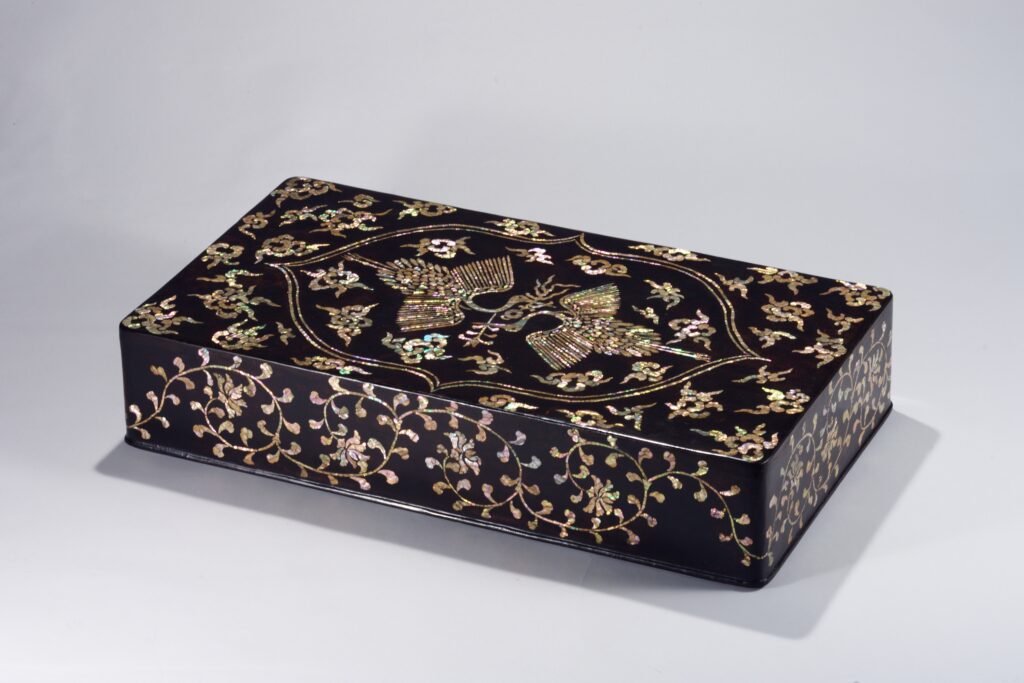
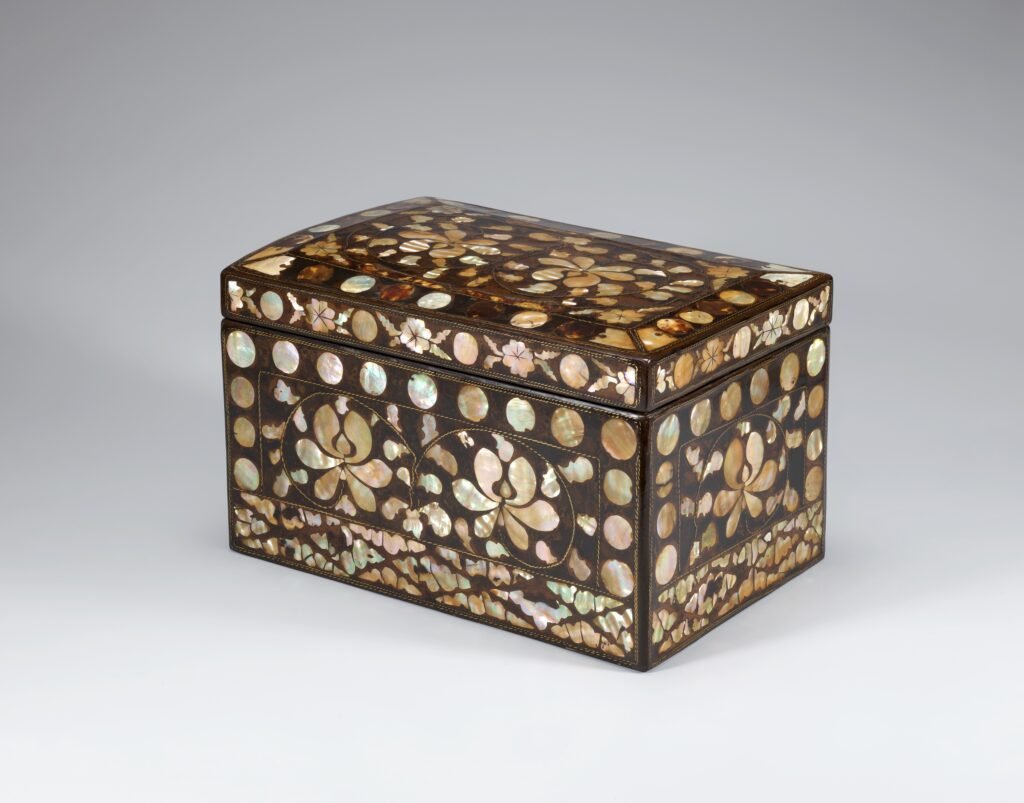
H. 21,2cm, W. 20,5cm, D. 31,8cm.
Collection National Museum of Korea.
Round box with mother-of-pearl decoration. (Photo right)
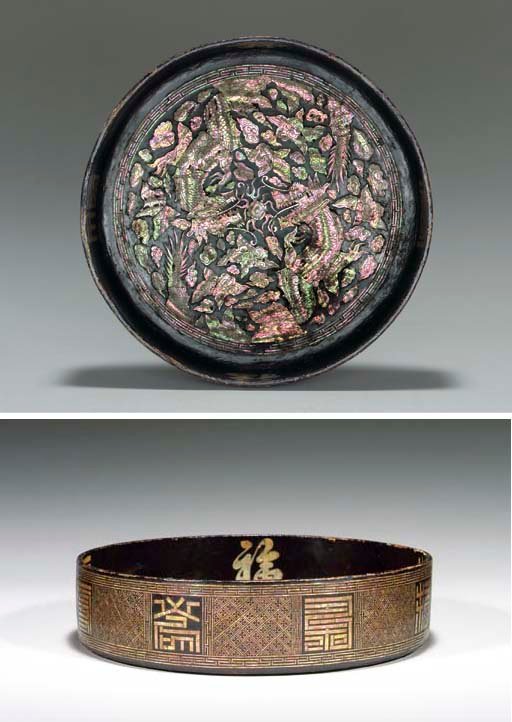

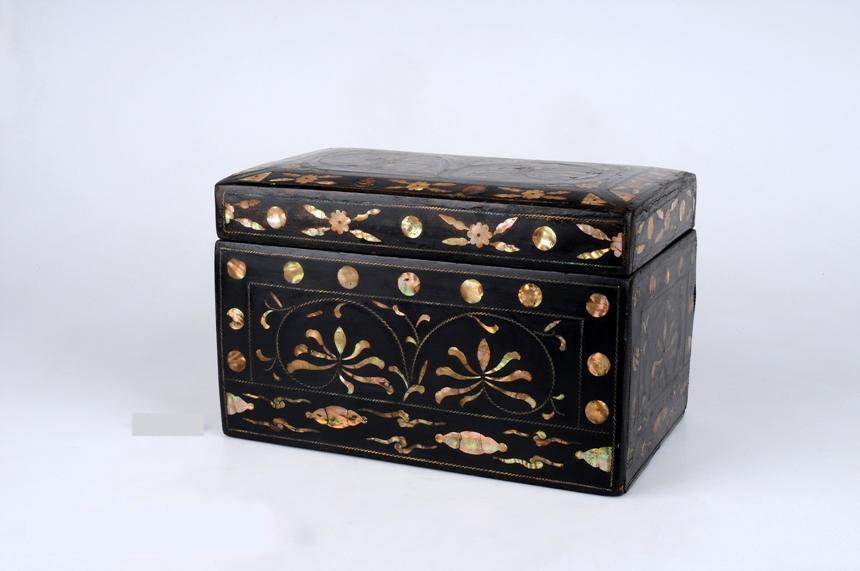
H. 20cm, W. 32cm, D. 18cm.
Collection: National Daegu Museum, Korea.
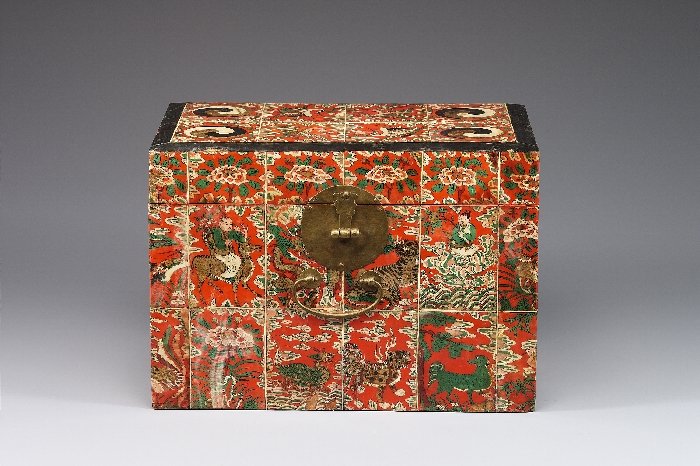
Joseon Dynasty. H. 24,3cm, 34,1cm x 21,8cm.
Collection The National Museum of Korea.
Hwagak (華角) refers to a unique type of craftwork made with ox horns that have been cut and flattened into thin, translucent sheets. One side of these sheets would be painted with patterns or images, and then the painted side was attached to a wooden surface as decoration. Since ox horns are usually rather small, dozens of them were required to fully decorate even a small wooden object. Thus, hwagak crafts are known to be very complicated and difficult to produce. However, because of their vibrant, colorful decorative effect, hwagak products were quite popular, especially among women. This box is decorated with an array of plants and animals, including peonies, cranes, tigers, deer, turtles, and carp, as well as images of the Immortal Child (童子), who can be seen riding some of the animals against the bright red backdrop. The theme of the Immortal Child sitting astride an animal comes from Taoism, and was a common trope of hwagak. The top of the lid has a black border, and there is a taegeuk (yin-yang symbol) in each of the four corners. Arch-shaped iron handles are attached to the front and back of the box.
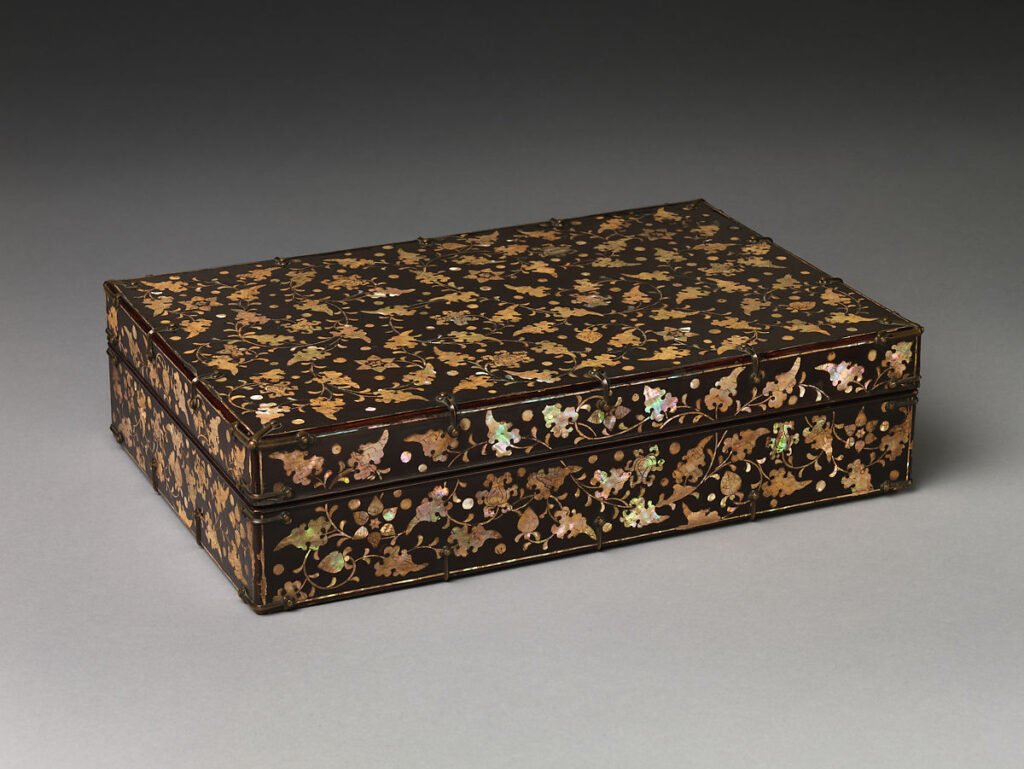
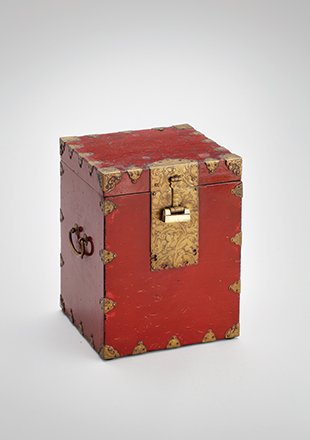

Christie’s Images, Ltd.

